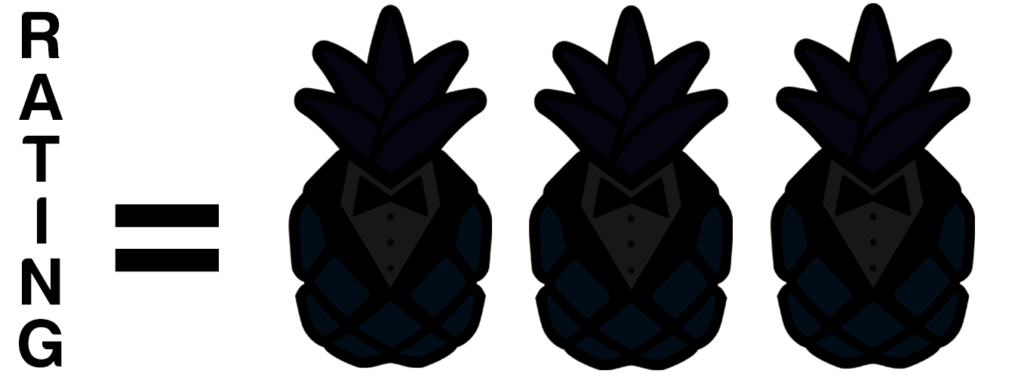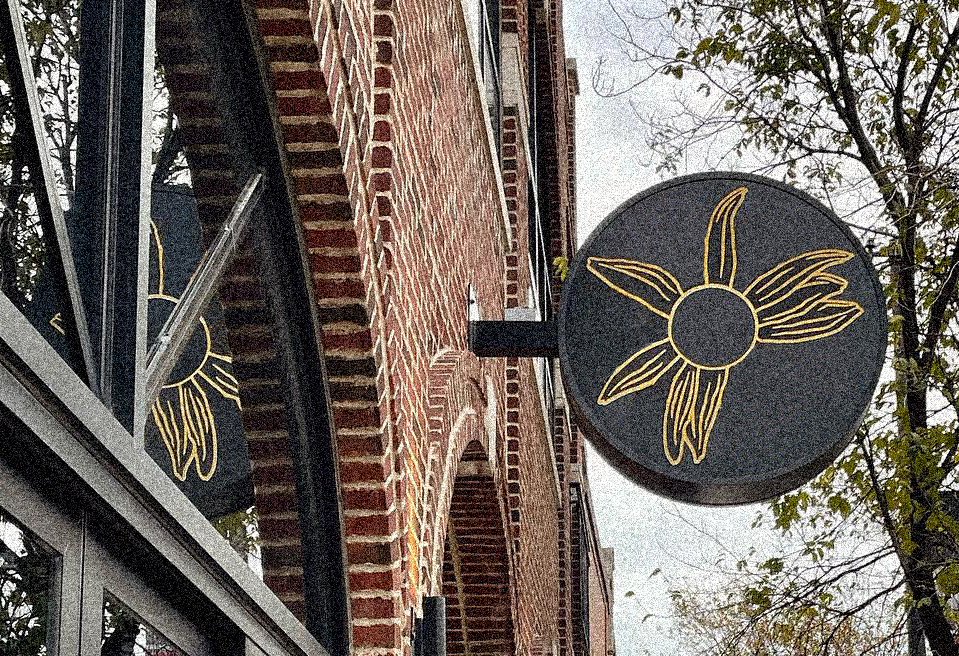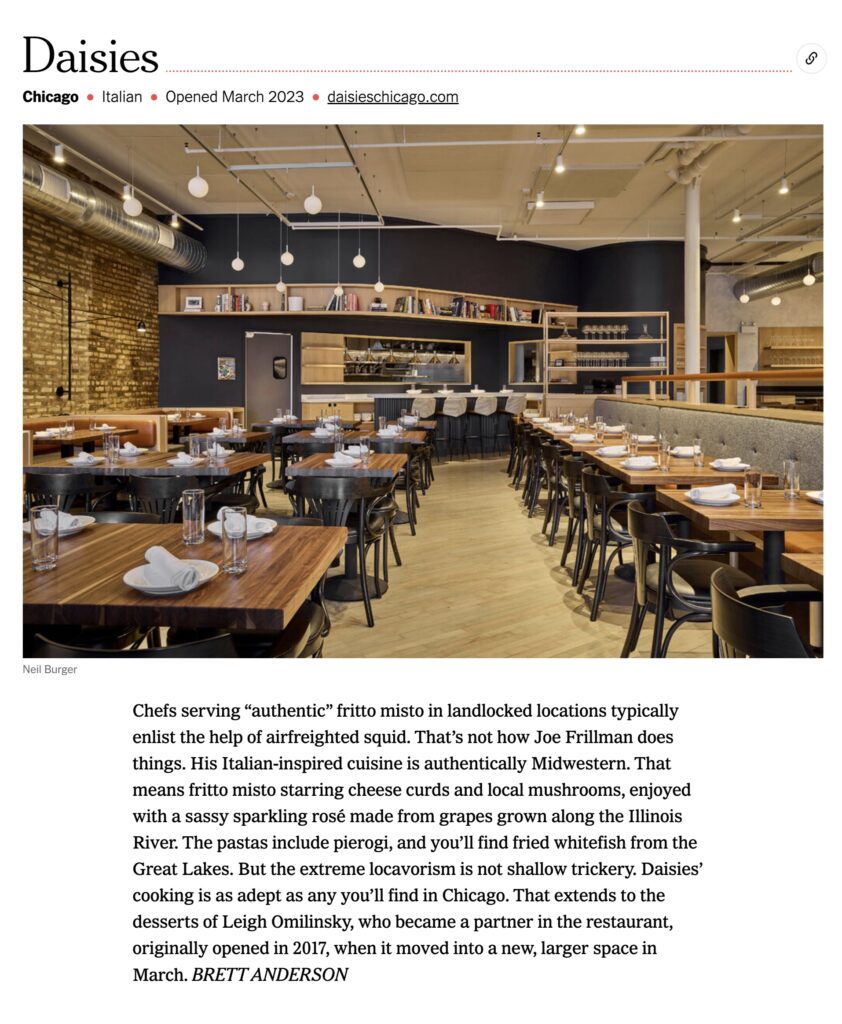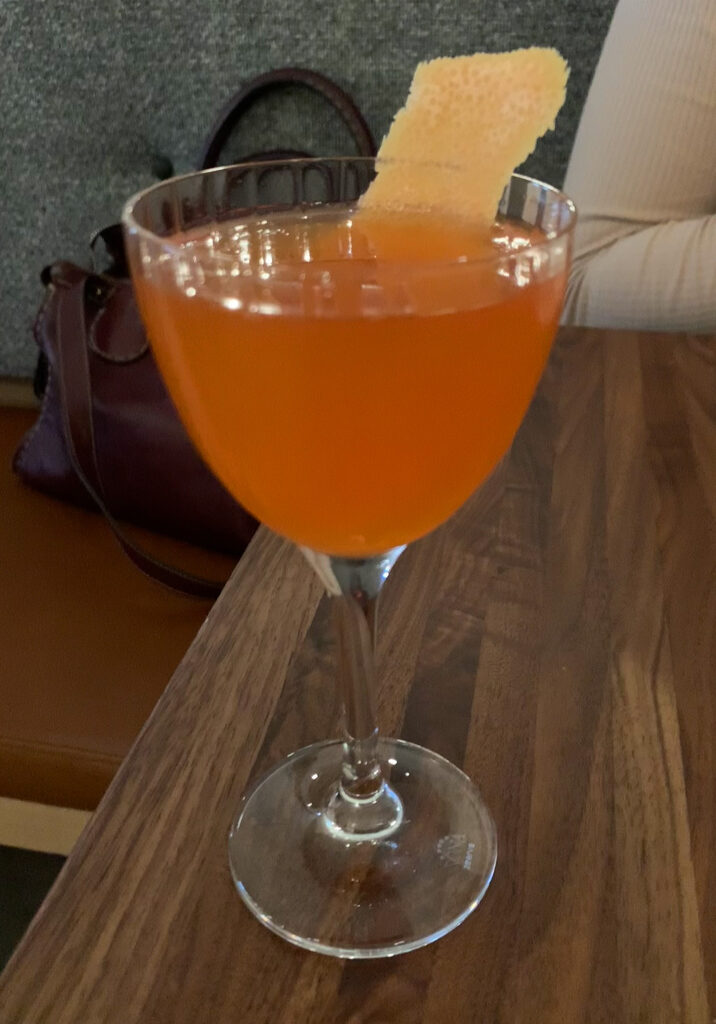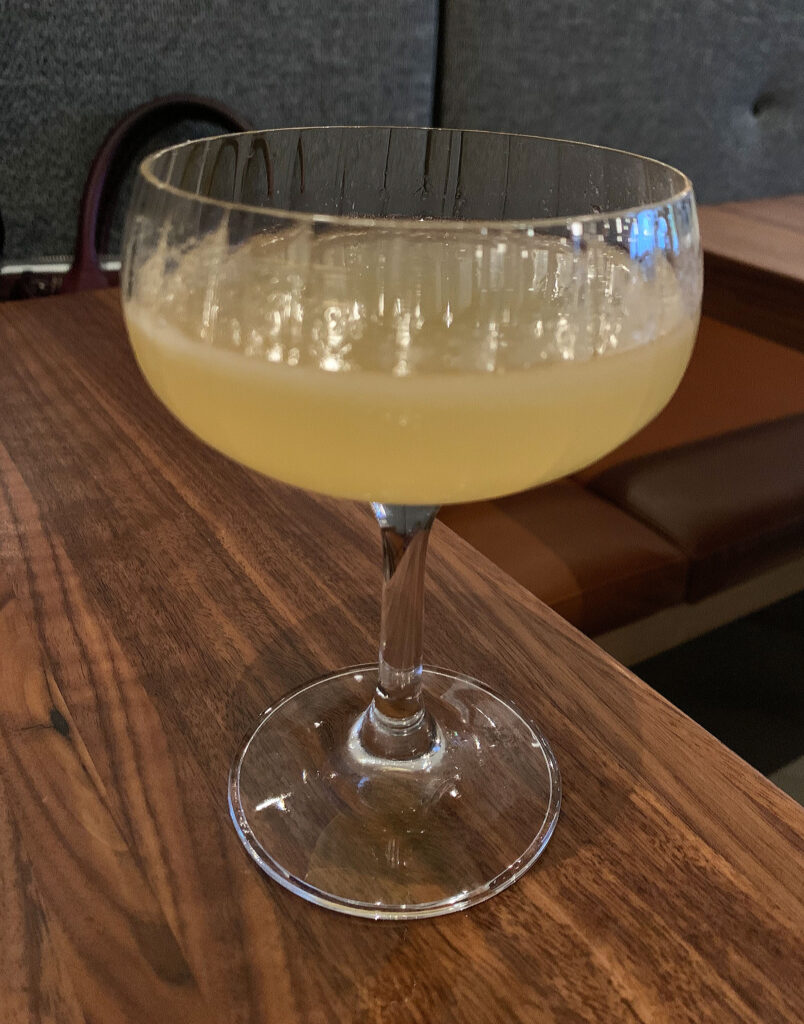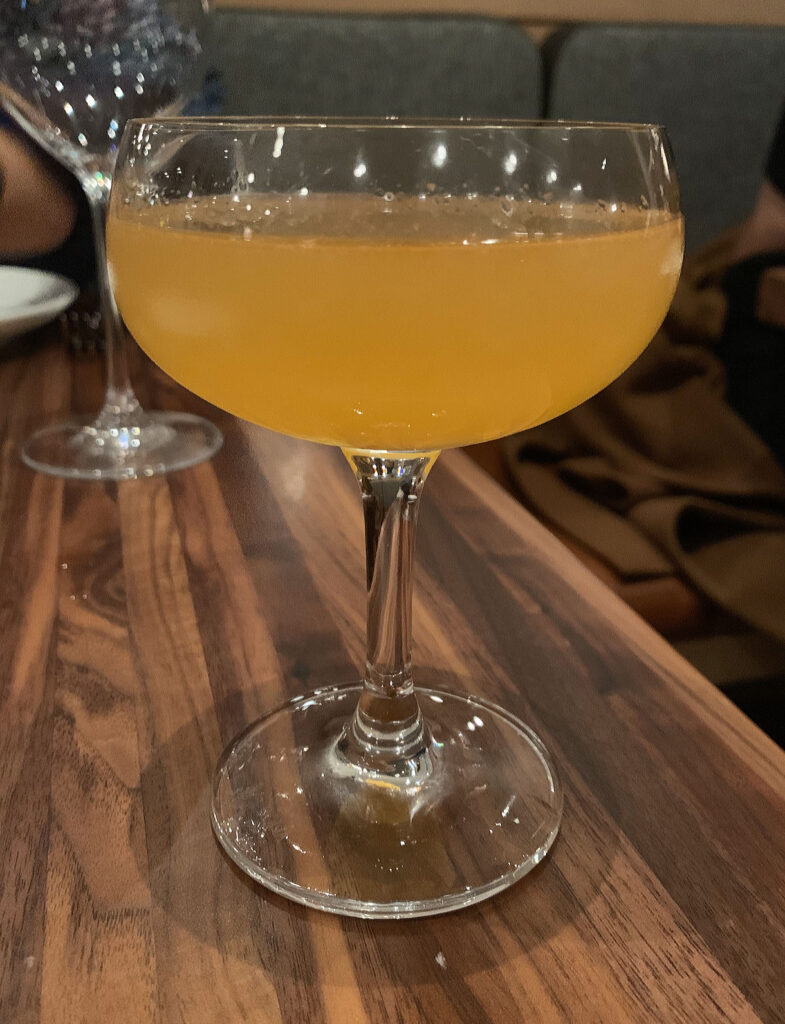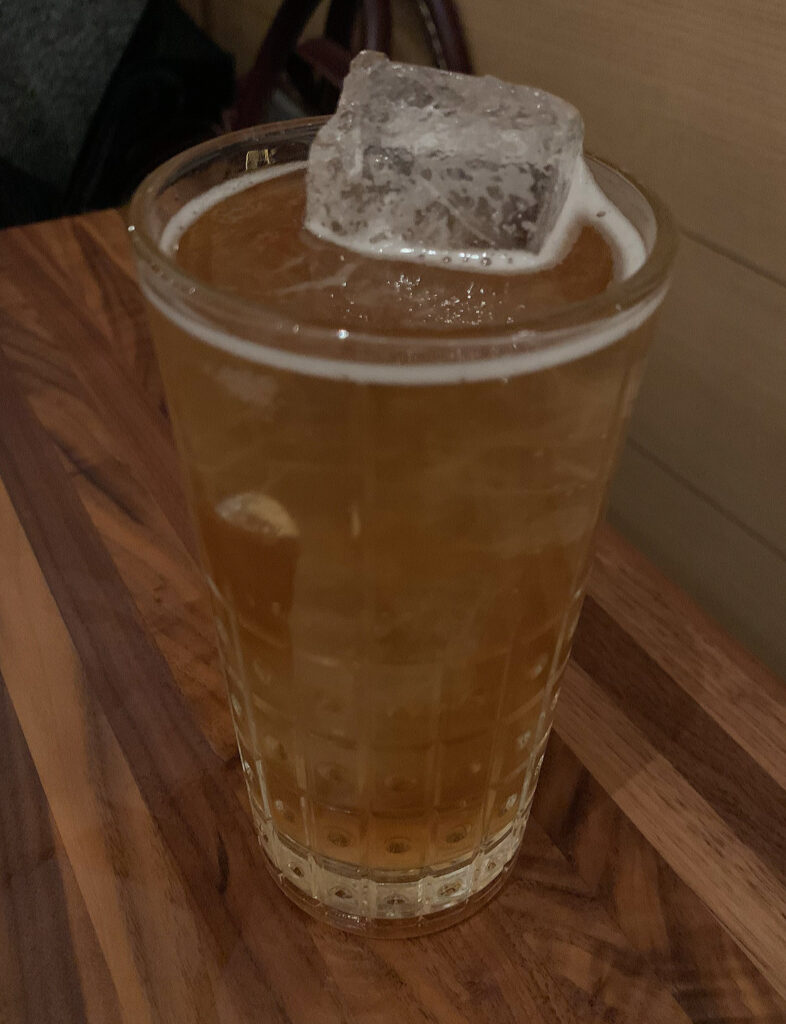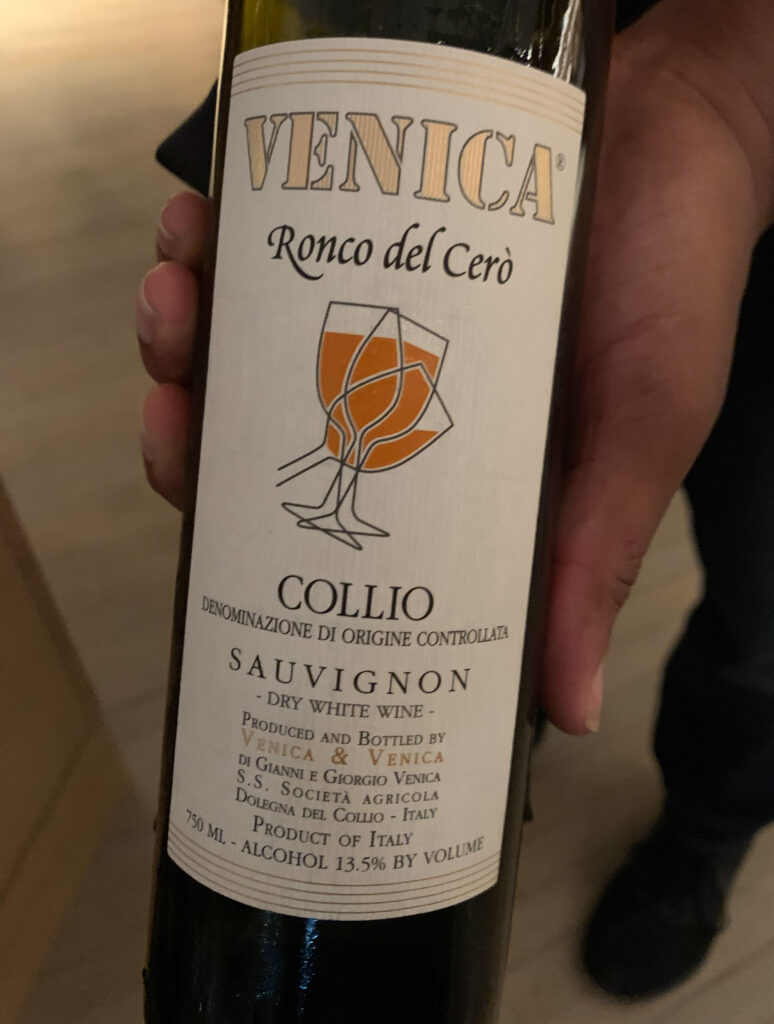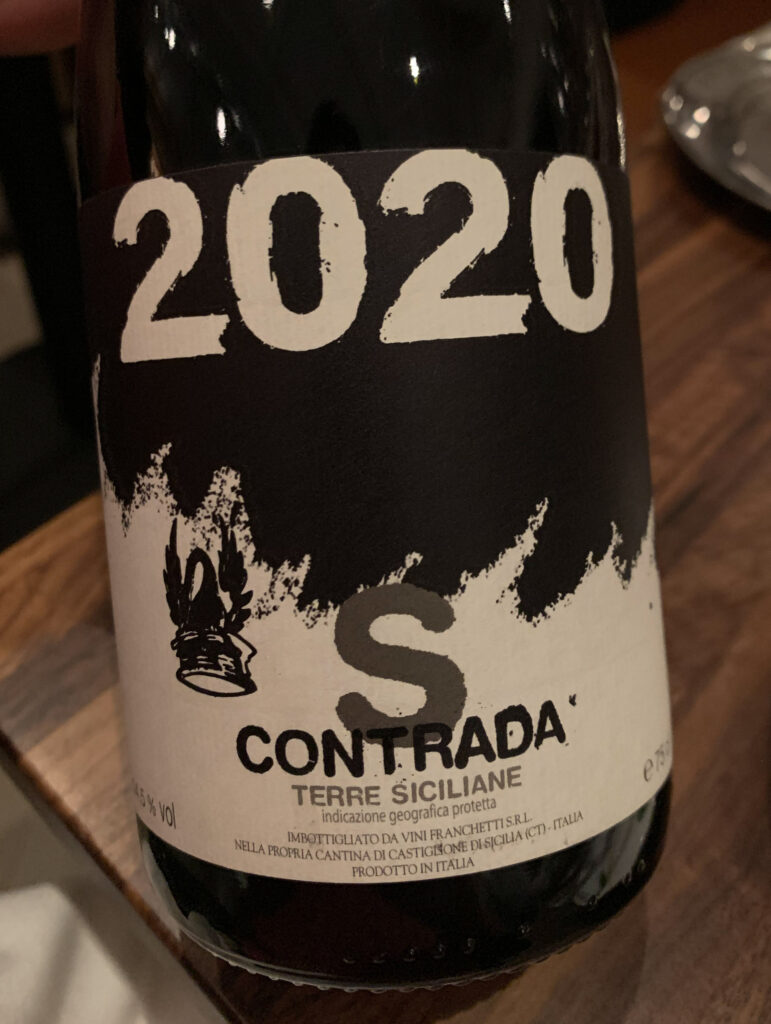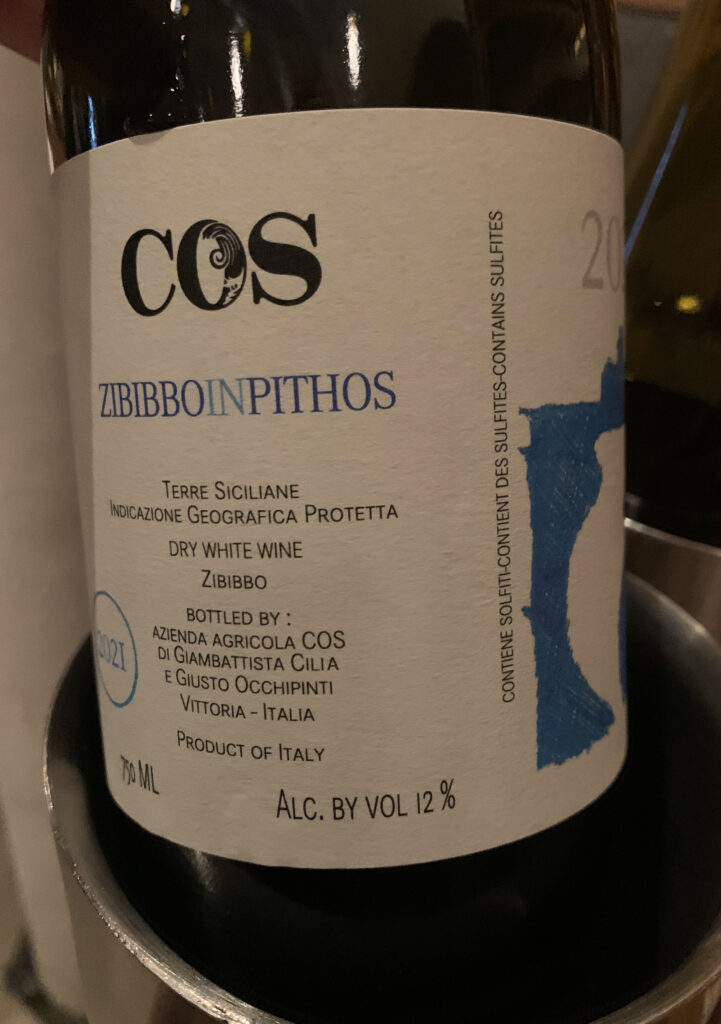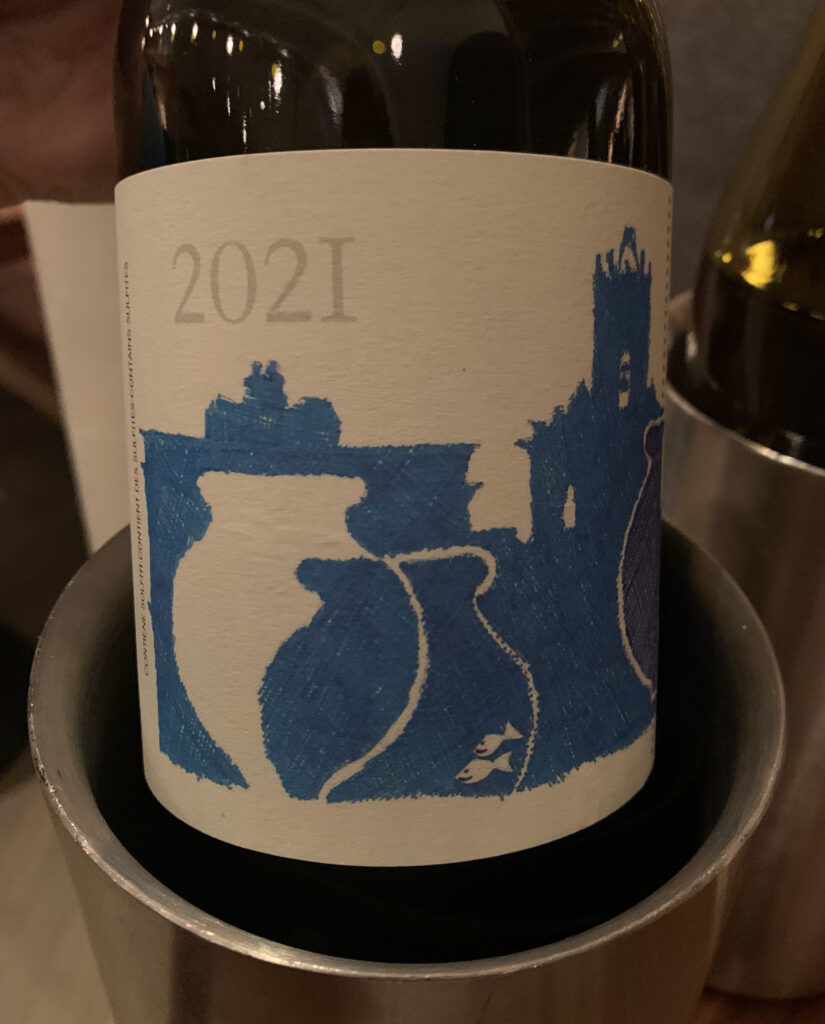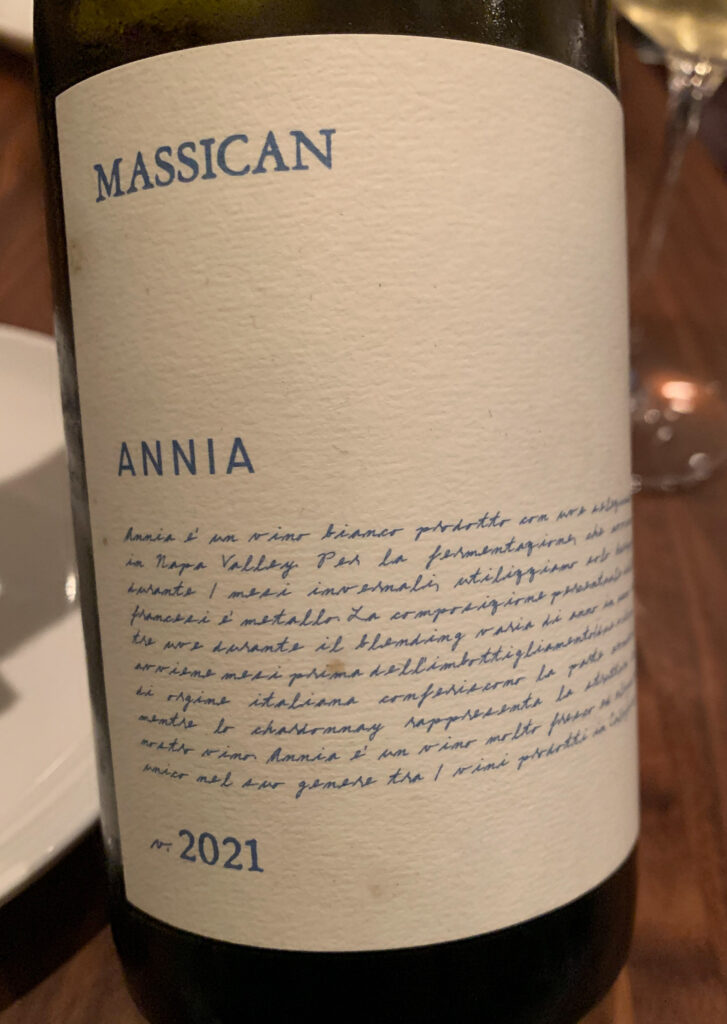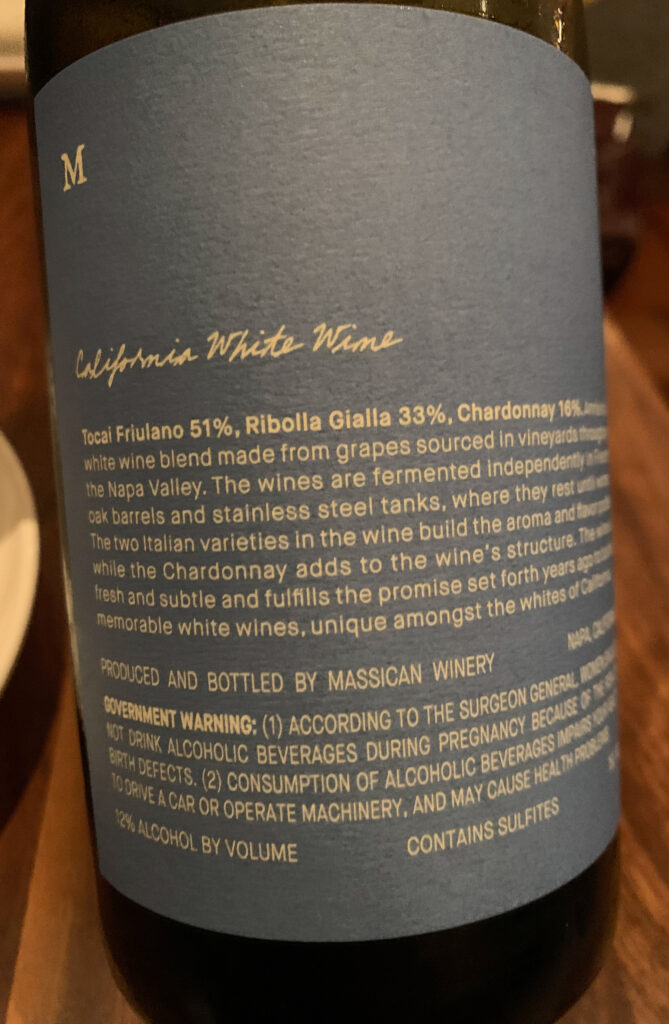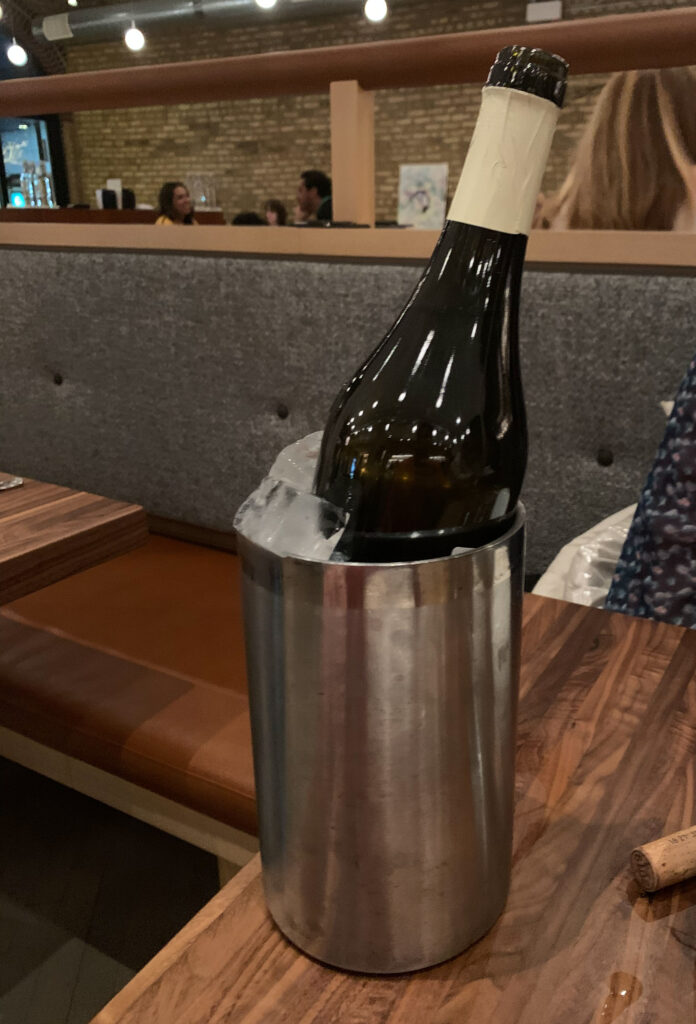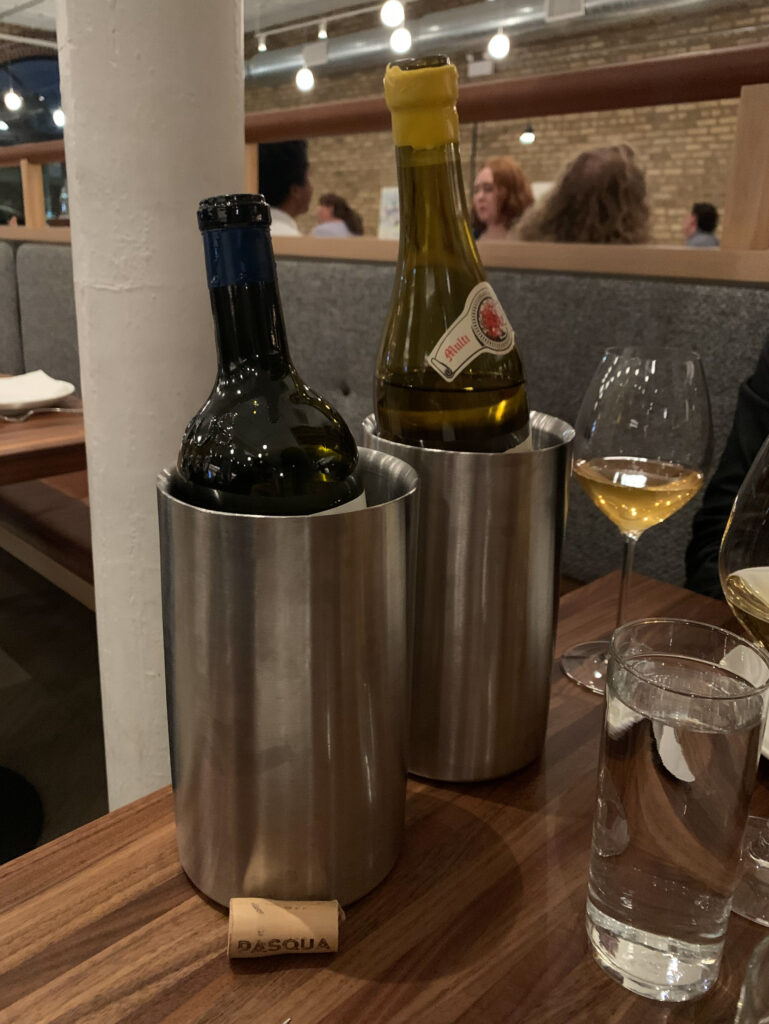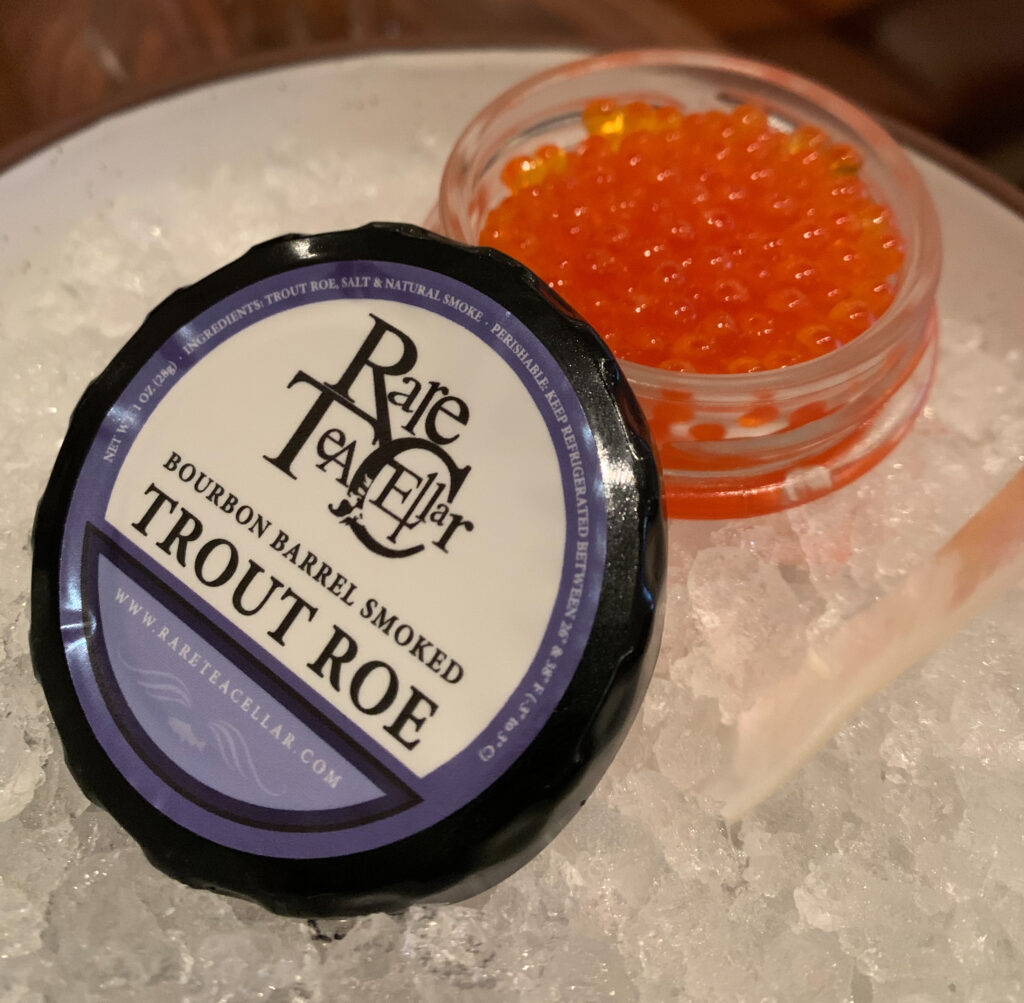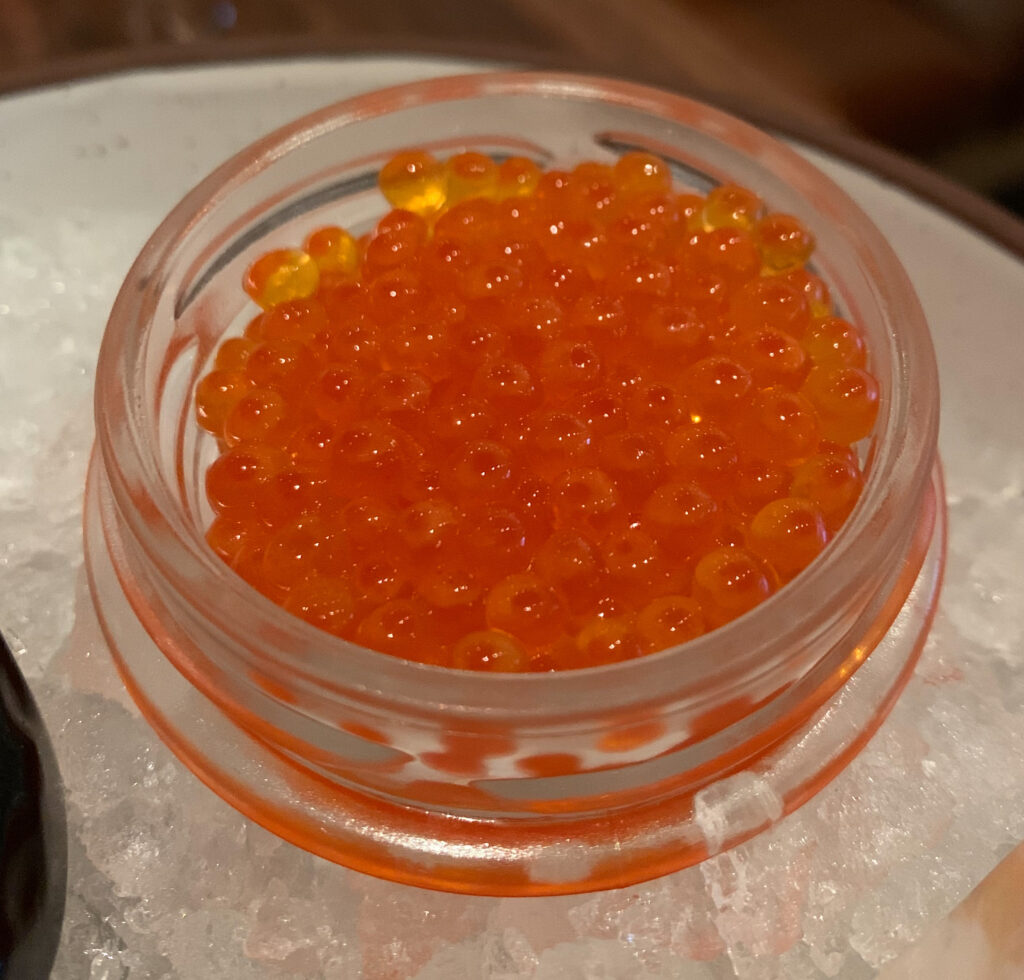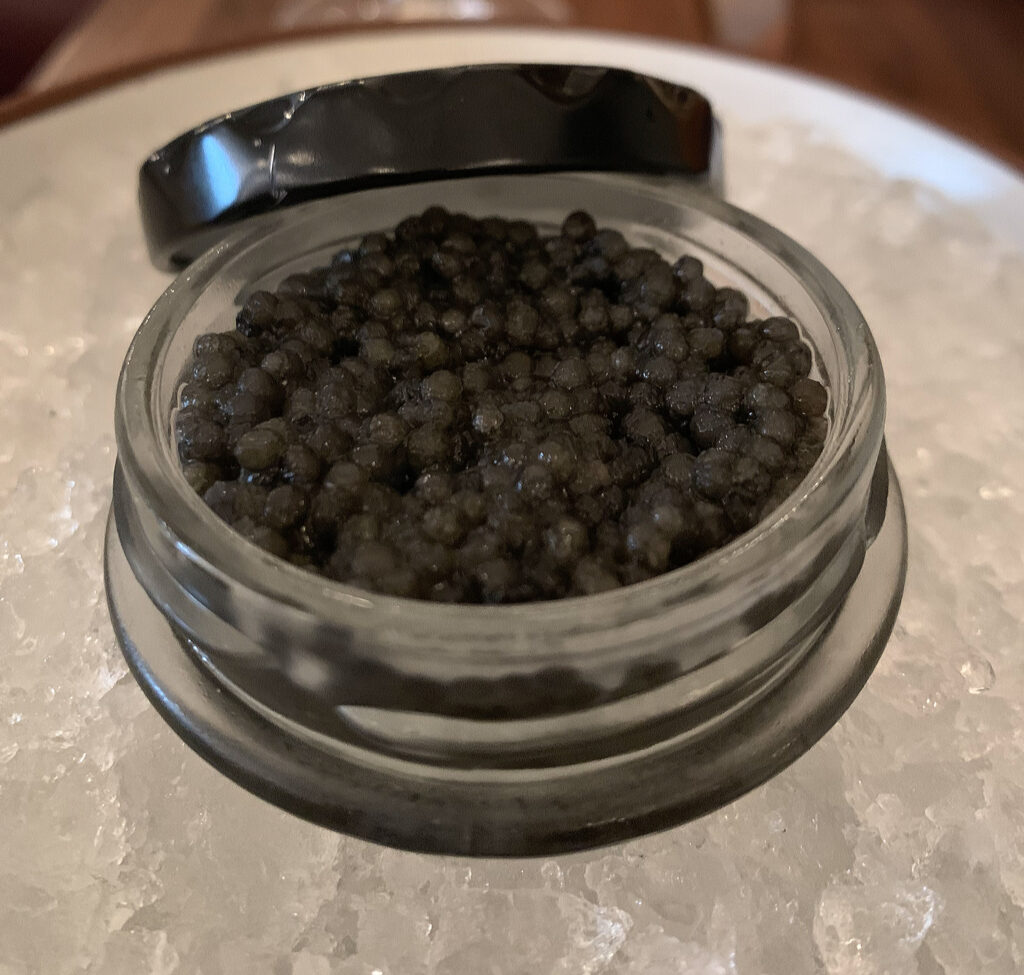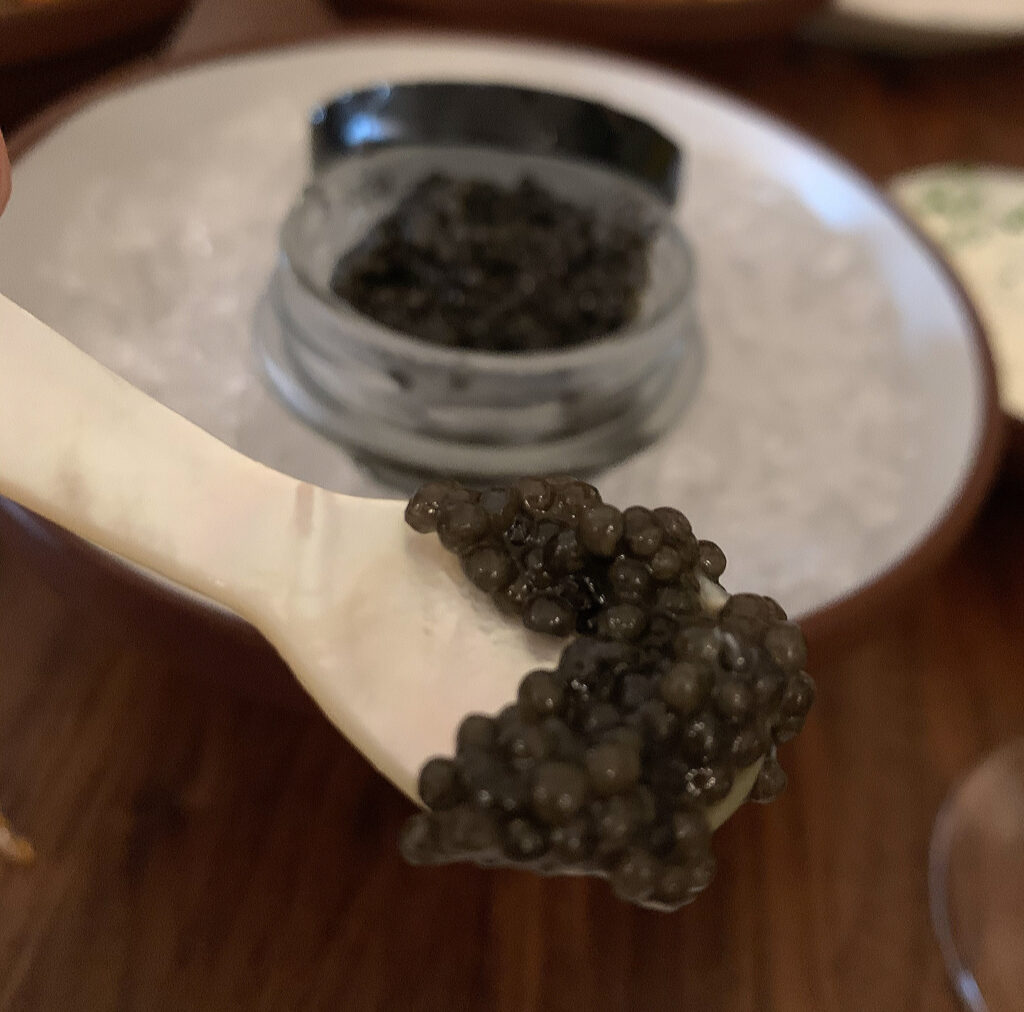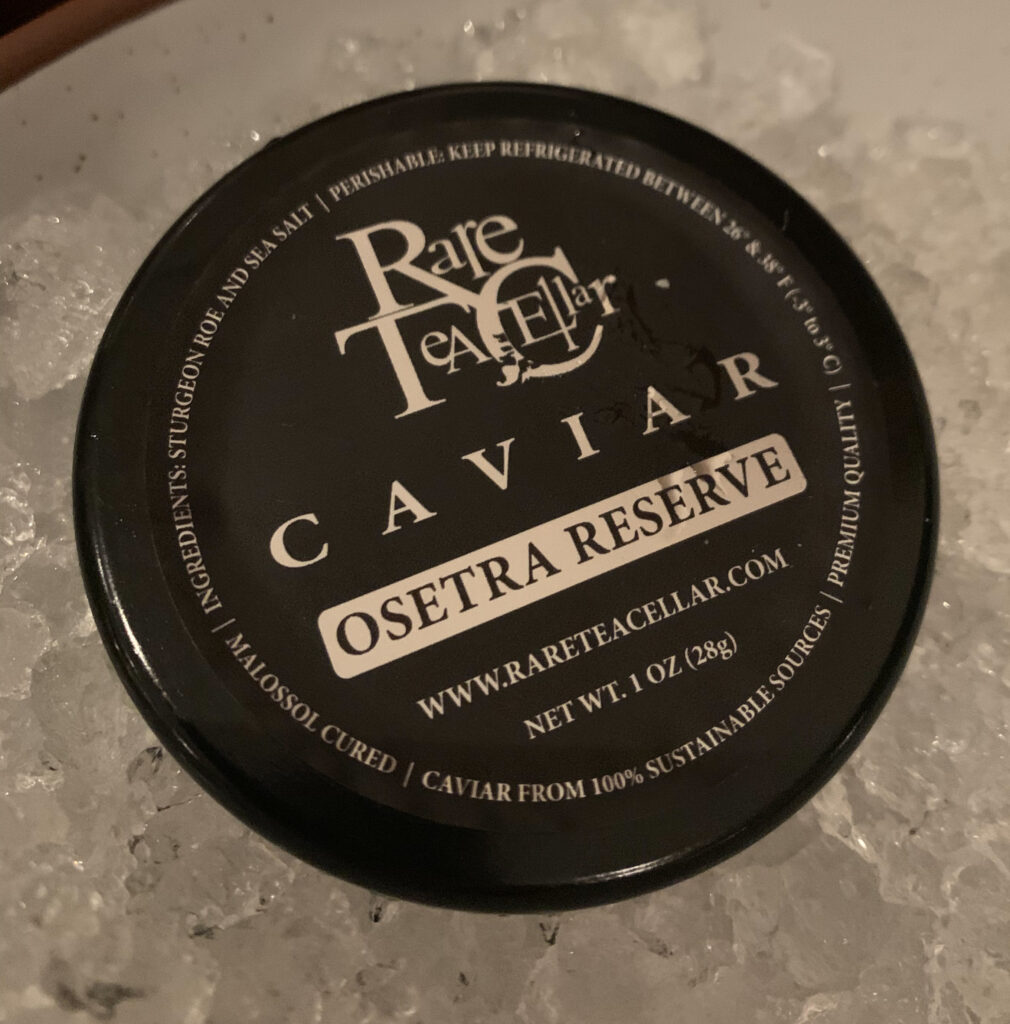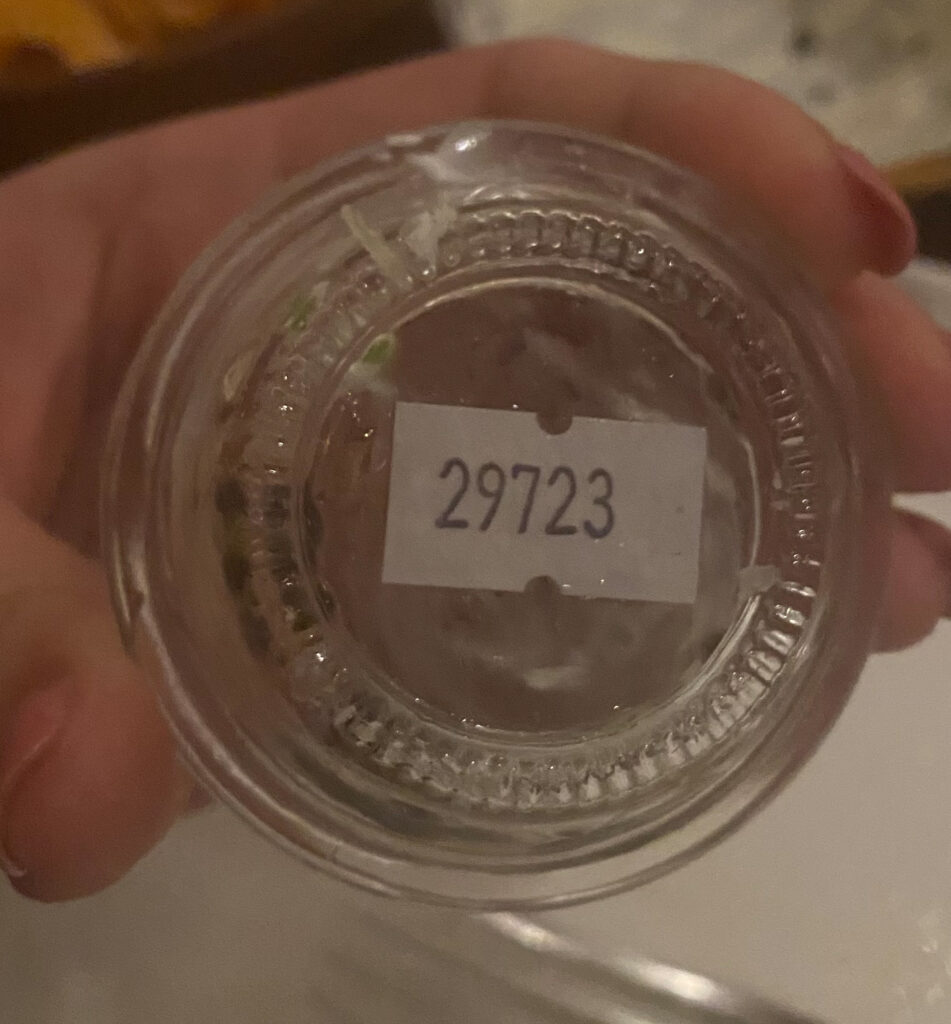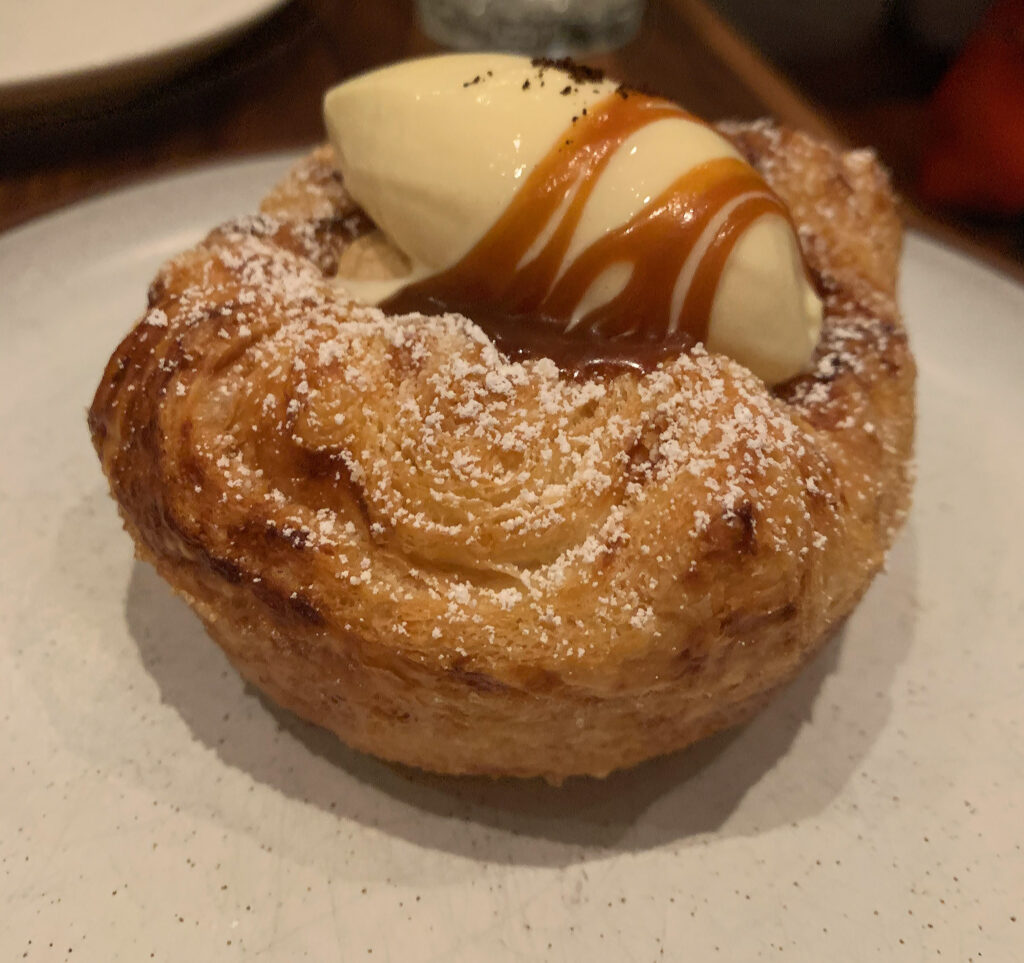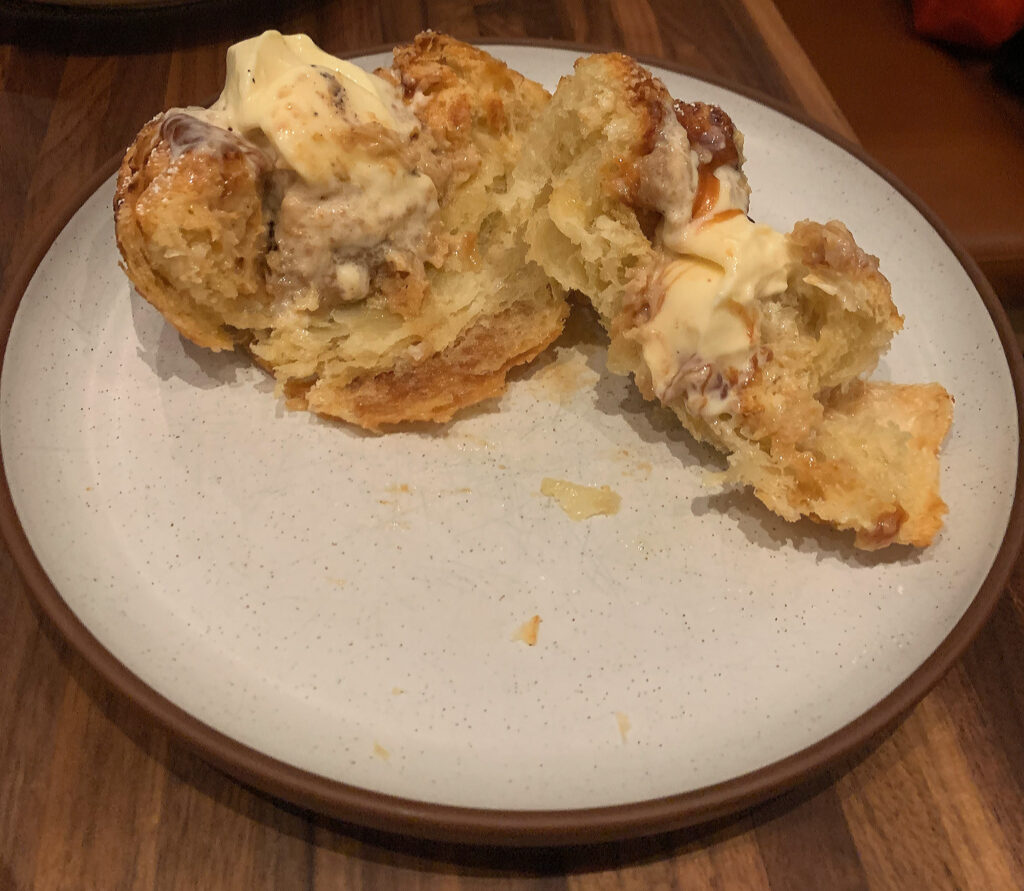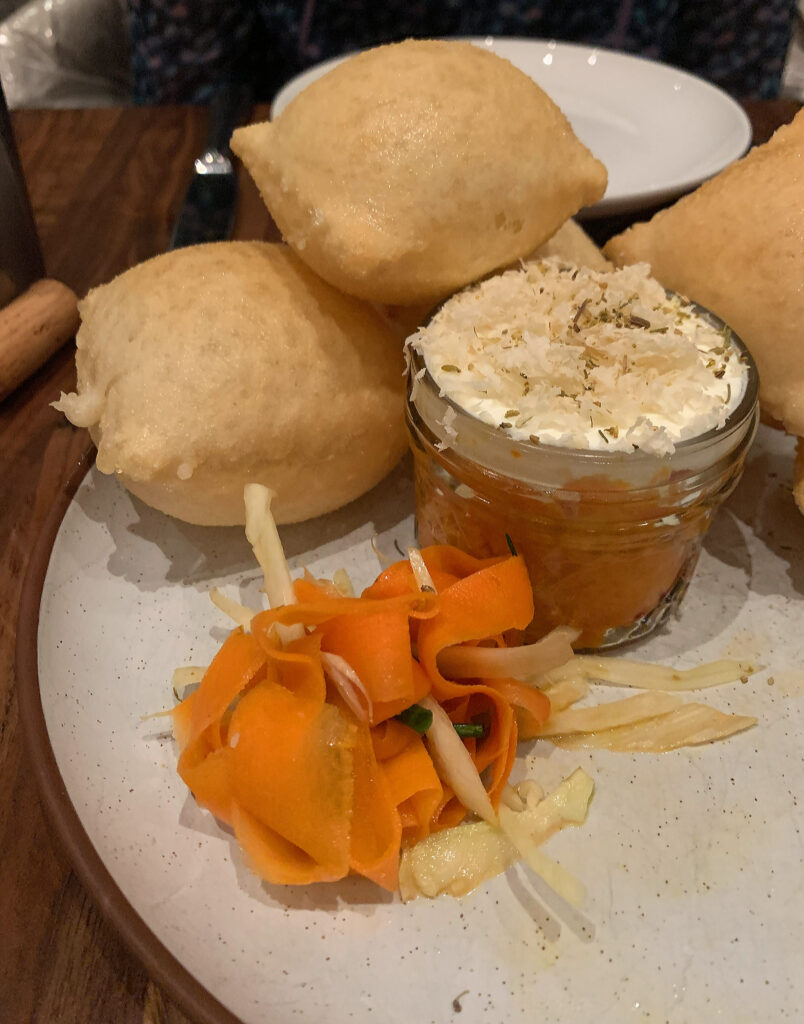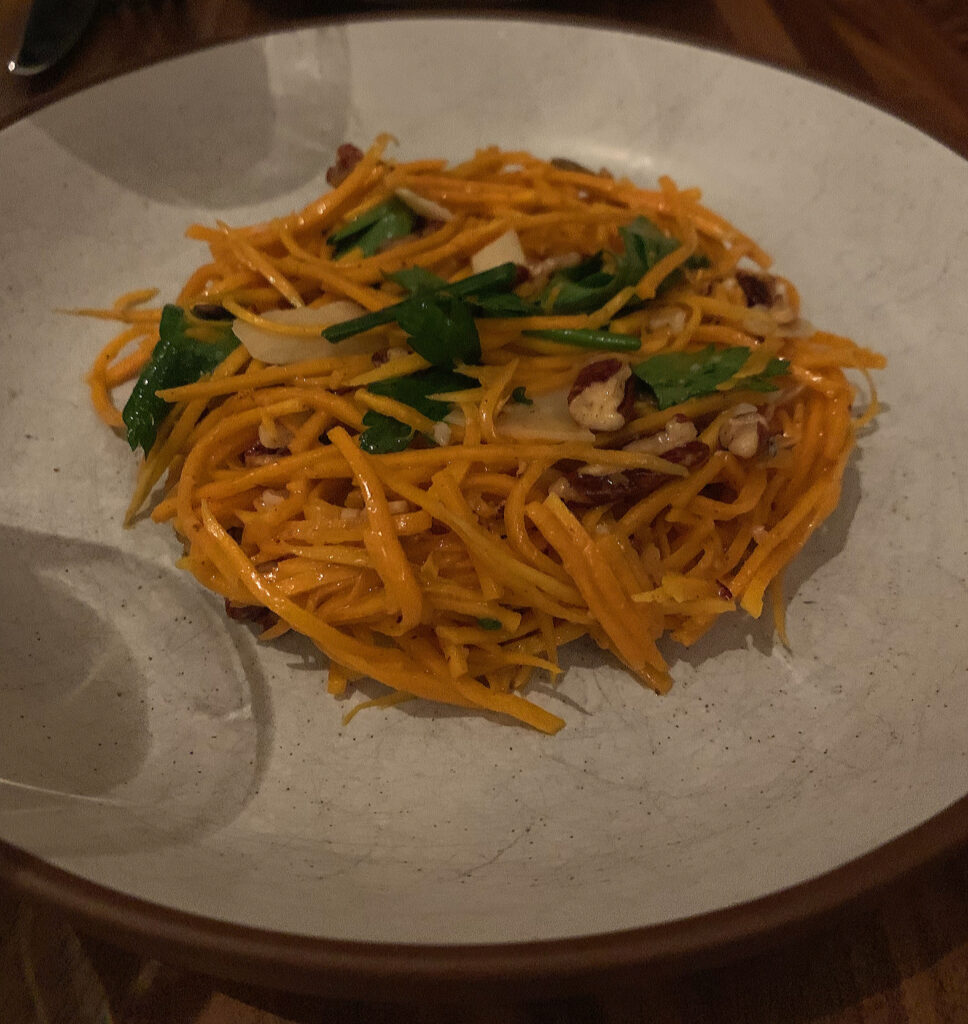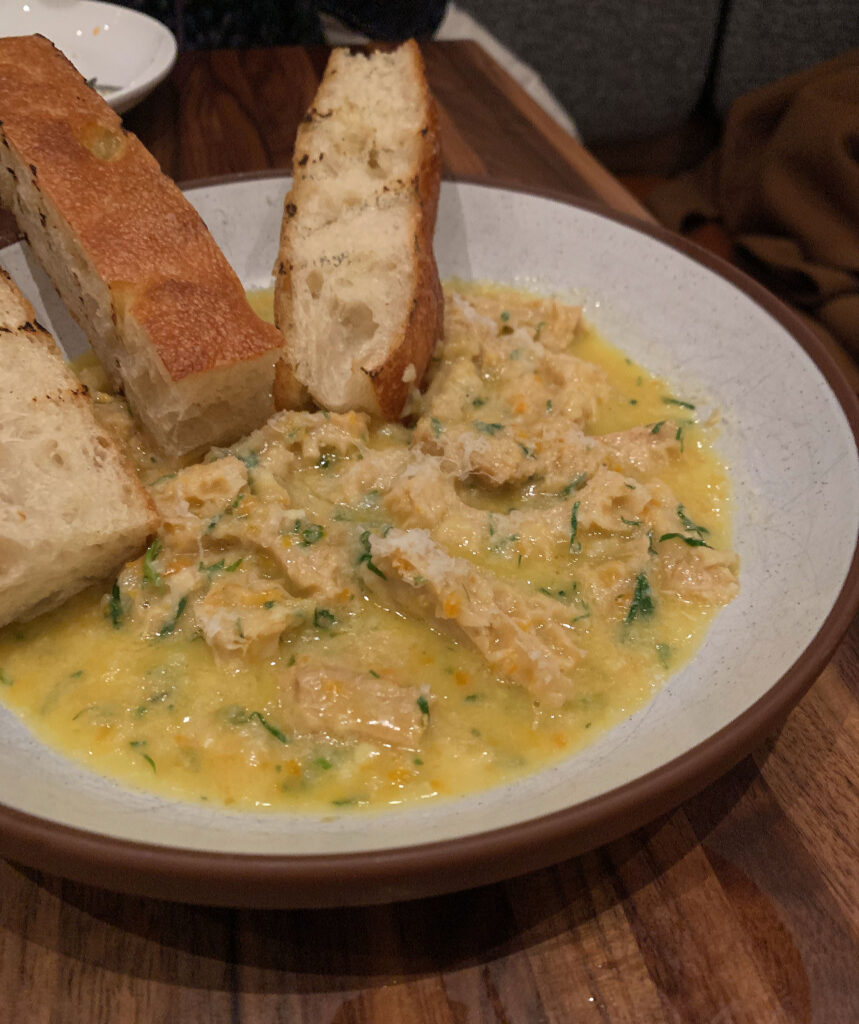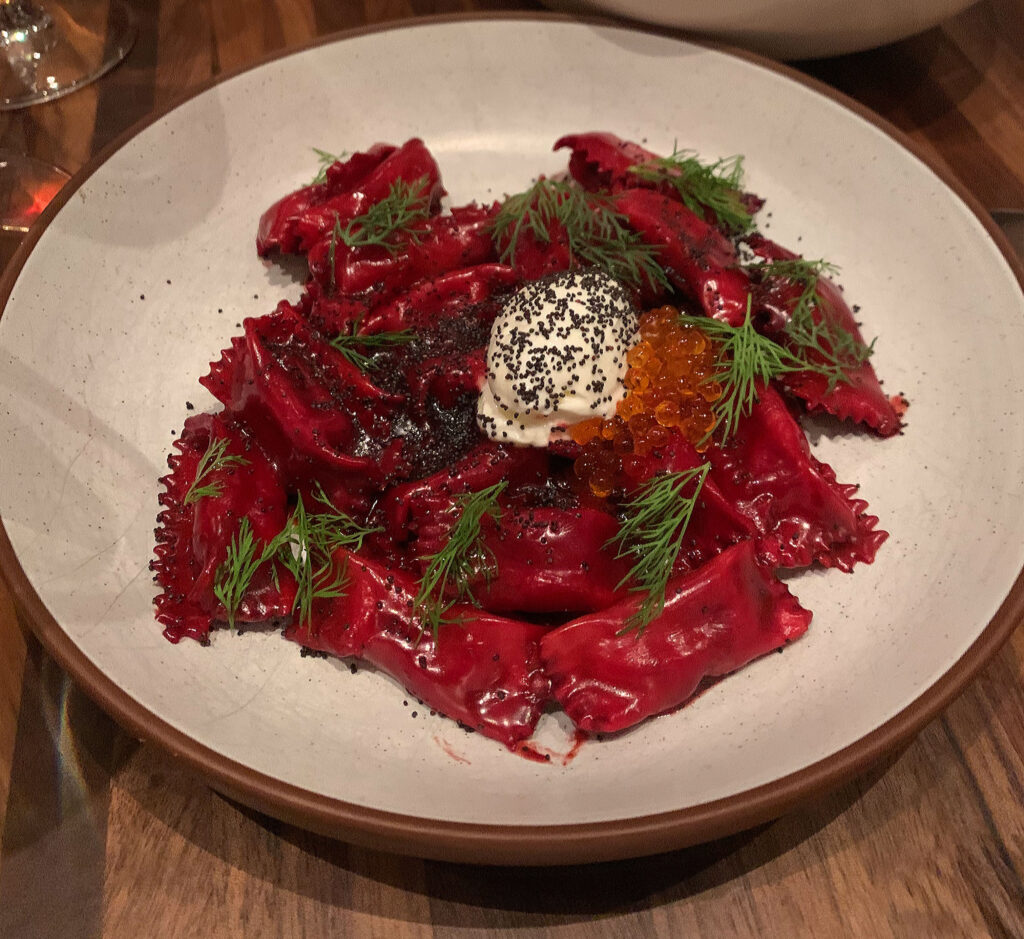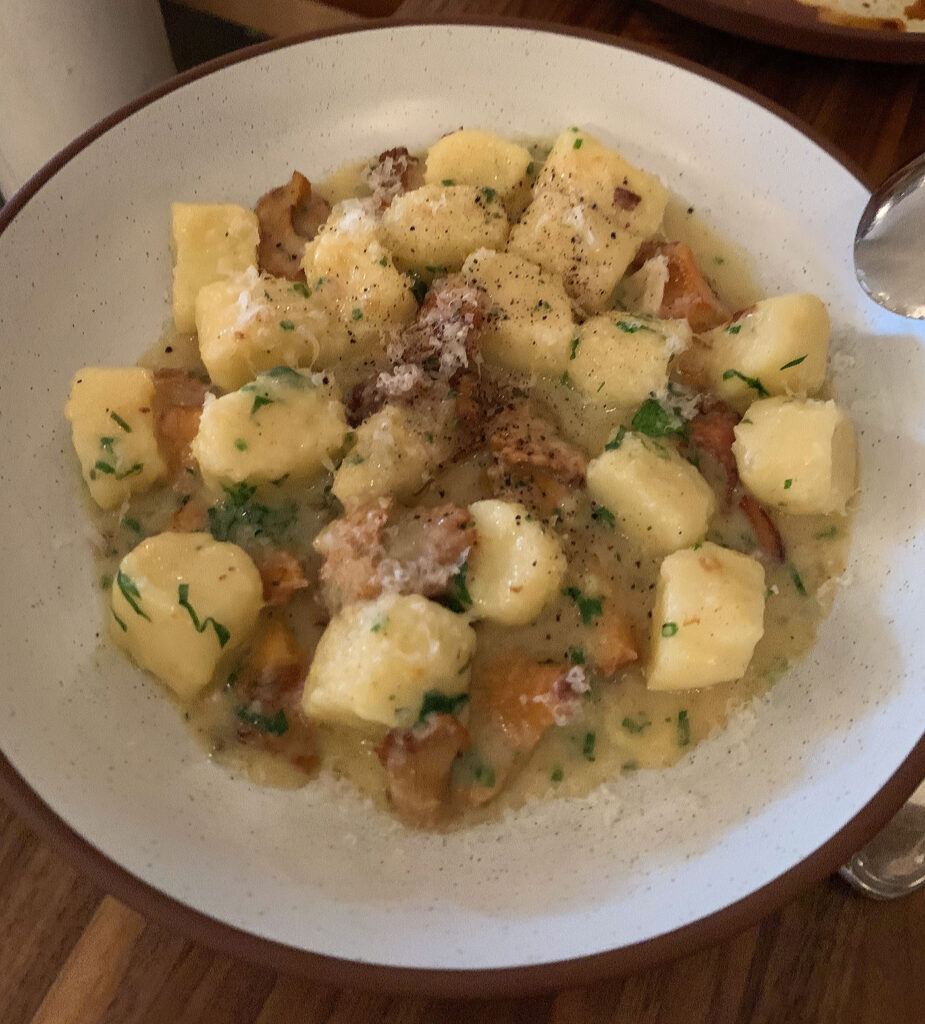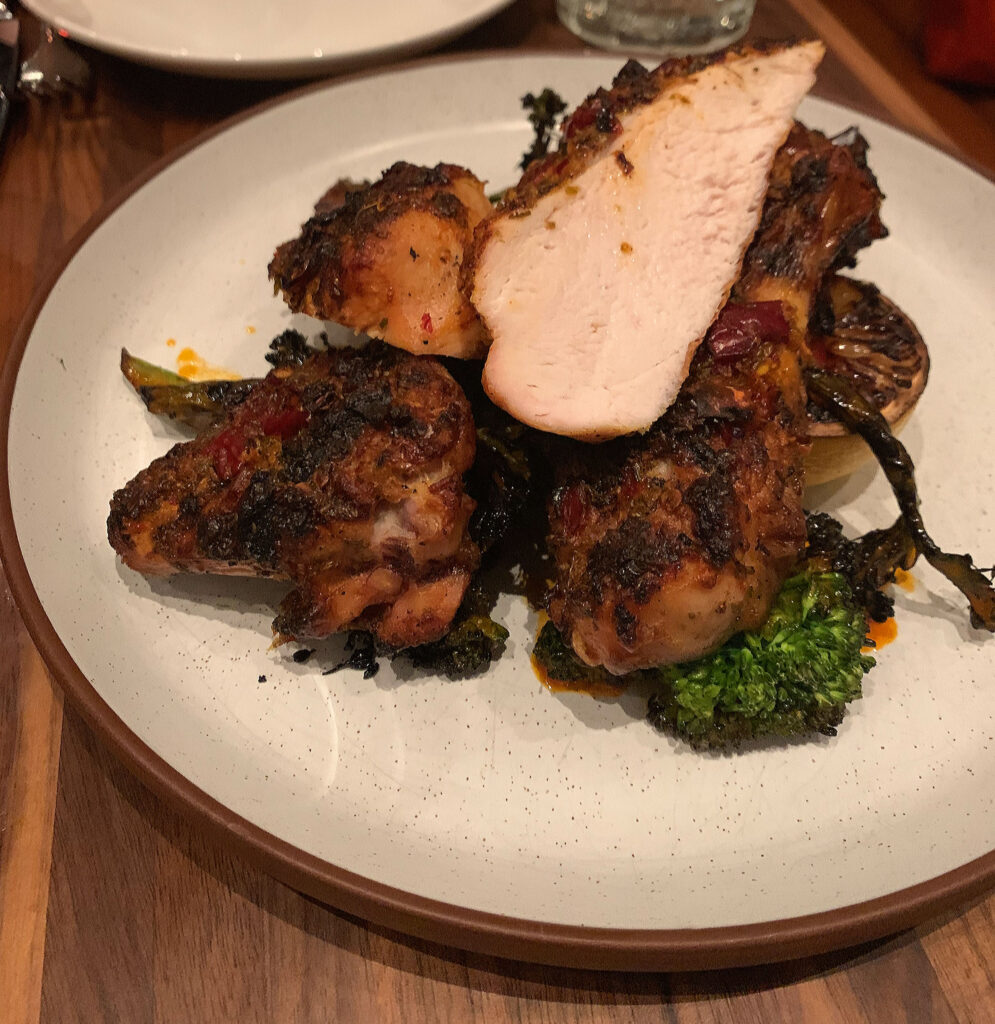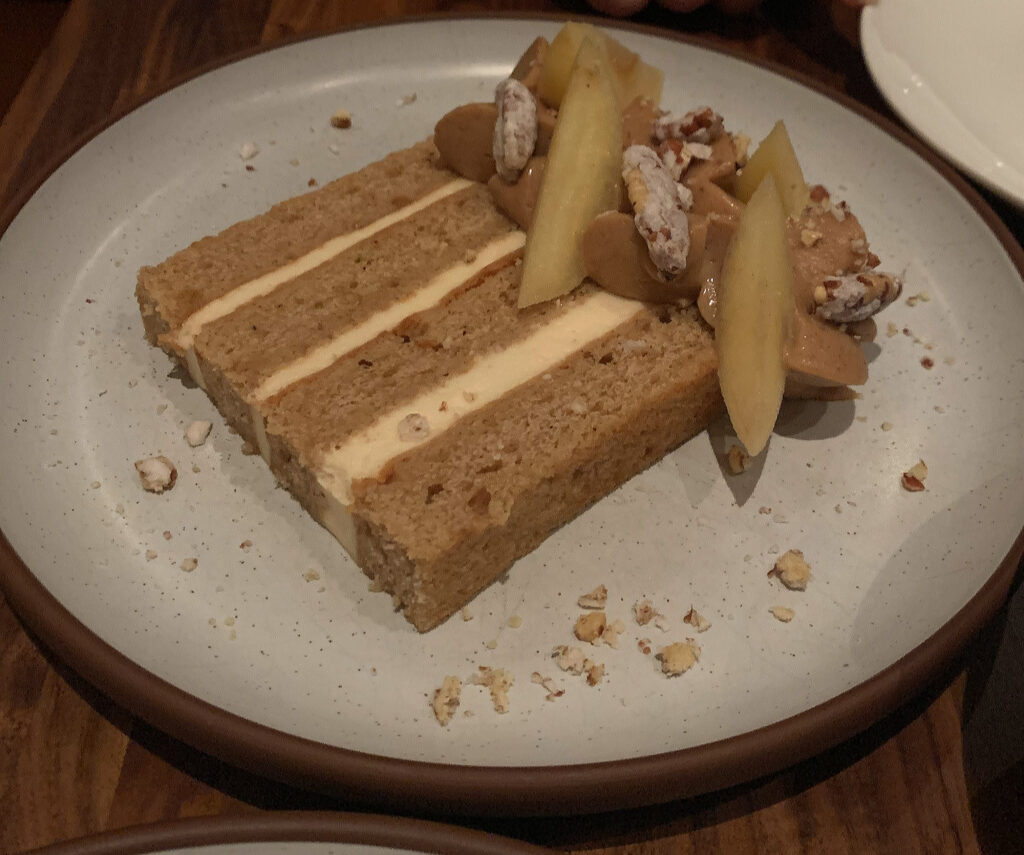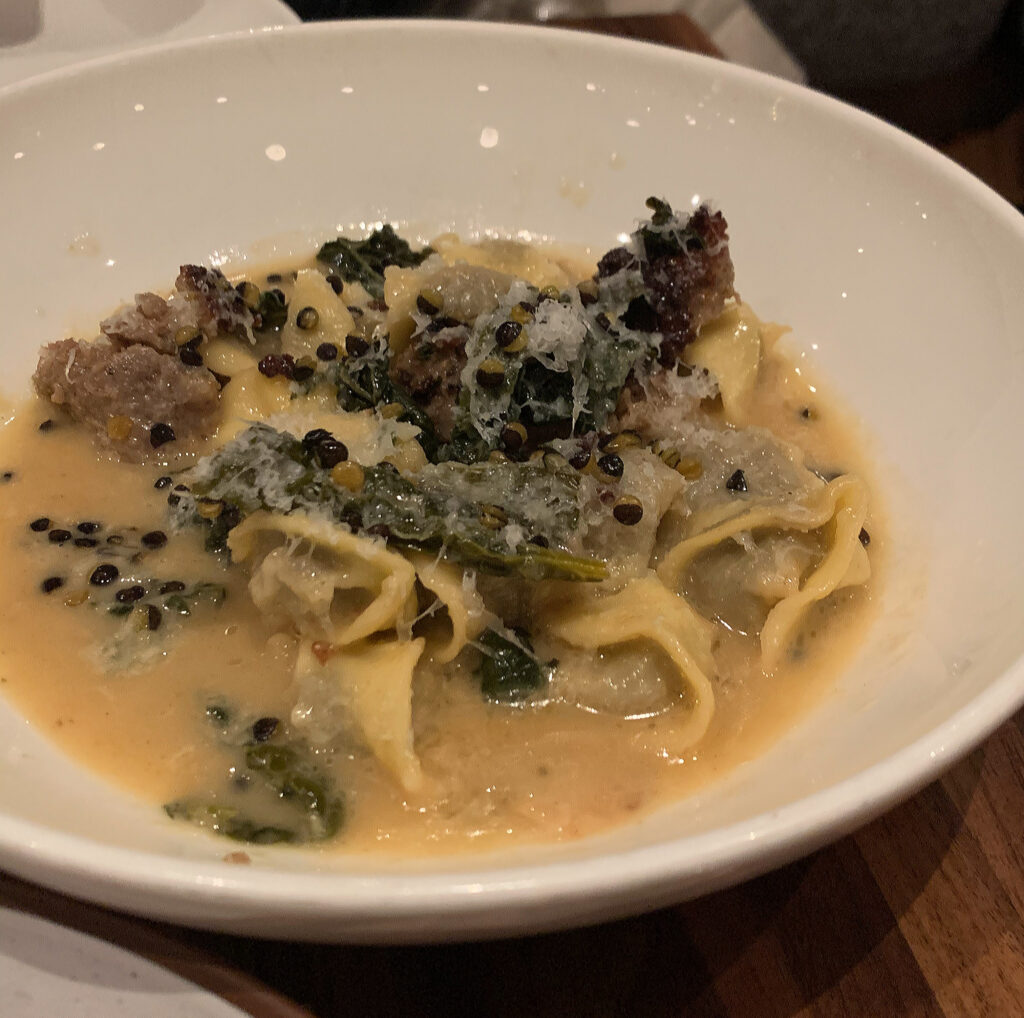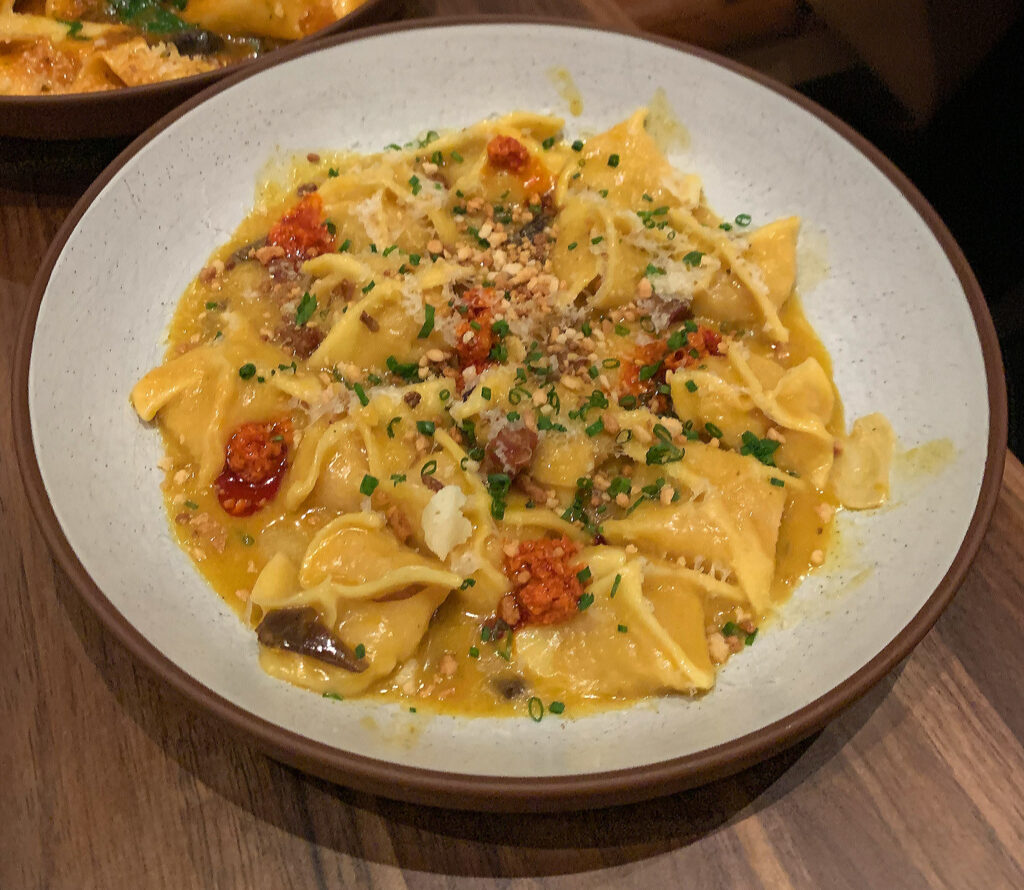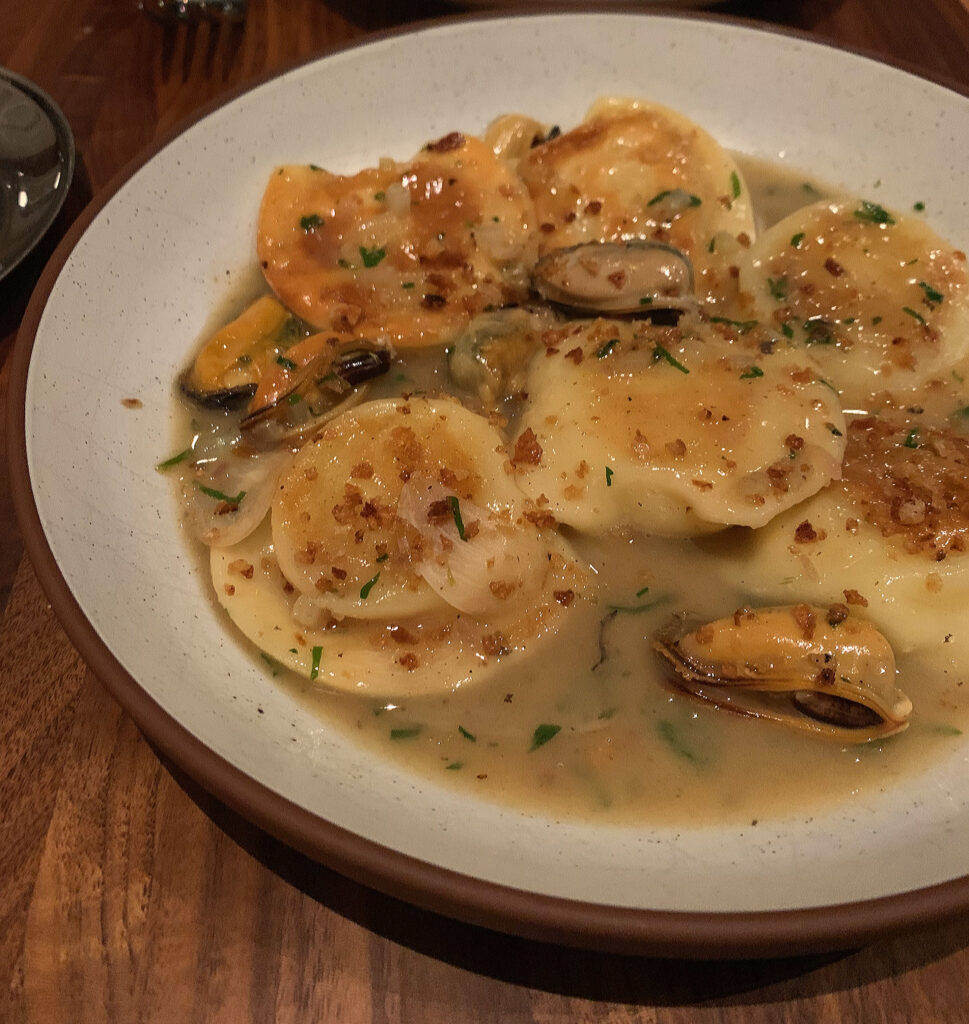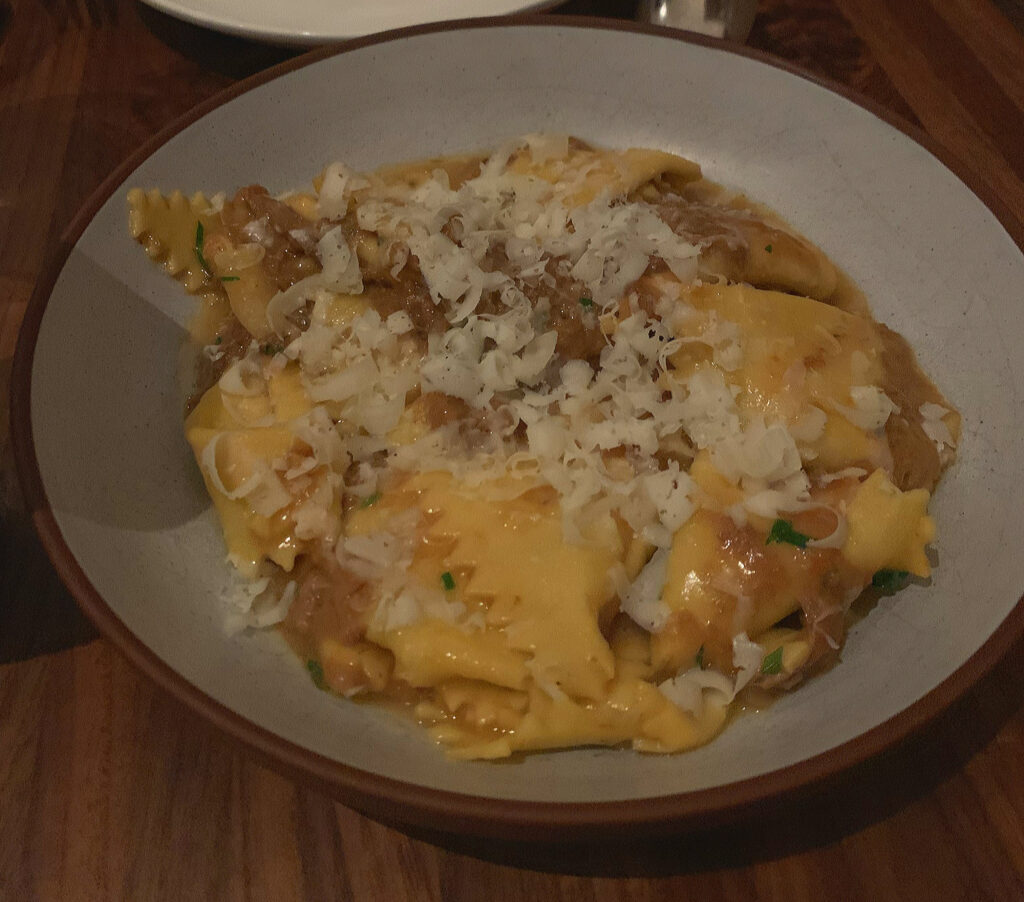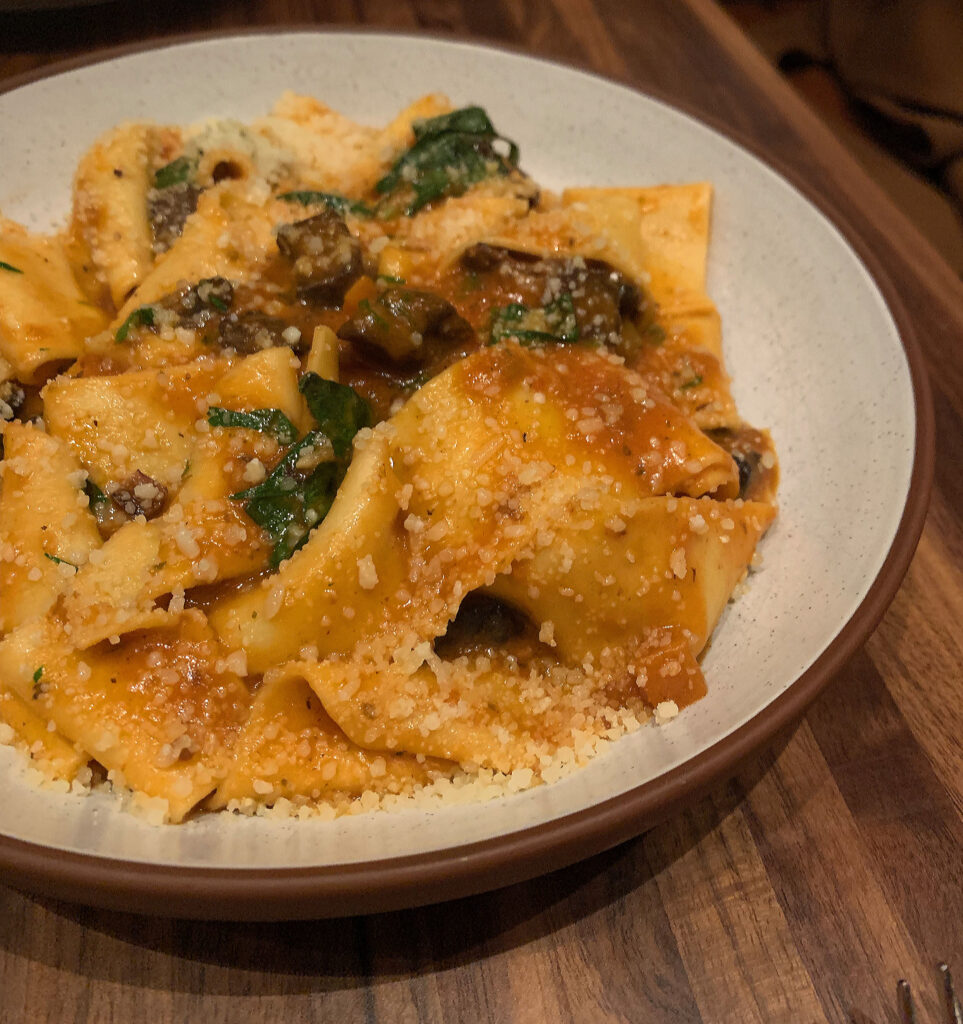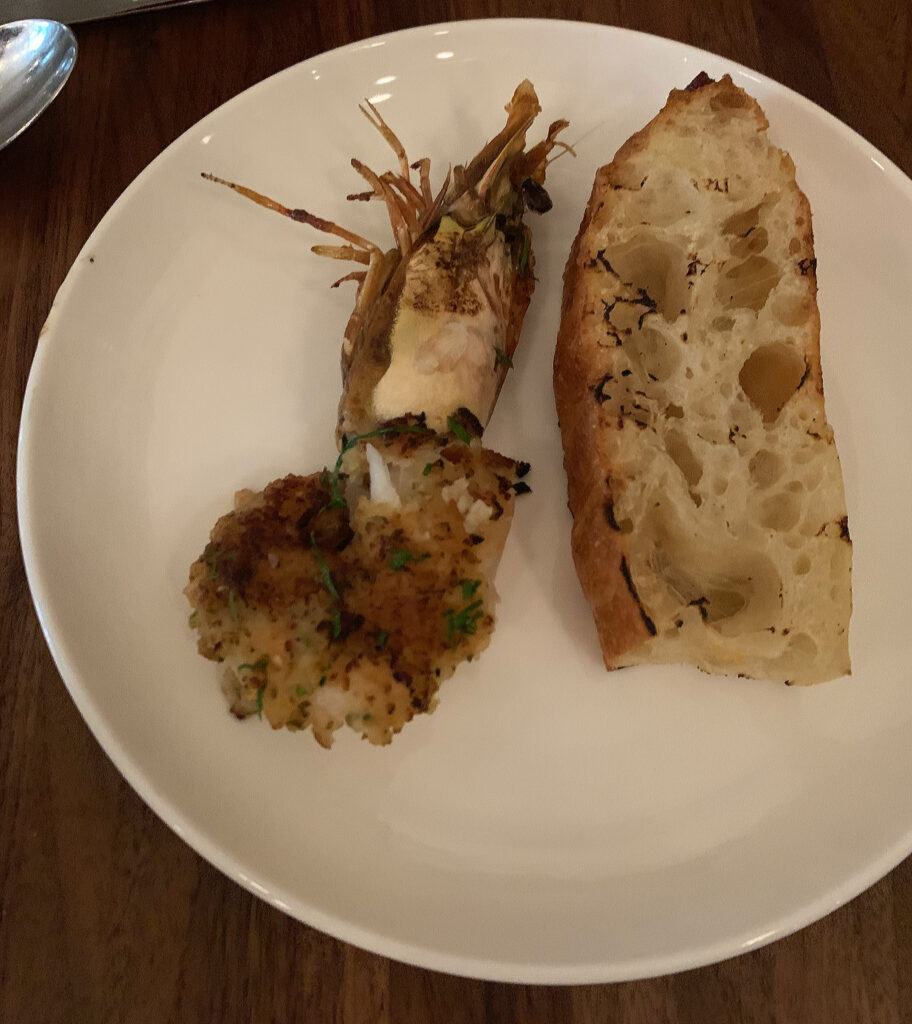Having just completed a series of articles on three of Chicago’s most enduring fine dining establishments, you now return to another specimen that has reached middle age. Yes, Daisies—like Temporis—first opened in 2017, and that means the restaurant has passed the all-important five-year mark (to say nothing of traversing a pandemic).
It also, you think, falls somewhat into that “contemporary American” genre you have been trying to untangle across so much of your work. At the very least, Daisies prompts a conversation about how a particular cultural inspiration interacts with native ingredients and tastes to form a unique identity that is untethered to tradition (but more on that later).
However, whereas Temporis fights for relevance in the pricey ($215) Michelin-starred tasting menu category, Daisies operates as an à la carte neighborhood joint. In that role, the latter restaurant has not been free from controversy, yet it remains decidedly accessible. Moreover, while Temporis has been defined by chef changes and a corresponding evolution in style, Daisies has stayed true to one man’s vision. Doing so, the concept has expanded its mission beyond mere lunch or dinner and, subsequently, outgrown its original space.
Rather than limping through middle age—warily eyeing each hot new opening as a threat to its dominion—Daisies is undeniably at the peak of its power. The restaurant has not only transferred its success to a bigger building (more than three times the previous square footage) with a renovated kitchen and all sorts of other new features. Located just a couple blocks away from its first home, it not only remains a beloved part of the same neighborhood. But, in an era when many Chicago stalwarts have been lucky to survive (only to slowly, if ever, recover their former glory), Daisies can brand itself using that coveted “2.0” moniker: signaling a clean break, a true upgrade, a new iteration that is (at least) twice as good as what came before.
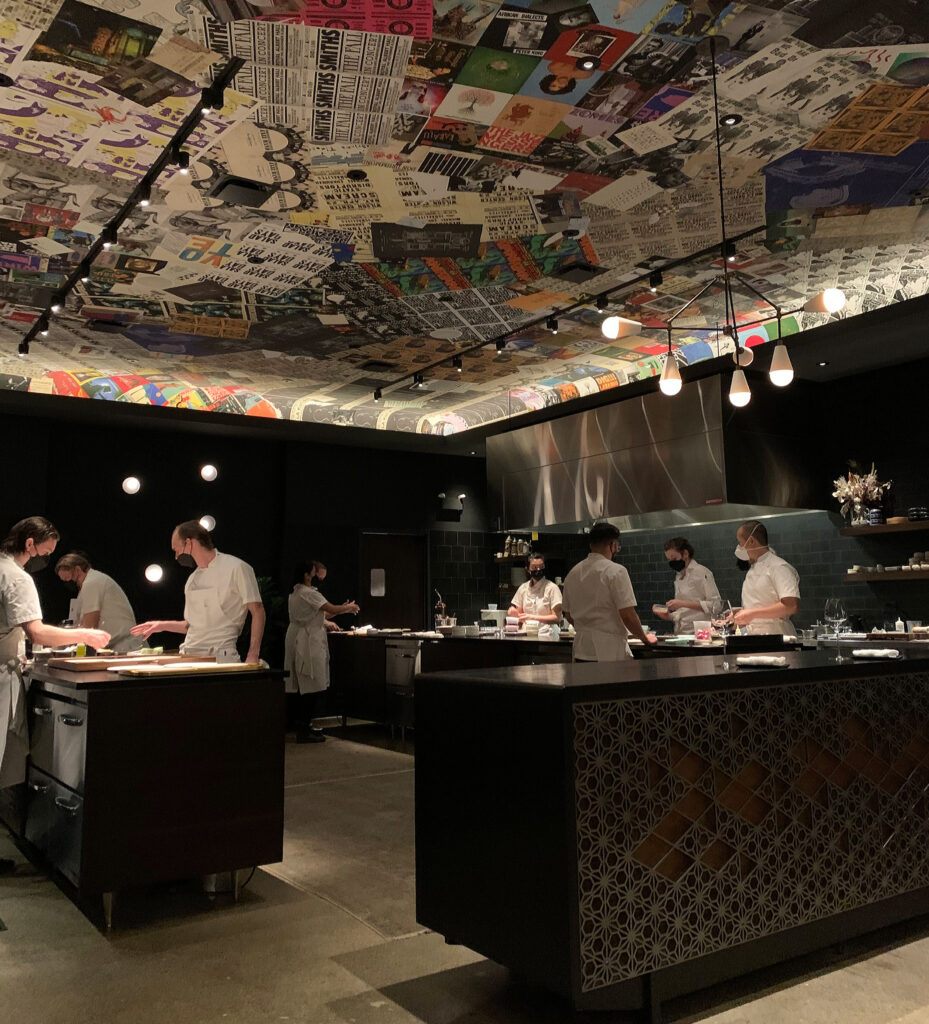
You have analyzed Alinea “2.0” and “3.0” before. Likewise, you have noted when Kyōten and Oriole each made their respective jumps to the “2.0” version. This nomenclature, sometimes embraced by the establishments or simply applied to them by journalists, is really just a form of shorthand. It does not reflect a change in the chef (as consequential as that may be) so much as a shift in the fundamental nature of the experience. Renovations have changed how Alinea, Kyōten, and Oriole conduct their meals at a spatial level, so service and cuisine have reflexively evolved to best exploit the new environment. Of course, these restaurants likely had some idea of what a downstairs “gallery,” a reconfigured sushi counter, or a sweeping lounge would empower them to do before breaking ground. Yet, it is hard not to think of a new-and-improved “2.0” or “3.0” property in visual terms.
Consumers cannot easily conceive of what a refurbished kitchen, filled with top-of-the-line equipment, might now allow the same craftspeople to do. (Again, it is notable that a change in chef is not typically viewed as an “upgrade” befitting that “2.0” or “3.0” label.) They may taste the difference somewhere down the line. However, the glitz and glamor of those novel accents and fresh materials do the most to promise everything you once loved about a place is still there—only better.
That being said, an evolution from “1.0” to “2.0” or “2.0” to “3.0” does not necessarily attract the attention of Chicago’s “critics.” Often, they—or their publication—has reviewed the property once already and cannot justify committing the resources required to make another visit. Years later, they may eventually have their say, but the story of the restaurant’s growth goes untold as consumers are left to contend with a new iteration of a hallowed concept on their own. Nonetheless, the chef’s reputation and the trust (or awards) they have already earned tend to carry the day: the restaurant is accepted as a clear improvement, and its status among the restaurant-going public grows even as those self-appointed “experts” chase the latest flash in the pan.
This is all to say, Daisies “2.0” found itself in an especially privileged position this year. Perhaps (relative to Alinea, Kyōten, and Oriole) that had something to do with the fact that it did not just renovate (or expand) an existing space but, rather, actually moved locations. Daisies “2.0” did not simply offer a grander version of the same essential concept but dreamt up something more for the neighborhood. The result being that the restaurant was met by an eager media apparatus for whom the launch of a new iteration—not worth closely examining when it occurs at the city’s most influential properties—was suddenly a pressing story.
They scurried over to Milwaukee Avenue and, less than two months after reopening (an abdication of professional standards alongside their inability to visit at least three times), awarded Daisies three-and-a-half stars (“outstanding to excellent”) while also anointing it “the best restaurant in Chicago.” Following in lockstep, The New York Times would name the restaurant one of only two in the city worthy of its “50 places in the United States that we’re most excited about right now” list for 2023. Even Bibendum would get in on the act by awarding Daisies (on top of its longstanding Bib Gourmand) a Green Star.
As you already noted, it is not unheard of for the reboot of an already successful restaurant to earn even higher praise. Plus, considering the concept’s approachable pricing, Daisies makes particularly easy fodder for cash-strapped “critics” looking to direct the masses without engaging in the harder work of cultivating their taste. However, the fact that praise was lavished so eagerly—then echoed nationally in the most patronizing way (more on that later)—can only arouse suspicion.
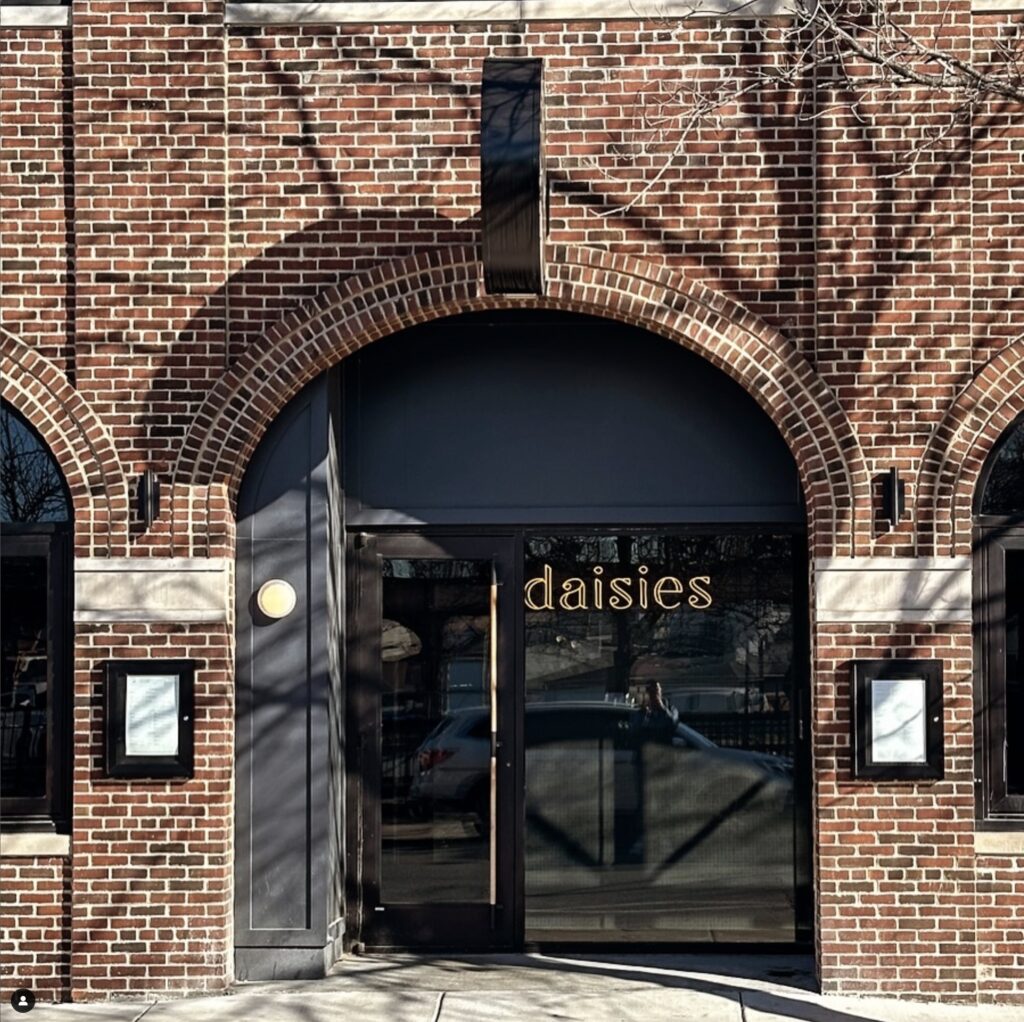
Either Daisies really is that good, or it has simply positioned itself as the perfect piece of critic bait: a golden opportunity to socially engineer the uncouth public toward appreciating the kind of food journalists think they should be eating. When terms like “the best restaurant in Chicago” have been rendered meaningless by cynical content creators disguised as commentators, and the shades of gray that separate “good,” “very good,” “excellent,” and “outstanding” restaurants are totally obscured, consumers are easily duped by concepts that look good on paper. They are made into patsies for thought leaders who, being so tickled by the thought of championing a place that ticks all the sociocultural boxes at a given moment, have neglected to do their due diligence.
If your posture seems a bit rabid, that’s the point. Chicago’s caliber of “critic” arbitrarily decides when to pan a new restaurant, rush to sing its praises, or put it on the back burner until they can write the review they originally wanted to (but couldn’t justify at the time). Privileging a personal vision of “equity,” rather than articulating a subjective but explicit and consistent standard for discerning quality, they are free to put their fingers on the scale as they please. No matter how clever as the concept looked from afar, as high as your expectations were upon first visiting, in Daisies you sense the traces of those resulting fingerprints.
But you get ahead of yourself.
Daisies is the brainchild of chef-owner Joe Frillman, who grew up in the northern suburb of Prairie View. His great-grandmother “owned two bars in Chicago” (Pauline’s Inn and Spring Mill Inn), and her daughter Daisy (the namesake of his restaurant) “was the person who made sure that food was the focal point of getting everybody together.”
Frillman has noted that Daisy’s influence led him to becoming a chef,” “his cousin to opening a restaurant,” and “many of his other cousins to pursuing careers in food.” Though his grandmother passed away when he was 11, he “got really interested in watching Julia Child” and shows like Yan Can Cook. Frillman paid attention to what his mother did in the kitchen and was also particularly struck by a “great grilled cheese sandwich” his father made him at age seven: “for the first time there was [sic] tomatoes on it,” and he realized “you can take the same thing, kind of, and get a different outcome just by adding certain ingredients.”
Though his parents recommended he attend culinary school, Frillman chose to pursue architectural engineering at North Michigan University and “hated it.” Returning home, the future chef “started working valet” and also helped open Rita Pia’s, a “friend’s pizzeria in Mundelein.” By then, he had already worked in restaurants as a food runner at The Cubby Bear and “as a bar back, as a bus boy, as a dishwasher, you name it.” However, at Rita Pia’s, he ”did everything” and finally decided to attend the Illinois Institute of Art, earning a degree in culinary arts.
While still attending culinary school, Frillman “looked everywhere for a job” but could not get hired due to a lack of kitchen experience. Eventually, he landed at Rick Tramonto’s Osteria di Tramonto in Wheeling’s Westin North Shore hotel. The restaurant was part of a range of concepts that included a “steak house, an osteria, a sushi lounge, [and] Gale Gand’s pastry place.” The staff there, having been “robbed” from Tru, was “just unbelievably talented” and included corporate executive chef Chris Pandel.
Halfway through his time at Osteria di Tramonto, Frillman “sent a letter to The Fat Duck” (then the number one restaurant in the world according to William Reed) looking to “come stage.” Working there taught him “a lot about discipline,” “attention to detail,” “knife skills,” techniques like sous vide, and “what it takes to get to that level.” Returning to Wheeling, Frillman started “tugging on Pandel’s sleeve” and learning things like “butchering salmon,” “breaking down lobsters,” “cooking mushrooms,” and making charcuterie.
When Pandel left to open The Bristol in 2008, Frillman joined him as a chef tournant. The latter would describe the experience—“no prep cooks…[just] four cooks”—as “boot camp and a half.” The cuisine there was “very intricate” but “rustically plated” with a “meat-centric, pork-centric” focus in the beginning. The team took a nose-to-tail approach that involved “a lot of charcuterie, a lot of pickling, [and] preserving” applied to whole pigs, goats, and lamb. Frillman also learned to work “hand in hand” with purveyors Mick Klug Farm and Spence Farm.
Though The Bristol opened with only one pasta on the menu, that expanded to six (all handmade) within a year. The restaurant “didn’t have a pasta cooker,” “extruders,” or any “nice equipment at all.” Pandel would push Frillman “on a daily basis, every single day” to “figure out how to get it done” and “to go, and run, and make the best of the bullshit you’re handed.” But The Bristol was where his career “kind of took off.” Pandel would nominate him as one of Time Out’s “20 Chefs to Watch” in 2011, proclaiming “Joe is still very young but has the potential to do great things in the Chicago culinary world.”
Representative dishes from Frillman’s time at The Bristol include:
- “Fried Shishito, Bonito Flake, Togarashi, Lemon”
- “Roasted Beets, Smoked Mozzarella, Pine Nuts, Pickled Cherry”
- “Head On Prawns, A La Plancha, Anchovy Butter, Tarragon”
- “Raviolo, Ricotta, Egg Yolk, Brown Butter”
- “Fazzoletti, Roasted Cauliflower, Marcona Almond, Saffron”
- “Pappardelle, Stewed Chicken, Sweet Peppers”
- “Pappardelle, Bacon, Chicken Liver, Porcini Butter”
- “Goat Liver Sausage, Rhubarb Mustard, Zucchini, Almond”
- “Cold Smoked King Salmon, Bacon/Dill Dumplings”
- “Pan Roasted Halibut, Parisian Gnocchi, Snap Peas, Cracklin’”
- “Roast Half Chicken, Mustard Spatzle, Crunchy Salad”
- “Goat Merguez, Spicy Rapini, Romesco”
- “Dry Aged Strip Steak, Confit Onion, Roasted Potato, Olives”
Looking back, Frillman would characterize The Bristol as “new American” in theory but “one of the most French-Italian restaurants…[he’d] ever seen” in practice. Departing from the concept in 2011, he spent three months abroad in France, Spain, and Italy. More particularly, in Abruzzo, Frillman “worked on a sheep farm and creamery” where he “spent time cooking, cheesemaking and learning about the simplicity of Italian food and the importance of sourcing ingredients locally.”
Returning to Chicago, Frillman joined Perennial Vivant as a chef tournant. He would describe Paul Virant as “one of the most Italian-cooking individuals” in his own right due to a focus on what’s “in season, around him, what’s available” and on the “simplicity” of serving “three things on a plate.” There, Frillman learned “how to treat people” and “manage people better.” He also learned about “pickling, preserving, [and] jams.”
Frillman left Perennial Vivant after about a year to reunite with Pandel for the opening of Balena (a collaboration between The Bristol’s team and Boka Restaurant Group) in February of 2012. As executive sous chef, he would help the concept earn one of 50 spots on Bon Appétit’s list of “Best New Restaurant” nominees along with a Bib Gourmand from Michelin that same year. Frillman himself would also be named to Zagat’s inaugural “Chicago 30 Under 30” in 2012 (alongside chefs like Matthew Kirkley and David Posey) while, in early 2013, Balena was named a semifinalist for the James Beard Foundation’s “Best New Restaurant” award (alongside Grace).
Described in its own words as “Italian inspired. Honest cooking,” Balena would earn a three-star (“excellent”) review from Phil Vettel declaring “pizzas, pastas, pastries make…[it] a whale of a restaurant.” The Tribune critic would also note that “pizza-and-pasta restaurants are not places one goes in search of imagination, but Balena is the delirious exception.”
Rising to the position of chef de cuisine, Frillman would stay at Balena until 2015 before taking “a couple of years off” to get married and spend time with an “older brother diagnosed with cancer.” This period, in which the chef recognized “there are more important things than food,” would eventually lead to Daisies’s genesis. However, it is worth dwelling on the kind of work Frillman was doing from 2012-2015.
Representative dishes from this era of Balena’s history include:
- “Frillman Farms Arugula Salad, Pine Nuts, Dante Cheese”
- “Coal Roasted Beets, Walnut Pesto, Pickled Candy Onions, Bottarga”
- “Smoked Mackerel, Aioli, Pangrattato, Soft Cooked Egg”
- “Octopus and Farro Verde, Black Olive, Nardello Peppers, Fireball Vinaigrette”
- “Tripe Alla Parmigiana, Grilled Bread, Soft Herbs”
- “Porchetta Di Testa, Lemon, Olive Oil”
- “Spicy Grilled ‘Korean Cut’ Short Ribs, Charred Orange, Basil”
- “Spaghetti Cacio e Pepe”
- “Tagliolini Nero, Crab, Sea Urchin, Chile”
- “Hen Egg Tajarin, Sage, Brown Butter”
- “Orecchiette, Lemon, Kale, Bread Crumbs, Chili”
- “Chitarra, Snail Bolognese, Herbs, Bread Crumbs”
- “Sardinian Style Gnocchi, Chicken Sugo, Burnt Escarole, Preserved Lemon”
- “Rigatoni, Pork Ragu, Porcini Mushrooms”
- “Strozzapreti, Rabbit Sugo, Rosemary, Olives”
- “Pappardelle, Lamb Sugo, Castelveltrano [sic], Orange, Pecorino di Fossa”
- “Paccheri, Lamb Pancetta, Smoked Potatoes, Collards, Pecorino di Parco”
- “Pumpkin Tortelli, Lamb Pancetta, Pecorino di Parco, Amaretti Cookie”
- “Potato Gnocchi, Beef Heart Bolognese, Pecorino Romano”
- “Grilled Prawns, Garlic Aioli, Fried Prawn Heads, Campari Vinaigrette”
- “Wood Roasted Great Lakes Trout, Beluga Lentils, Cilantro Salsa Verde”
- “Cornish Game Hen, Pinenut Dressing, Braised Greens”
- “Gunthorp Farms Salt & Pepper Chicken Thighs, Spicy Romanesco, Anchovy”
- “Catalpa Grove Rotisserie Pork Chop, Long of Naples [Squash], Mustard Greens”
- “Spicy Flap Steak Rotolo, Cranberry Beans, Grilled Green Beans, Pickled Wax Beans”
Served alongside wines from producers like Allegrini, Azelia, Paolo Bea, Ca’ del Bosco, Cavallotto, Ceretto, COS, Dominus, Gaja, Giacomo Conterno, Foradori, Bruno Giacosa, Bibi Graetz, Le Macchiole, Miani, Montevertine, Occhipinti, Ornellaia, Passopisciaro, Quintarelli, Roagna, Sassicaia, Shafer, La Spinetta, Terlano, Tua Rita, Elena Walch, G.D. Vajra, Venica & Venica, Vietti, and Roberto Voerzio.
While these dishes are decidedly (and deliciously) “Italian-Italian,” you appreciate the menu’s dizzying array of pasta shapes, playful bursts of creativity (Fireball vinaigrette, Campari vinaigrette), worldly inflections (Korean-cut short ribs, snail bolognese), and local sourcing (Gunthorp Farms, Catalpa Grove Farm). On that latter point, you cannot help but notice the “Frillman Farms Arugula Salad.”
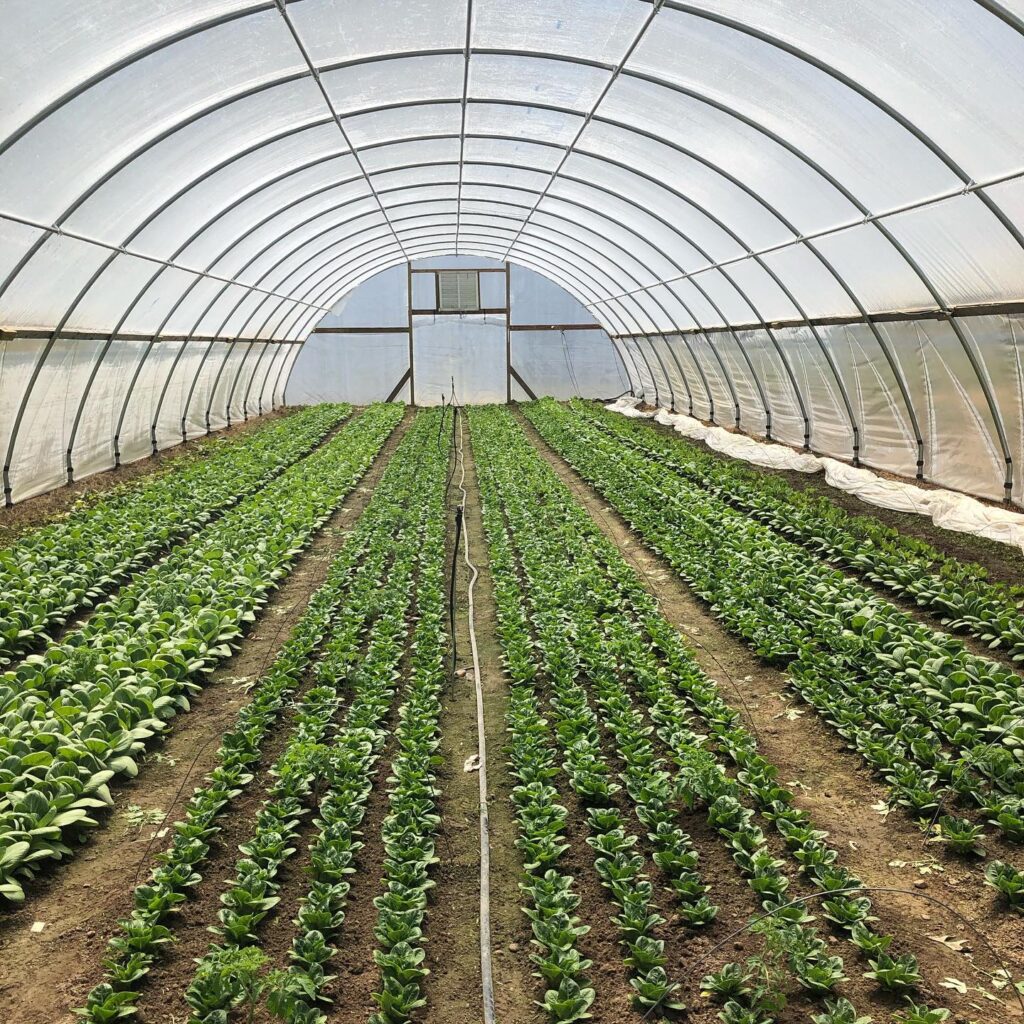
Incorporated by Joe’s younger brother Tim in 2011, Frillman Farms represents the revival of the family’s “farming roots [that] date back to the 1800s in Buffalo Grove, Illinois.” Its “eight-acre Prairie View plot” had been “leased out to neighboring farmers for the past few generations.” However, Tim retook control of the land and began cultivating heirloom, GMO-free crops (like beets, herbs, lettuces, onions, and radishes) along with more than a dozen varieties of pepper and more than 25 varieties of tomato. He also harvested eggs from more than 200 “roaming laying hens” and produced honey from six beehives before expanding his operation by purchasing Leaning Shed Farm and relocating to Berrien Springs, Michigan (while retaining the original Prairie View property).
Ultimately, Frillman Farms’s produce would play a decisive role in shaping Daisies’s identity: “part of the reason” Frillman started the restaurant was so he “could use…[Tim’s] great stuff” after Balena, once the chef left, “didn’t buy as much of it.”
But, back in January of 2017, the restaurant was still only in its earliest stages of planning. Coming back from his couple years off, Frillman would announce—via the Tribune—that he was bringing a concept “focused on vegetables grown in the Midwest and pasta” to Logan Square. He would be taking over the former space of “beloved…cocktail bar and Cajun restaurant” Analogue at 2523 N Milwaukee Avenue. Otherwise, it would only be revealed that the chef would be sourcing ingredients from brother Tim’s farm, which had just won a 2016 Frontera Farmer Foundation Grant to aid in “construction of a modest washhouse for vegetable preparation and packaging.”
By May of 2017, Frillman could announce that Daisies would be opening in June; however, details still remained sparse. Nonetheless, speaking to Michael Gebert that following July, the chef-proprietor would provide more context regarding the development of restaurant. Frillman originally wanted to open a barbecue place but was wary of profiting from “the environmental impacts of all that” (though he still eats it). Still, he sought to get back into the kind of food he “wanted to do” and that he “might not have had the free rein to do.”
More specifically, Frillman had grown to miss the “connection with the diner” and “connection with your employee” that characterized The Bristol—as compared to Balena, where his staff numbered 50 and included prep cooks that only worked in the daytime. The chef “wanted to open a place where the same people are here all day” and to “create opportunities for them.” He wanted the team “to have a good time” because “this industry sucks.”
At Daisies, Frillman would have “two cooks,” and they would look to bring the kind of food he likes to eat to an area that had “something missing.” Still, he would be running a “neighborhood restaurant, first and foremost,” with a “walk-in only” patio and bar. They would also consciously cater to families, not through a “dedicated kids’ menu” but simply by preparing “whatever your kid wants to eat.” The chef’s logic was that he would rather have them “come here and eat vegetables out of a farm that’s sustainably grown 30 miles away” than “going into the refrigerator eating fruit snacks or chicken nuggets.”
For the adults, Frillman would be taking inspiration from places like SPQR and Flour + Water in San Francisco. The menu would feature “10 or 12 starters” drawn “primarily out of what we can get from the local farms.” His brother’s “eight-acre garden” would “inspire the menu exponentially,” but other purveyors like Green Acres and Mick Klug could help to fill in any gaps. Complementing the starters would, “ideally,” be “10 or 12 pastas” along with a plan to take “all the things that go into trash” at the restaurant “and turn them into vinegars, kombuchas, you name it.”
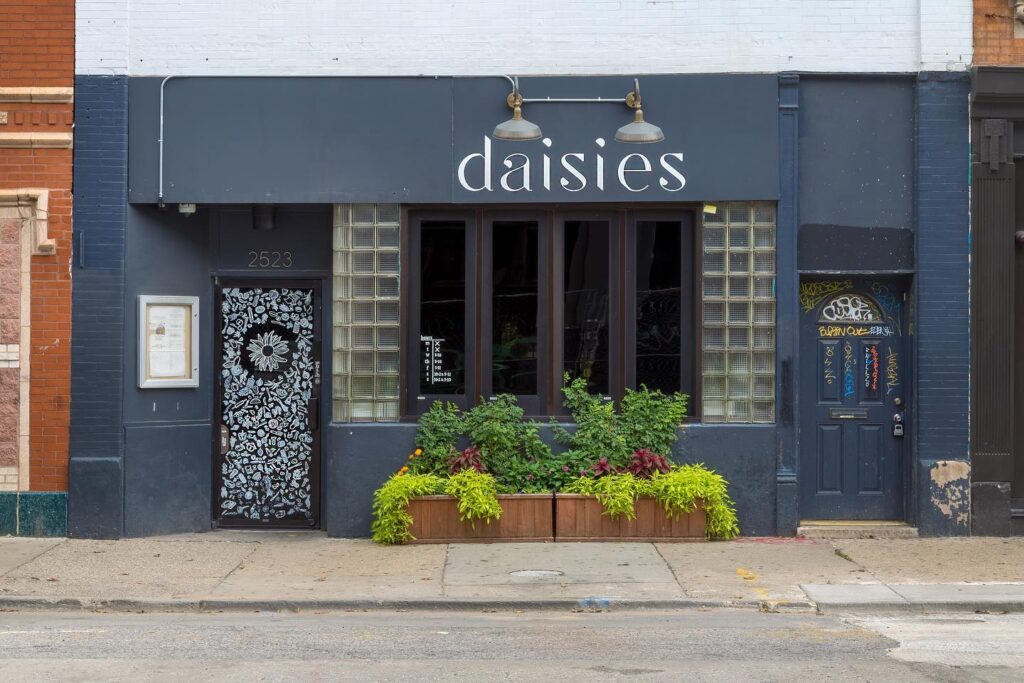
When Daisies launched on June 7th, Frillman would reveal his inspiration came from a pithy hypothetical question: “if the Midwest was a region of Italy, what would the food look like?” While the chef-proprietor didn’t “want to label this as an Italian restaurant,” he acknowledged “everyone associates pasta with Italy.” Instead, the menu would reflect “who he is and where he’s been”—like a beet-infused “Agnolotti” previously served at Balena or a “Spring Onion Dip” (with ridged potato chips) referencing the chips and dip he enjoyed “at family gatherings growing up.” Additionally, despite the “emphasis on vegetables,” dishes would “not necessarily” be vegetarian. Rather, Frillman would not be “shying away from fats” or “shying away from meats” as a complement to fresh produce.
As a “family restaurant,” Daisies had “four or five highchairs at the ready.” However, Frillman would also close on Mondays and Tuesdays “so his staff can spend time with their families.” This same sense of kinship was not only expressed through the restaurant’s name and its sourcing from brother Tim’s farm. Frillman’s sister Carrie also painted “large and arresting watercolors of vegetables hanging in the dining room” (“slated to change with the seasons and what’s growing in the fields”) and his mother Nancy “helped set up” the 70-seat space.
In July of 2017, the Chicago Reader would be the first to weigh in on the restaurant’s actual quality. Mike Sula praised dishes like “tempura-battered mushrooms and cheese curds with a tangy green goddess dressing” (something “Frillman’s future regulars will never allow him to take off the menu”), “singular” whole wheat tagliatelle with fava bean leaf pesto, “toothy pappardelle in a chunky mushroom sauce,” “pillowy, browned” pierogi, and an “extraordinarily satisfying” tajarin with crumbled fried chicken skin. The critic also liked the “user-friendly wine list” with a “two-tier price-point format” of $39 or $59 for all bottles (that are also offered by the glass).
In contrast, Sula derided three “disturbing” dishes: a “sweet, soft carrot mass” cooked in duck fat, a “plate of glistening blood-red agnolotti” (“like something a surgeon might remove from the lower thorax”), and “planks of fried, dry” cornflake chicken. He also disliked the “small, close, and claustrophobic” front dining room (that also gets “clammy” on warm evenings) and dessert that seems “an afterthought.” Still, “apart from a few dishes that ought to be rethought,” the critic found Frillman to be “a chef of enough original talent” to transcend any lingering bitterness over Analogue’s closure and get people to talk about Daisies “wholly on its own terms.”
Michael Nagrant, writing for RedEye in August of 2017, would award the restaurant two-and-a-half stars (between “very good” and “excellent”) while praising the “fantastic and interesting bottles” on the wine list, “pillow” pierogi, stracci with “perfectly toothsome peas,” “tajarin…tossed with butter and Parmesan,” and cornflake chicken that was like “a superior and epic chicken nugget.” Alternatively, he noted “missteps” like “overcooked” and “mushy” zucchini, leeks that “could have used a touch more salt,” and a Kahlua cake that “yearned for a touch more coffee essence.” Still the critic judged that “Frillman has succeeded in creating simple, satisfying fare from local produce” and, additionally, “is making some of the best fresh pasta in Chicago right now.”
Time Out would have its say later that same month, with Maggie Hennessy awarding Daisies four out of five stars. She praised fried shiitakes and cheese curds that “oozed just enough inside,” a “pillowy burrata starter,” “toothy pappardelle ribbons…with just enough sweet mushroom ragu,” “supple yet textural, light yet indulgent” tajarin, and a “hearteningly crispy skinned” sturgeon entrée. Duck fat-cooked carrot rillettes were “almost too subtle” relative to their “bold companions” and desserts were “less intriguing” than the savory fare. However, the concept impressed as “an easygoing spot with can’t-miss pasta.”
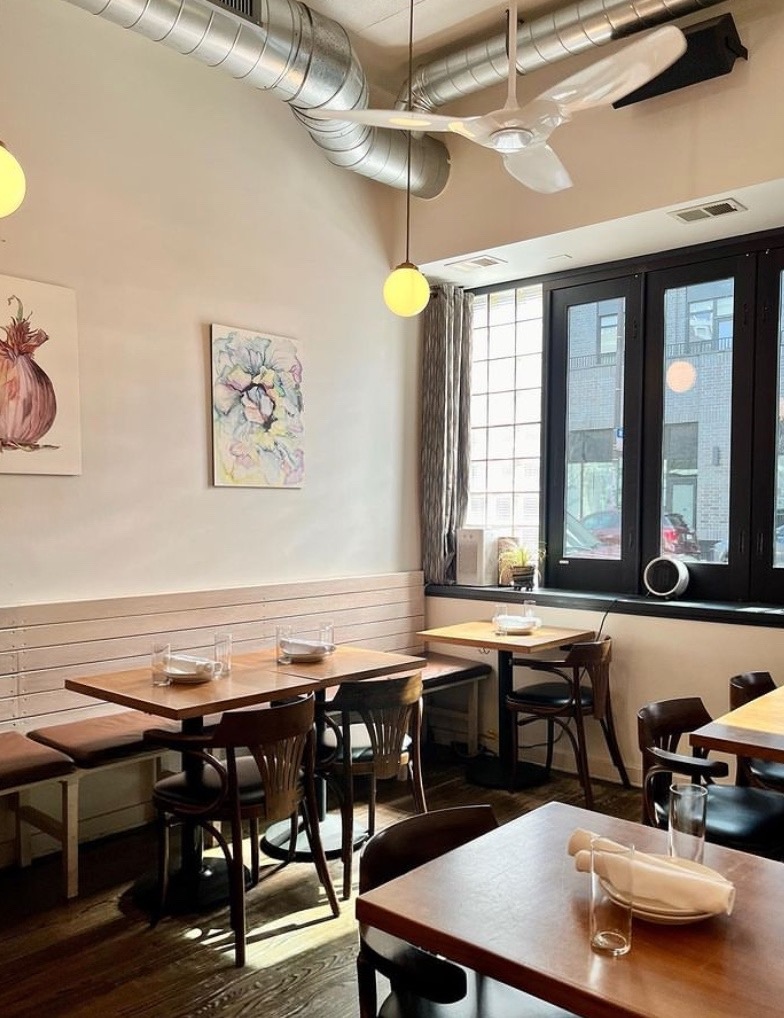
A day later, writing for Chicago, Jeff Ruby praised dishes like “soft and modest” burrata he would order “every time,” “gentle, earthy” leeks served with “puckery mustard hollandaise,” carrot rillettes (“just vegetables, treated right”), and pastas that are “among Chicago’s best.” More particularly, the critic liked the “buttery stracci,” and “toothy, mint-kissed Piemontese tajarin” as well as the “flaky Lake Superior whitefish.” In contrast, the cornflake chicken (“having been pounded into bland submission”) again “disappointed” while desserts were “limited.” Regardless, Ruby found himself “besotted” with Daisies and concluded that it charms “with a straightforward menu and homey atmosphere.”
On the back of all this positive local press, the restaurant would end its opening year on a triumphant note. Time Out would name Daisies one of 10 “best new Chicago restaurants and bars of 2017,” citing the “homey, understated space” and housemade pastas “dressed up with thoughtful ingredients.” Vogue would honor the concept as one of “6 Chicago Restaurants You Should Know About Now,” noting its “locavore-meets-Abruzzo point of view” where “vegetables are the true stars.” Forbes would get in on the fun by naming Daisies as one of eight establishments on its list of “Chicago’s Best New Restaurants,” praising pasta that is “just as good if not better” than what Frillman was “making at Balena previously.” Finally, in January of 2018, the concept would clinch the “Best Neighborhood Restaurant” award (beating out Le Bouchon, Old Irving Brewing Co., and Osteria Langhe) at that year’s Jean Banchet Awards.
The remainder of 2018 would be defined by a few key developments. In March, Daisies would begin serving Sunday brunch, with unique dishes like “Tajarin Carbonara,” “Sweet Fried Pierogi,” and “Scrambled Egg Bruschetta” joining the menu. In September, the restaurant would earn a Bib Gourmand as part of Michelin’s forthcoming 2019 Guide, with inspectors citing “fantastic pastas” alongside “execution, hospitality and creativity” that make the concept feel “like a true neighborhood spot, down to the regional wines.”
December would see Daisies featured, alongside Fat Rice, as one of several “restaurants…adding a new surcharge to your bill to cover the costs of employee health insurance.” In truth, Frillman had been engaging in this practice for “about a year” before CBS came calling. However, in the article, the chef-proprietor revealed he “didn’t go to the dentist for seven years” earlier in his career and, upon finally going, “the bill ended up being 3,500 bucks” due to a lack of insurance. He “didn’t want his staff to go through that” and “wanted to make sure they’re taken care of” while also viewing the decision as a way to “attract and retain talented workers in short supply.” At Daisies, “about a dozen employees pitch in about $100 per month,” with the employer paying “the rest” via the surcharge. Frillman suspected “larger restaurants may be doing the same,” but by “just increasing the cost of food without the consumer knowing were the extra money’s going.” Thus, transparency surrounding the practice was a way to ensure it didn’t seem like the added sum is “going into the owner’s pockets.”
At the time, the exact language used on the restaurant’s menu to note the surcharge was as follows:
“A 2% charge is applied to all bills to help us offer health insurance to all of our Daisies family.
The majority of the cost is covered by the business, and our team themselves, like any employee-provided health insurance plan. This surcharge allows a small, family-owned business to offer such benefits. We hope that in so doing we can encourage this practice to take hold in more restaurants across the city and the country. We are doing what we can to make the hospitality industry a healthier place.
Please inform management if you would not like to contribute. We will remove the charge.”
The dawn of 2019 would again see Daisies nominated at the Jean Banchet Awards, this time for “Best Service” (losing out to Temporis). The restaurant would also retain its Bib Gourmand, this time being praised for “its tiny but earnest and hardworking kitchen, clean, mid-century modern design and decidedly affordable prices.” Michelin even went so far as to say “this local charmer can do no wrong” while highlighting the “house onion dip,” “fried mushrooms with cheese curds,” “tajarin carbonara,” and “mezzaluna stuffed with fermented squash and lamb.” The very beginning of 2020 would also see Thomas Leonard (former chef de cuisine of Acanto and Walton Street Kitchen) come aboard as Daisies’s culinary director—a position in which he soon found himself being forced to totally adapt.
Representative dishes from Daisies’s pre-pandemic era include:
- “Radicchio and Peach Salad” (Prosciutto/Blue Cheese/Onion Vinaigrette)
- “Cauliflower & Broccoli” (Calabrian Chiles/Parmesan/Pine Nuts)
- “Sweet Corn” (Blueberry/Bacon/Mint)
- “Zucchini a la Plancha” (Calabrian Chili Oil/Goat Feta/Cashews)
- “Polenta Waffle w/Red Kuri Squash” (Roasted Iroquois Corn Meal/Pork Lardo/Balsamic)
- “Fried Polenta” (Spring Pea Medley/Strawberry/Beef Bottarga)
- “Chicken Fried Rutabaga” (Pork Sausage Gravy/Fermented Peppers)
- “Roasted Cabbage” (Braised Beef/Caraway/Ramps/Tinned Clams)
- “Celery & Cherries” (Smoked Sturgeon/White Beans/Pine Nuts)
- “Overpriced Tomato” (Heirloom Tomato/Bone Marrow/Cheap Balsamic)
- “Tortellini” (Lentils/Collard Greens/Pork Sausage)
- “Linguine” (Ramps/Pickled Pears/Bacon/Egg Yolk)
- “Fazzoletti” (Lamb Sugo/Heirloom Peppers/Pecorino)
- “Tajarin” (Turnips/Horseradish/Chicken Cracklin’)
- “Pierogi” (Potato/Mussels/Beer You Cook With)
- “Stracci” (Lamb Sugo/Broccoli/Pecorino)
- “Ravioli” (Celery Root/Black Truffle/Hazelnuts)
- “Triangoli” (Broccoli/Ricotta/Fontina/Almonds)
- “Tagliatelle” (Fava Leaf/Carrot/Sarvecchio/Pistachio)
- “Gnocchi” (Sunchokes/Sunflower Seed Pesto)
- “Gnocchi” (Morels/Caraway/Aged Parmesan)
- “Raviolo (BIG ONE) w/ Truffle Cheese” (Nettles/Egg Yolk/Brown Butter)
- “Cavatelli” (Zucchini/Mint/Feta/Bottarga)
- “Manti” (Fermented Squash/Smoked Onions/Neonata)
- “Chitarra” (Guanciale/Green Garlic/Rhubarb)
- “Lake Trout” (Almond/Confit Potatoes/Preserved Peppers/Oregano Salsa Verde)
- “Chicken” (Roast Chicken/Chicken Brat/Watercress/Pickled Red Onion)
Alongside wines from producers like Bonny Doon, Brooks, Hermann Wiemer, Illinois Sparkling Co., Left Foot Charley, Liquid Farm, Lo-Fi, Ovum, Schramsberg, Tablas Creek, and Wyncroft.
As the COVID-19 pandemic took hold in March of 2020, Daisies, like many restaurants, organized a fundraiser for its employees before shifting to carry out and delivery (including pasta kits) just a few days after ceasing indoor service.
Frillman would note that the restaurant was “finally in a place where…[they] had the best staff…[they’ve] ever had.” It took “a lot of time to get a group of people who work very well together,” and shutdown meant it all “came crashing down.” The chef-proprietor “had to let twenty-six people out of thirty-two go,” people he was used to seeing more than his “actual family.” Still, there were rays of hope: the local community came out to support the restaurant with well wishes and tips of “fifty to a hundred percent” on delivery orders. Likewise, Frillman’s greatest hope was that “an industrywide change in the way employees receive benefits” would come out of this period.
Though there was a “great response” to the restaurant’s pickup and delivery options, Frillman “decided to shut down the restaurant April 1” and “take a step back.” Daisies was “almost too busy,” the staff was “tired,” and he “wanted to see how things would play out.” In early May, the chef-proprietor looked ahead to “long-term changes” by partnering with his brother to offer “market boxes of produce” (alongside housemade pasta by the pound and more pasta kits) for pickup throughout the city. Frillman also envisioned “continuing produce sales even once Daisies reopens” by reconfiguring “its back room into a market, which would sell produce from the farm and items made in the Daisies kitchen.”
By the middle of May, the restaurant’s “next chapter as a restaurant-market ‘hybrid’” was ready to launch. Daisies opened its virtual market and began selling items pasta, pasta sauce, ramp butter, and jellies online alongside products from purveyors like Mick Klug Farm, Preserved States, and Green Circle (chicken). The restaurant also began hosting “small in-person markets” with “a few local food purveyors every Sunday” to help make up for lost revenue due to the closure of the Green City Market and Logan Square Farmers Market. These offerings would be joined by the resumption of pickup/delivery service and the sale of wine, beer, and “Bloody Mary kits.”
With the arrival of June, Daisies began offering patio service while continuing its virtual market and in-person Sunday shop. For its efforts, the concept would be named one of the “best outdoor restaurants in Chicago” by Time Out in July. In August, Frillman took things one step further by transforming his “back dining room into a grab-and-go market that’s stocked with fresh produce, everyday cooking essentials and locally sourced treats” for sale every day. Doing so, they would partner with even more local purveyors like Catalpa Grove, Beautiful Rind, and Publican Quality Bread. The chef-proprietor had “wanted to do this” before Daisies opened, but they “didn’t have the resources or time in the beginning.”
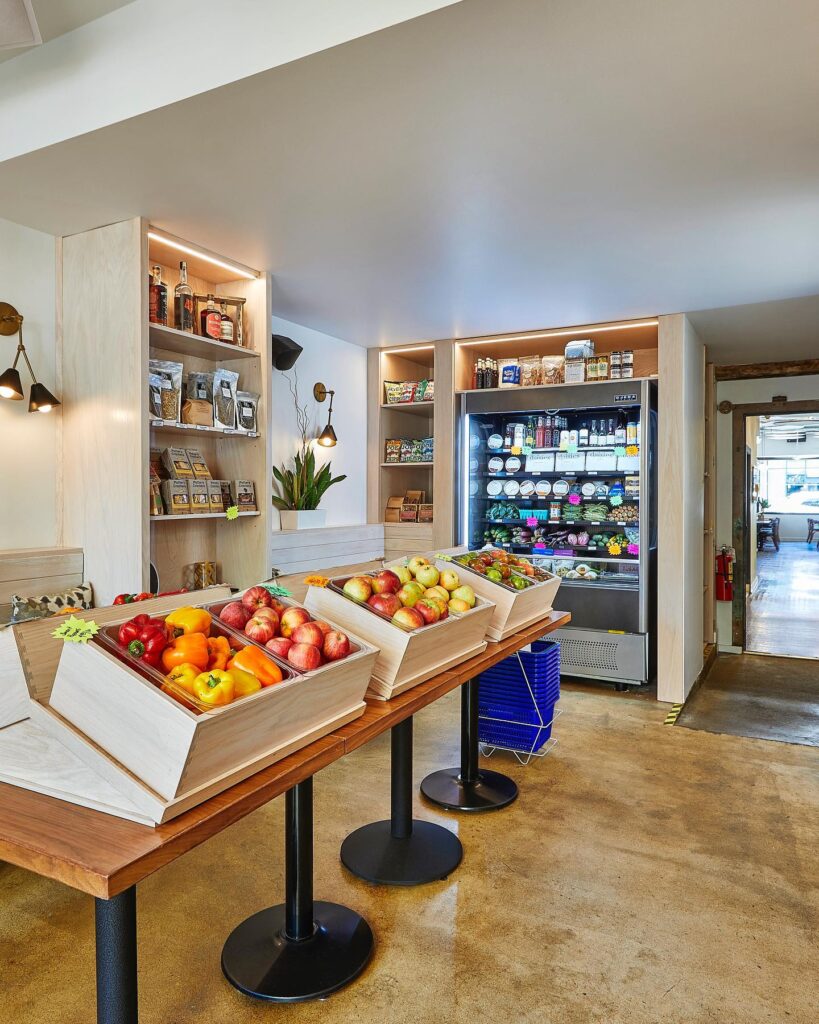
Concurrent with this more permanent market, the restaurant would continue offering takeout and delivery while also operating dine-in service. Guests eating at Daisies could browse the market at the end of their meal, “with servers packaging up any food items they might wish to take home” and cooks offering “tips for how to use certain ingredients.” Frillman was “able to bring back about 50 percent of his staff” through these ventures and even achieved another “pipe dream for the restaurant.” Daisies launched lunch service: originally planned as a “casual sit-down experience” but substituted for “a grab-and-go deli concept aimed at fueling remote workers who live in the area.” This would include “pints of cold salads (potato, pasta and broccoli)” as well as “specialty sandwiches like the Turkey Rachel, with fried shallots, thousand island dressing and purple coleslaw.”
Though there were still a few more bumps in the road to navigate, Frillman, in December of 2020, could begin to look beyond the pandemic toward the future. Asked which of his “innovations will remain in place,” the chef-proprietor responded “all of them.” That meant the “indoors farmers market is going to stay,” lunch service would be extrapolated “to a brick-and-mortar setup,” and delivery would remain an option for “slow night[s]” and “huge snowstorm[s]” to still sell their food.
By March of 2021, indoor dining at Daisies was back on track five nights a week. At that time, the restaurant also welcomed Katherine Sturgill as its wine and beverage director. Later, in April, the concept would retain its Bib Gourmand. And, that same month, Frillman would appear on CNN advocating for independent restaurants’ share of COVID-19 relief funds.
With lunch, brunch, the market, and dinner service all running at full steam, Daisies marked its fourth birthday in June of 2021, retained its Bib Gourmand (once more) in April of 2022, and in the middle of that same year (at the time of its fifth birthday) announced that “version 2.0 of the Daisies experience” would arrive in 2023.
Before engaging with what this reboot entailed, it is worth dwelling on some representative dishes from 2021-2022:
- “Cabbage” (Apricot Saor/Bagna Cauda/Pistachio/Dill)
- “Peach Panzanella” (Cherry Tomato/Goat Cheese Curds/Ciabatta)
- “Pear Salad” (Kale/Kohlrabi/Almonds/Pleasant Ridge Reserve)
- “Leek Tart” (Marsala Onions/Pecorino Fonduta/Pickled Ramps)
- “Asapargus” (Pickled Fennel/Cured Egg/Fontina Fonduta)
- “Fried Green Tomatoes” (Sour Corn/Dill Yogurt/Harissa)
- “Sunchokes” (Grapefruit/Fennel/Goat Cheese)
- “Brussels Sprouts” (Smokey Blue Cheese/Walnuts/Bacon Vinaigrette)
- “Green Beans” (Surryano Ham/Hard Cooked Egg/Croutons/Grain Mustard)
- “Shishito Peppers” (Smoked Sturgeon/Preserved Lemon/Espelette)
- “Fennel” (Marinated Mussels/’Nduja/Green Garbanzo/Kumquat)
- “Sweet Potato” (Salsa Verde/Fresh Chevre/Pecans/Calabrian Chili)
- “Rutabaga Latke” (Pickled Ramps/Rutabaga Pastrami/Apple Butter)
- “Spring Onions” (Bone Marrow Bagna Cauda/Lavender/Cheese Toast)
- “Turkey Liver Mousse” (Smoked Turkey Heart/Pear/Schmaltz Tart)
- “Ravioli” (Truffle Ricotta/Brussels Sprouts/Pancetta/Roasted Grapes)
- “Ravioli” (Truffle Ricotta/Sweet Corn/Jalapeno/Basil)
- “Tagliatelle” (Pumpkin Bolognese/Green Olives/Peptitas)
- “Potato Gnocchi” (Confit Chicken Thigh/Whey/Parsnip/Breadcrumb)
- “Gnocchi” (Pickled Cherries/Burnt Cabbage/Pistachio/Fontina)
- “Gnocchi” (Morels/Spruce Tips/Parmesan)
- “Cassarecce” (Clams/Green Garlic/Spring Onion/Breadcrumbs)
- “Risotto” (Asparagus/Preserved Lemon/Sorrel)
- “Risotto” (Summer Squash/Pine Nuts/Neonata)
- “Risotto” (Radicchio/Hen Of The Woods/Balsamic)
- “Manti” (Winter Squash/Pancetta/Neonata/Amaretti)
Alongside wines from producers like A Tribute to Grace, Au Bon Climat, Cruse Wine Co., Failla, Jolie Laide, Martha Stoumen, Matthiasson, Minimus, Presqu’ile, Ridge, Ruth Lewandowski, Sandhi, and Stolpman.
Looking back, these years reflect a meaningful degree of growth from the pre-pandemic era, with a range of new produce-forward starters, new pasta shapes, and ingredient combinations to dress those pastas (both new and old) on display. Favorites like the “Onion Dip,” “Fritto Misto,” “Tajarin,” “Agnolotti,” and “Pierogi” did indeed remain while proteins like the “Cornflake Chicken” were totally eschewed (a safe choice given their reception and the broader circumstances of the era). Sturgill’s work with the wine program, you must admit, also deserves praise. Though no longer sticking to the $39 or $59 format for bottles (the focus being more on selections under $100 at this point), she added a smart smattering of top-value producers to rejuvenate a list that, before the sommelier’s arrival, you can only term middling.
In October of 2022, Frillman would share more details about the Daisies reboot. The story was not so much about building a “2.0” restaurant, but transforming the old address into a “permanent market, café, and bar.” Frillman noted that demand for what amounts to a “grocery store” in the neighborhood was “clear,” with local customers showing up “multiple times a week now” instead of “just once in a while for dinner.” Committing fully to the market concept would allow him to “give his staff new experiences and opportunities” while also starting a community-supported agriculture program and “expand[ing] the restaurant’s fermentation program into a line of retail products.” He would continue serving lunch in addition to offering “cocktails and other drinks in the evening so people can gather.” That sense of creating “a neighborhood place where you see the same people, their families” and the resulting “community building” would also prove to be one of Frillman’s biggest inspirations. For what it’s worth, the “original restaurant” would be “moving to a much larger space nearby” too.
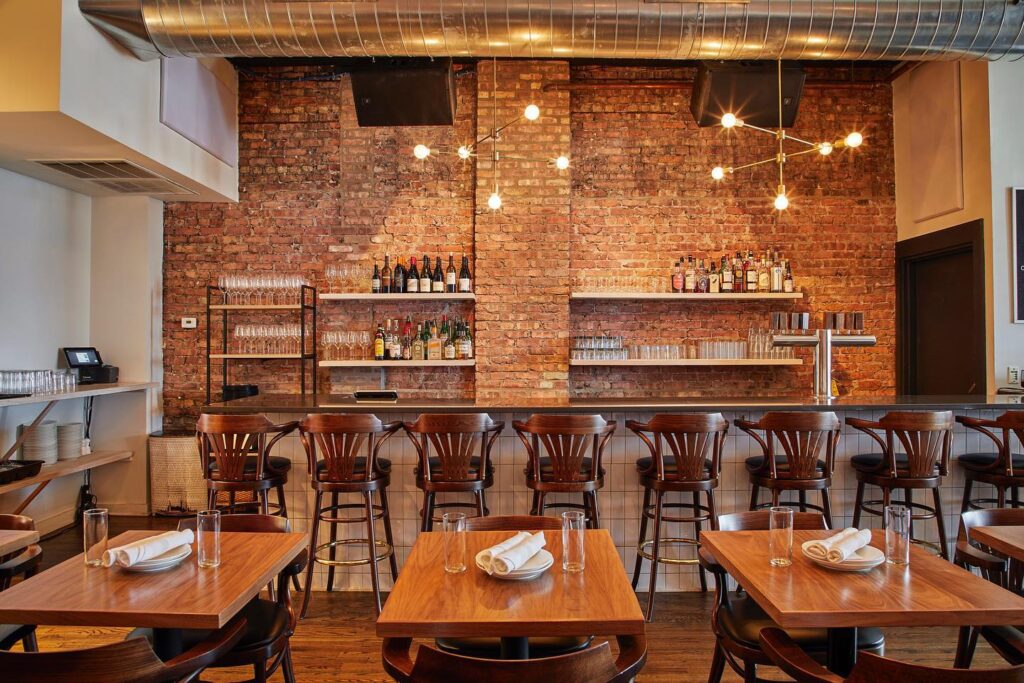
A month later, the chef-proprietor would admit the original Daisies space “was never meant to be a restaurant” and “wasn’t efficient” for the amount of volume they were doing. With seven years left on their lease and “200 condos across the street, with no food for these people outside of a Target,” it made “all the sense in the world” to make the market a fixture. Frillman had expanded his staff from 25 people (pre-pandemic) to 38, and staff tenure had “never been longer.” He credited that in part to providing “health benefits, a 401K retirement match, and…paid time off” for his employees.
The development of these of these other revenue streams (the market, meal kits, retail products) would help “maximize” the business so it was “sustainable for the staff.” That even extended to “using the all-day functionality of the restaurants” to give people “different schedules entirely” and better support work-life balance (especially those raising families). Ultimately, growing Daisies would grow opportunities for this long-term staff and eventually allow the restaurant’s culture to propagate itself.
On the culinary side, Frillman envisioned the market as a place where “you’ll be able to walk up, order a sandwich, get your produce for the week, a pound of turkey, and a bottle of wine…pick up your CSA box, also order a pound of pasta sauce, maybe a sous vide steak for dinner.” The building’s back patio would be enclosed to become year-round, and the space would be used, along with the bar, to offer a dinner service. Frillman described the menu as “casual in the sense that while people can go there and eat an entire meal, it’ll be a lot of craveable, shareable snacks.” The chef-proprietor would look to take “whatever doesn’t sell” and “use [it] for the menu,” meaning the food will “naturally be vegetable-forward.” He would also admit he was “really excited for the grocery dinner concept,” taking additional inspiration from the salumeria and restaurant Roscioli in Rome (where he was “nonchalantly” served some of the best food he’s “ever had”).

By December of 2022, Daisies was set to open the “2.0” version of its restaurant at 2375 N Milwaukee Avenue (about 500 yards from its original home/the forthcoming market) in February of the following year. At the time, Frillman also revealed that he had an ace up his sleeve. He had brought on Leigh Omilinsky, an old colleague from his time working for Tramonto in Wheeling and most recently the executive pastry chef for Boka Restaurant Group, as head pastry chef and partner of what Frillman would title Radicle Food Group. Omilinsky would look to “revamp the menu with eight desserts” that fit the restaurant’s “Italian meets…Midwestern” ethos while also filling the pastry case for a “morning café component.” She was described by her new partner as “probably one of the best pastry chefs in the city” and a “huge asset” for the group’s growth.
In truth, Daisies “1.0” would not complete its final service until March 5th of 2023. Such delays are to be expected, especially considering that Frillman “gutted” his new 5,500-square-foot location, formerly home to “German beer hall the Radler,” and “added an espresso bar, pastry counter, grab-and-go area, and 30-seat private dining room.” There would even be a “pasta and pastry production room” that could host classes, book signings, or a “quieter” dinner. Finally, on March 29th, Daisies “2.0” was ready to welcome guests into the 110-seat space: first, only in the evenings but quickly followed by morning café service in April.
On May 15th, the revamped concept received its first major piece of praise, earning three-and-a-half stars (“outstanding to excellent”) from the Chicago Tribune and being termed “one of the best new restaurants in Chicago.” The article would admit you “can go to Italy and find wonderful things” but “can’t go anywhere except Daisies to find its particular and sometimes peculiar collection of dishes.”
Of these, a “jumbo ramp raviolo,” which “only graces the menu for about three weeks,” was labelled the “must-order dish of the moment” and complimented for its “beautiful balance” of fattiness and bright sweetness. A daytime “asparagus and burrata brioche cream bun” was titled “some of the best brioche” the critic has had while “potted carrots,” a holdover from the original menu, “skyrocket[ed]” from “starter to stellar” with the addition of “housemade gnocco fritto.” The pierogi, another holdover, were “impossibly delicate,” and the pork tenderloin “thick yet transcendently tender.” Only salmon collars “seemed off” due to a “sulfurous note,” but the item was ultimately taken off the check (with the critic resolving to ask for them “well done” next time). Other highlights included an “earthy yet tart nonalcoholic take on the mushroom margarita,” a creation offered on the Daisies menu “since 2019” when Frillman took a trip to Blue Hill at Stone Barns and came home asking “what is a margarita in the Midwest?” Of Omilinsky’s work, a parsnip gelato was “ethereal” and various “treat-sized” desserts were termed “perfect.”
To hear the Tribune tell it, Daisies did not do a single thing wrong during the course of one dinner and a subsequent visit to the café (a rather dubious set of experiences on which to issue a permanent star rating). The critic, as you mentioned, even found a way to contort the lackluster, “sulfurous” salmon collars as indicative of a mere difference in personal preference. This all starts to make sense as the article reveals how they are “most” impressed by the restaurant’s “radical decision” to apply a 25% service charge to “dine-in checks to benefit all of the staff” (something Daisies “began implementing in June 2020”). Citing their firsthand experience with “the racism and sexism of tipping,” the critic looks to defuse “online outrage” regarding the practice by affirming the 25% surcharge is “seamless and clearly explained” with “no pushback” from the tables around them “on a busy Friday night.” For what it’s worth, the article assures readers that servers “do not expect a tip on top of that” and reveals that, “if service gets overwhelmed, the restaurant will remove the service charge.” But, in responding to “people who say to just build it into the price” (by answering—without drawing on any evidence—that it “rarely, if ever, works”), the critic makes clear they are rewarding the restaurant for practices they personally approve of rather than what is simply “on the plate.”
On May 26th, Michael Nagrant—who you might remember awarded Daisies two-and-a-half stars when writing for RedEye—went one step further. The “2.0” version was not “one of the best new restaurants” but “the best restaurant in Chicago.” Doing so, the critic framed the concept as the “only one” he’s “positive recent immigrants, Logan Square hipsters, tech billionaires, and heartland farmers will love with similar fervor.” He also predicted “Michelin will probably reward Daisies one star” and even alleged other writers are “not allowed to award the true numerical greatness of Daisies” or give it four stars “because you been made to believe that rating is only reserved for certain kinds of restaurants and chefs.”
More particularly, Nagrant praised the same “jumbo ramp raviolo” as reflecting how Frillman has “taken the best traits” of his mentors while adding “his own Midwestern sensibility” and “regard for traditional European foodways” to “create a style that is greater than the sum of all its inspiring parts.” With pickled Mick Klug ramps providing “a confetti of lifting acidity to cut through the richness of the pasta,” he tasted “Midwestern spring, Italian winter” and felt “the souls of Pandel, Virant, [and] Michael Carlson (Schwa)” in the dish. The critic also “died over” a rigatoni with the “salty beyond beef richness” of ‘nduja and “the fizz of fermented tomato” while gnocchi were described as “pure potato clouds with barely a whisper of gluten to keep them square.”
Moving beyond pasta, a preparation of beef tongue was termed “smoky and delicate like the love child of a flavorful ribeye and tender filet mignon.” The mushroom, artichoke, and cheese curd fritto misto, beloved from Daisies “1.0,” boasts nothing “a blindfolded red stater wouldn’t absolutely rave about on his barbeque-joint-review YouTube channel the next morning.” This kind of customer (“bubba”) would also love a “mahogany-dark” fish fry “swimming in the tastiest of tartar sauces.” Turning toward dessert, Omilinsky drew praise for a rhubarb-larded “crostata masterpiece,” “oven-warm” oatmeal cream pies, and a “genius,” “hospitality-forward offering” of seven different $4 mignardises. Additionally, Sturgill’s selection of “affordable natural food-friendly whites and reds” is called “superlative” while bar manager Seth Marquez’s cocktails also draw compliments.
Nagrant also enjoyed the “warm and inviting” nature of the setting and a style of service that “embraces children not only with their food, but also in its hospitality.” With regard to the 25% surcharge, the critic admits he “fully support[s]” and “believe[s] in” the practice but also notes the associated signs and notes and waiver introduce “a layer of friction and momentary pause” into the experience. He contends that he prefers folding “the service charge into the menu price” and eliminating “a tip line on the final check” (as Thattu does), but Daisies is “extraordinarily and well differentiated” in a way that “they can get the revenue however they wish with little to no negative outcome.” Frillman, to that point, is praised for his “smart vertical integration” and having “the best interest of every one in mind.” Ultimately, Daisies is a place to “be in the moment, be human, be inspired, be fed, and be alive.”
When The New York Times included Daisies on its list of “50 places in the United States that we’re most excited about right now,” the Gray Lady would confine itself to a mere blurb. The restaurant earned praise for its pierogi, “fried whitefish from the Great Lakes,” Omilinsky’s desserts, and wines like a “sassy sparkling rosé made from grapes grown along the Illinois River.” Additionally, the “Italian-inspired cuisine” was termed “authentically Midwestern” with a current of “extreme locavorism” that “is not shallow trickery” but backed by cooking “as adept as any you’ll find Chicago.”
However, the blurb’s biggest highlight is the “fritto misto starring cheese curds and local mushrooms,” which is used to draw a contrast between “how Joe Frillman does things” and how chefs “serving ‘authentic’ fritto misto in landlocked locations typically enlist the help of airfreighted squid.” This calls what Nagrant said about the “blindfolded red stater” to mind, and it also harmonizes with what The Infatuation had to say about the dish: “Daisies turns something that belongs at the State Fair into a delicate appetizer.”
These statements, though disparate, seem to get at the same idea. Doing so, they just about give the game away: Daisies is portrayed as the antidote to the kind of backwards cooking that goes on in the “flyover” Midwest. Frillman impresses both by transcending the worst habits of the region (“airfreighted squid”) and by subverting expectations through the transformation of slummy state fair fare into something “delicate.” Thus, he not only pleases his Logan Square regulars but stands to convince red-state rednecks as to the virtues of “extreme locavorism” as well.
There is nothing wrong with this argument in theory. Great chefs are great in part because they effectively communicate their ideas and expand appreciation for their work beyond those who form its conventional audience. However, in the writing of The Hunger, The New York Times, and The Infatuation you detect traces of shame. You sense a smidge of that patronizing, social engineering mindset that says: “even the most regressive of my hick neighbors will eat this shit up.”
Onion dip, fritto misto, and pasta, then, form something like trojan horses for the propagation of the writers’ pet causes: equitable pay for front and back of house, the abolition of the “racism and sexism of tipping,” the privileging of local sourcing, and the corresponding development of a hyperseasonal Midwestern (through an Italian lens) cuisine. You cannot disagree that these are noble aims. Rather, you simply doubt the validity of two local critical accounts that found nary a thing to criticize at Daisies. Knowing the authors’ sympathy for (or even defense of) the causes the restaurant fights for, you can also understand the temptation to cheerlead the concept so hyperbolically.
However, adopting a less charitable and more rigorous approach, it seems right to ask: do Daisies’s front- and back-of-house staff deserve, in terms of the quality and consistency of their work, what amounts to a 25% forced gratuity? This seems like the right way to judge whether that added fee would be better off baked into the menu prices (with expectations being shifted more toward the overall value proposition of the establishment rather than individual employees). Likewise, does Daisies’s cuisine (and, in particular, the produce sourced from Frillman Farm) measure up to the sterling quality that has been asserted? The collaboration between brothers sure sounds good on paper but quickly begins to stink if it becomes at all unclear what you are paying a premium for.
Asking these questions will help prompt a careful evaluation of the work Daisies is doing without being led astray by the chance to opine on the restaurant’s feel-good practices (let alone rushing less than two months after opening to celebrate them). Flying such a banner may allow food writers to feel relevant, but, the second that activism leads to an abdication of their critical duties, it is the consumer who has been betrayed. This is all to say that, in your mind, Daisies will live or die on the foundations of the experience offered without any partiality as to how—at a philosophical level—they choose to execute it.
For what it’s worth, Michelin has recently struck its own balance: keeping Daisies at the Bib Gourmand level (“good quality, good value cooking”) while awarding the restaurant a Green Star on the basis of its ingredient sourcing, “dedicated fermentation program,” and “compost program.” Perhaps this is the right approach, for it allows Bibendum to praise certain environmental practices without feeling pressured to undeservingly boost readers’ perception of the concept’s service and cuisine. (It is also interesting to see Michelin categorize the restaurant, rather simply, as “Italian.”)
With so much context and subtext to keep track of, the best approach—as always—is to dive viscerally into the dining experience and see where the proverbial chips (and onion dip) fall.
You have visited Daisies “2.0” a total of four times, comprising a period from September through November of 2023. As usual, you will condense the sum of your experiences into one cohesive narrative.
With that said, let us begin.
Daisies “2.0,” you must admit, is primely positioned in a part of the city that has come to rival West Loop and Fulton Market as of late. You are not speaking about the sheer density of dining options offered, of course, but of a sneaky assemblage of superlative concepts.
Heading down Armitage, that familiar avenue, you come upon Kyōten, Kyōten Next Door, Table, Donkey, and Stick, Osteria Langhe, Gretel, Bungalow by Middle Brow, Giant, and Ørkenoy in fairly quick succession. Heading east, past Redhot Ranch, and northwest up Milwaukee the hits are a bit more scattered. There’s plenty of sushi and ramen and coffee and cocktails. However, you also find places like Beautiful Rind, Paulie Gee’s, Testaccio, Mi Tocaya Antojería, Big Kids, Longman & Eagle, Loaf Lounge, and the legendary Lula Cafe. (You might also mention Andros Taverna, though it was home to your worst meal of 2021.)

Daisies sits somewhere in the middle of it all, and this is not quite an area you would classify as a pasta desert. That being said, the restaurant’s competitors are quite differentiated: Osteria Langhe focuses on the food of Piedmont, Testaccio on Rome, Table, Donkey, and Stick on the Alps, and Lula Cafe on its own vision of farm-to-table cooking (with only two or three noodles appearing on its menu at a time).
Yes, Frillman has forged a concept that is quite unique in its devotion to pasta, offering as many as 11 or 12 preparations at a given time compared to five or six—maximum—from the most enterprising of his neighbors. And you cannot forget the vegetables. Though often prepared with an eye toward decadence, they promise a degree of healthfulness that is unique for a neighborhood where convenience often reigns. When you add in the daytime café—that “third place” with its pastries and outlets and Wi-Fi—you are left with an imposing, multifaceted concept that is not easily equaled anywhere else in the city.
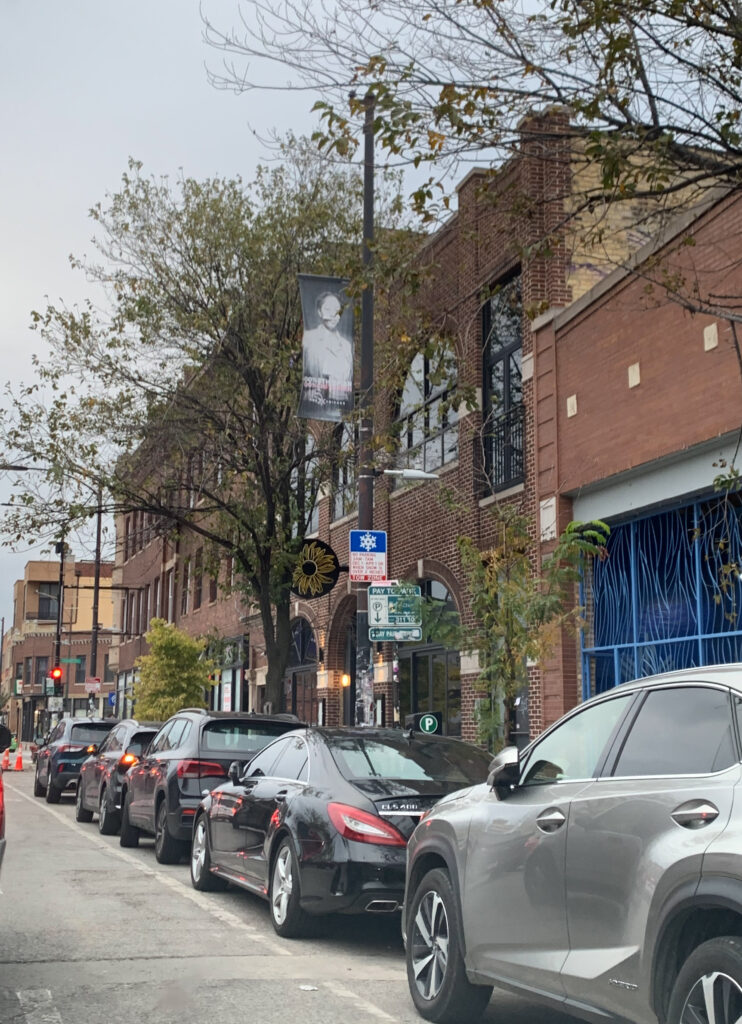
Nonetheless, at ground level, Daisies looks quite welcoming. The Radler’s old home, a two-story fortress of brown brick, gray stone, and black accents, is rendered more friendly thanks to signage featuring the restaurant’s namesake flower and a neon sign that glows a deep tone of yellow out from the other side of the vestibule. These accents look especially polished when compared to the surrounding businesses on the street: a bank with an expansive parking lot, a cannabis dispensary secured behind blue grating, an unassuming ketamine clinic, a Latin grocery, a tattoo shop, a body piercing shop, another one of those “barcades,” and a longtime coffee roaster in a timeworn structure. Easy Does It, a breezy wine bar that opened in 2020, might be Daisies’s closest counterpart (at an aesthetic level) on the block. But it, too, is hidden behind a drabby façade.
This all means that Frillman’s restaurant, just barely removed from the bustle of Fullerton Avenue (and from more banks, gas stations, schools, and churches), stands as an uncommonly homey hub. It stands tall, bright, and spacious and ready to host its community (not to mention their families) in a manner that is rather unseen in this immediate area.
Stepping through Daisies’s entrance, you traverse the vestibule and open one additional door that deposits you in front of the coffee shop/pastry counter. Even under the cover of darkness, the white marbled surface, bright mosaic tiling, and light tones of wood give the impression of a sleek, modern café. You spy branded gear (hats, shirts, mugs), a fridge filled with canned La Colombe lattes, a deluxe espresso machine, some grinders, and a double-spouted coffee maker. A letterboard—white block characters on a black background—displays the various options and their pricing with a measured dose of nostalgia.
However, venturing forth from the vestibule, you have little time to dwell. The hosts manning the counter meet your eye immediately and check your name off their tablet before one of them comes, with menus in tow, to lead you to the table. While this process is rather effortless when dinner service starts, you have seen this reception area become packed with as many as a dozen people during peak hours. This is not an indictment of the staff’s ability to seat patrons but, rather, a testament to the concept’s popularity. The assembled lingerers look to be waiting for seats at the bar to open up or for their table to be cleared. They only form a minor nuisance as you later dodge their sullen frames on your way out the door.
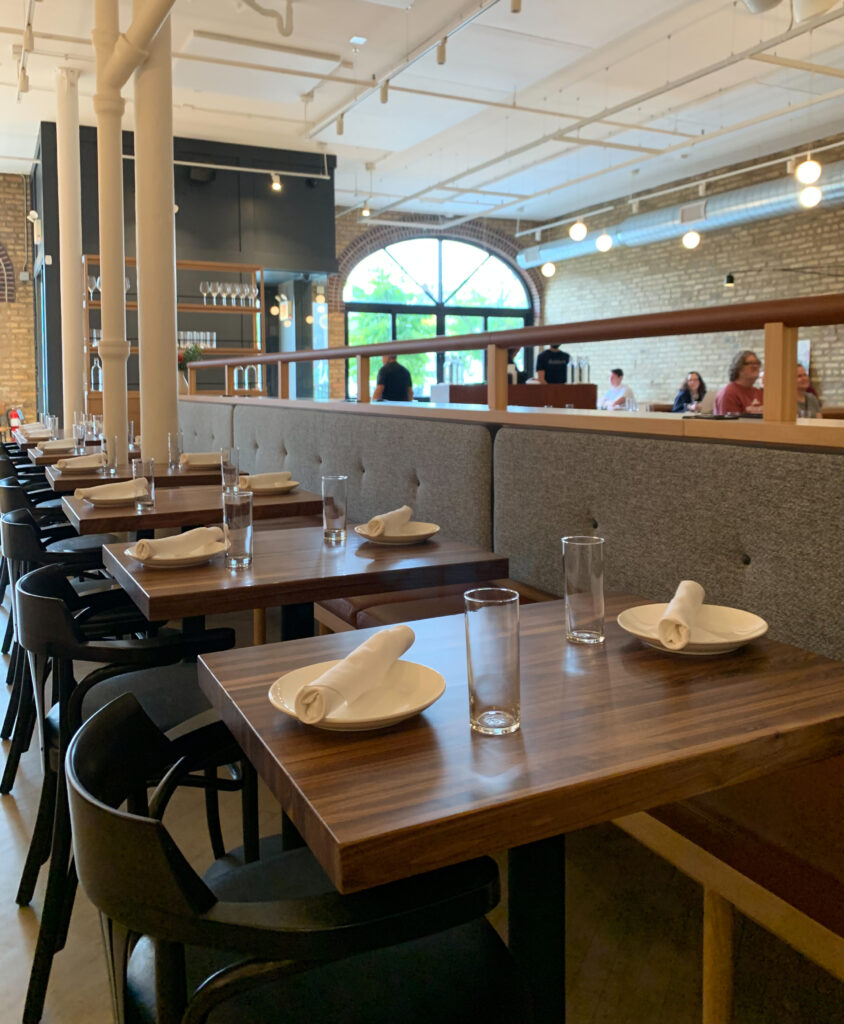
Being led into the dining room (something that merely entails walking a couple steps to your left), you begin to get your bearings. Owing to the fact that The Radler was a beer hall, Daisies “2.0” is almost entirely made up of one single, sprawling. Down the middle, you find a double-sided banquette rendered in gray and brown tones with white structural beams and pipework interspersed. To your left, along the western wall, lie a series of C-shaped booths set against exposed brick. They seat up to five (though somewhat uncomfortably based on your observations) and come crowned with paintings (presumably by Frillman’s sister Carrie) depicting produce like carrots and peppers. The canvases do not actually hang on the wall but lean against it from the top of the booths, meaning the images become partially obscured once guests are seated.
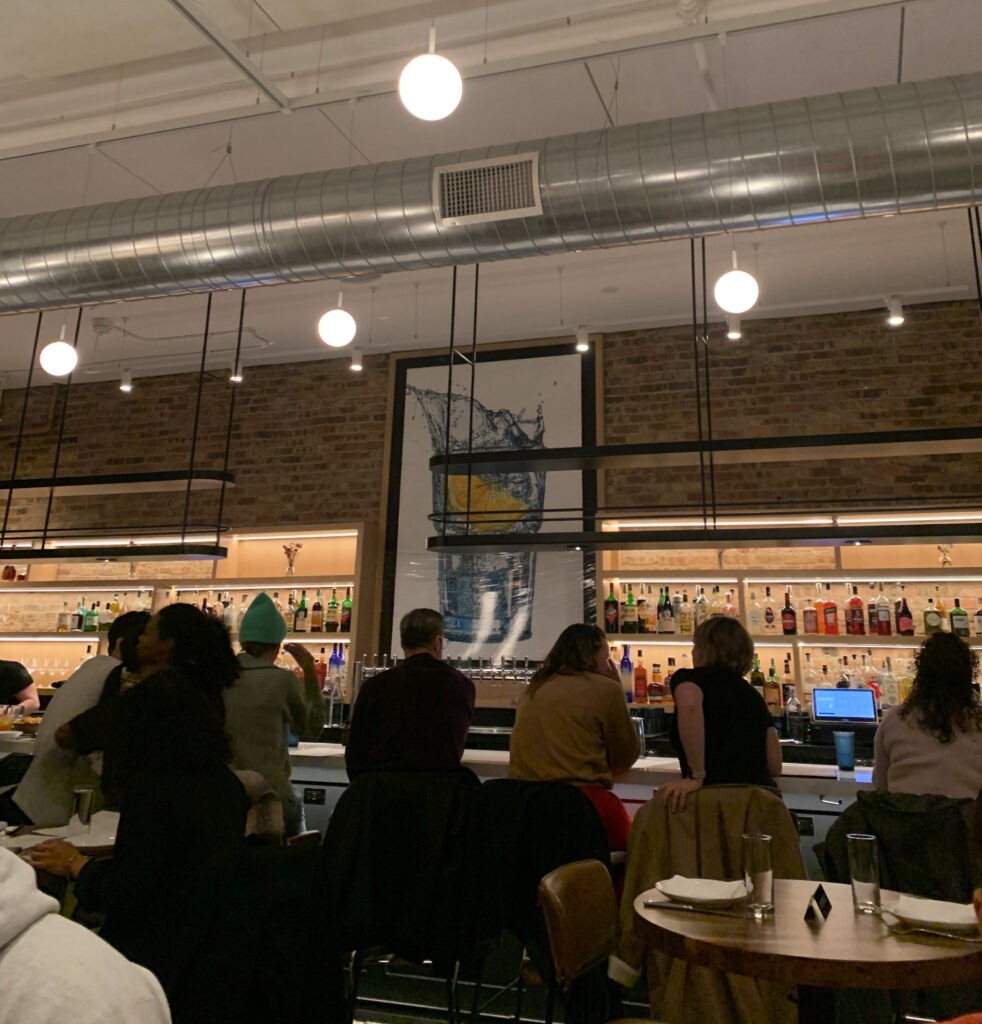
Between the banquettes and the booths, you find the main floor with rows of three two-top tables that can be adjusted to accommodate different party sizes. On the other side of the banquette (that is, roughly straight ahead if you are standing at the café counter), you do not find the same style of seating. Instead, a solitary row of high-tops runs along the floor. This is due to the fact that, along the eastern wall, you encounter the restaurant’s bar: 11 seats positioned in front of a counter (and on top of tile) that mimics the design of the café. This area—reserved, like the high-tops, for walk-in guests—is defined by three tiers of shelving stocked with wine, liquor, and glassware. At the very center of the bar, you note a draft system with 16 taps and, above that, a photorealistic image of an orange slice cannonballing into a glass of water.
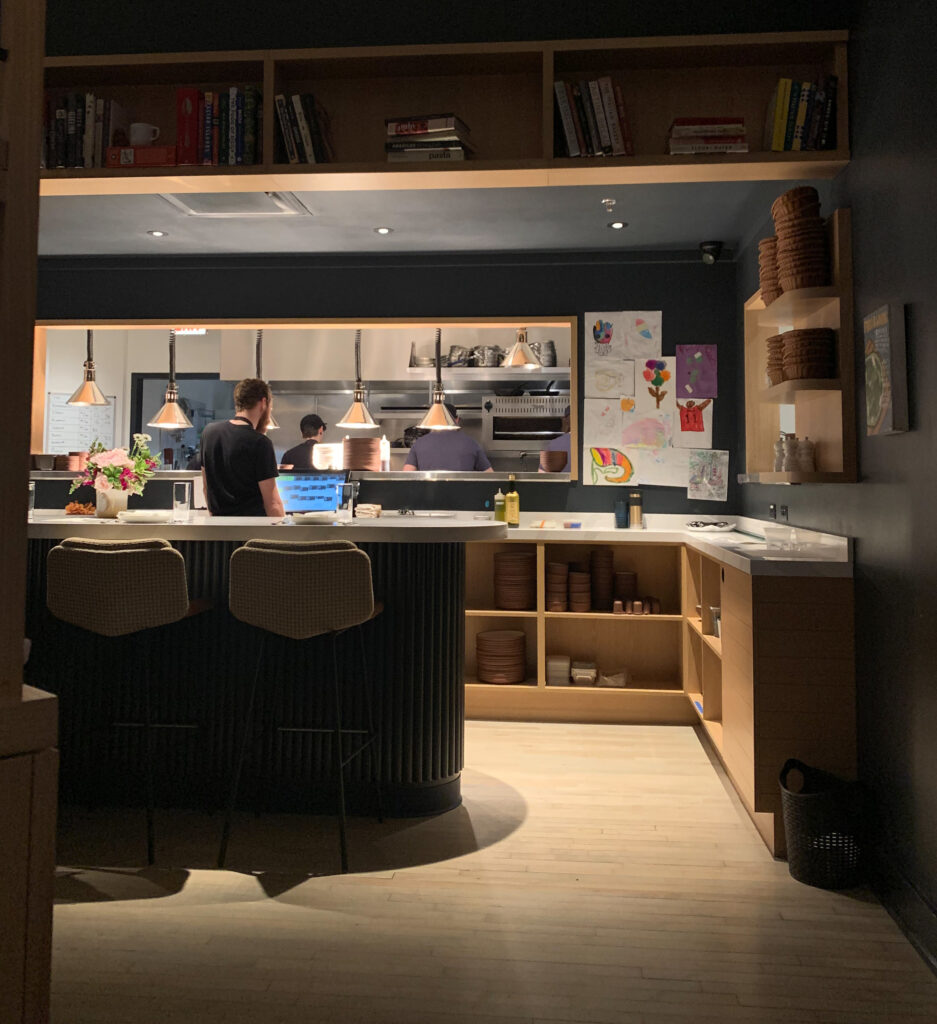
At the rear of the dining room, you find the kitchen, which is set into a bluish-gray, irregularly curved wall. A set of open windows provide a peek at all the action while, in front of the pass, you find a chef’s table with four stools. Framing the kitchen from above is a curved shelf containing artfully scattered cookbooks and other bric-a-brac. You note American Sfoglino, The Art of Fermentation, Flour + Water, Koji Alchemy, SPQR, and Wine Simple among the titles.
Should you follow the bend of the kitchen toward the dining room’s corner (straight past the bar), you encounter the bathrooms. Going further, you come upon the “pasta and pastry production room” that offers additional, “quieter” seating for dinner. This space, too, is perpetually filled and can also be observed by peering through the building’s rear windows that look out onto Fullerton.
Overall, unless you are facing the bar or the kitchen, the Daisies’s design feels a bit bare (the paintings on the western wall should really be hung). The furniture, you must also admit, is more functional than it is comfortable. However, the range of colors and materials chosen for the restaurant is undoubtedly pleasing to the eye. Lighting is well managed (bright enough to see, dark enough to feel sexy), and the place is always packed (without seeming particularly noisy). Thus, you enjoy being in the dining room even if it lacks a little charm or personality. Moreover, the space effectively transmits the surrounding community’s energy—broadening that sense of a “neighborhood place” beyond what “1.0” was capable of—in a way that privileges what diners bring to the table more than any heavy-handed flourishes.
Upon taking your seats, a busser quickly appears to provide water. (Should anyone request sparkling, you are brought an individual glass that has already been filled somewhere out of sight. In practice, you have found that you must sometimes keep requesting subsequent glasses rather than the need for a refill being anticipated—not exactly the kind of service you would typically tip 25% for.)
While waiting to be greeted by your server (something that usually only takes a couple minutes—but more on that later), you have a chance to browse the beverages. Cocktails and non-alcoholic creations now fall under the purview of beverage director Alan Bradshaw (formerly of Estela in New York City and Gwen is Los Angeles). The libations are described by the staff as “leaning on the vegetal side,” and that makes sense when you consider the restaurant utilizes “repurposed kitchen scraps to produce housemade syrups, shrubs, and infusions.”
Of the seven or eight cocktails offered on Daisies’s menu at any given time (all priced from $14-$16), you have sampled four (two of which you have tried multiple times).
The “Mushroom Margarita” (Milagro Silver, fermented mushroom, lime, carbonated) has been described by Frillman as “purposefully there to push boundaries.” This drink, you might remember, was inspired by the chef-proprietor’s experience with a “mind-blowing” mushroom cocktail at Blue Hill at Stone Barns. The “body” and “umami” of that libation caused him to ask, “what is a margarita in the Midwest?” And that led to the idea of infusing tequila with mushrooms, straining them out, pressing and fermenting the pulp, dehydrating it, and turning it into a powder used to rim the glass. (As of late, it appears this powder is no longer utilized.)
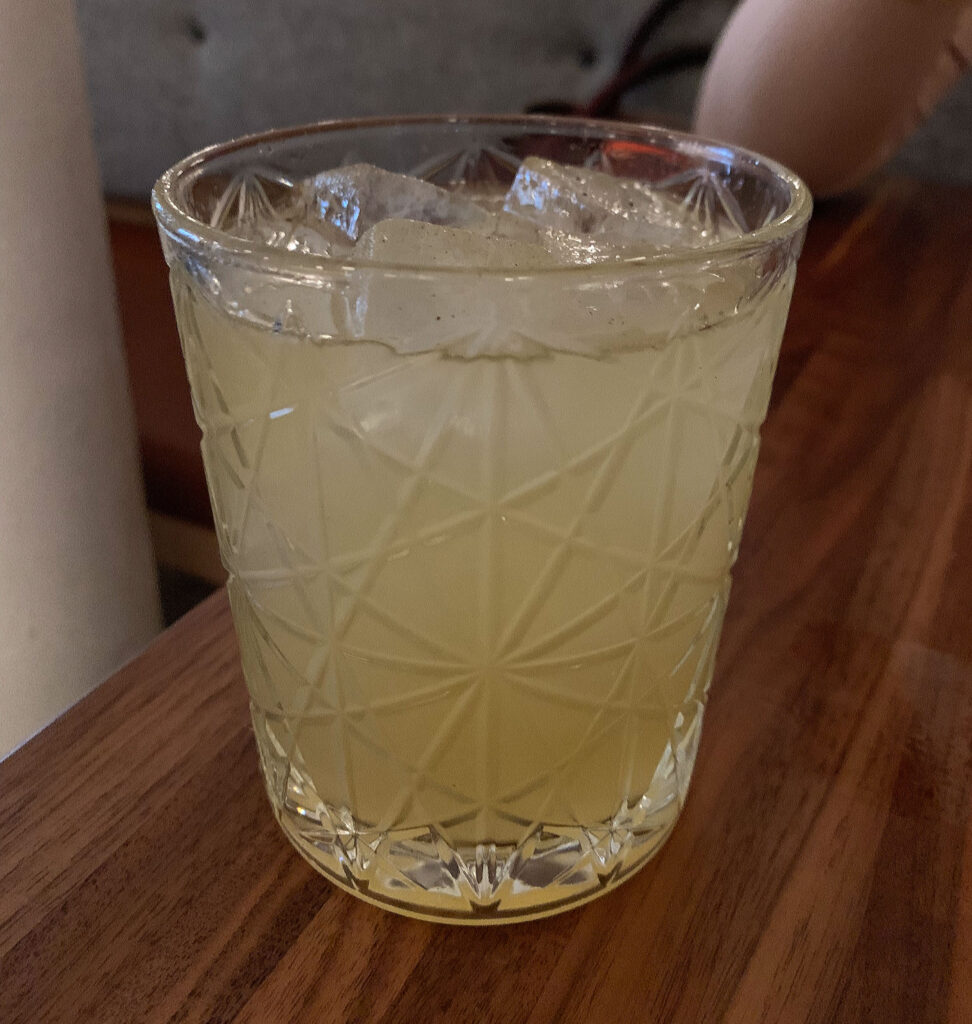
Across two visits, you have found the “Mushroom Margarita” to offer a mild degree of umami that is, indeed, interesting. However, it lacks the sharp, tangy acidity you desire from such a drink and displays only a light carbonation (that, in larger amounts, may have also made for a more uplifting sensation). You also find yourself missing a bit more sweetness or a zesty touch of triple sec. Sure, these might serve to mute the “boundary-pushing” notes of mushroom; however, in truth, the fungi’s influence is forgettable and only used to justify creating a drink that is unbalanced. It is also worth noting that Blue Hill’s mycology program (both in terms of foraging and cultivation) is far more advanced than whatever Daisies has access to. Thus, replicating one of Stone Barns’s recipes (even at the most basic conceptual level) is more easily said than done.
Of the other cocktails, the “Daiquiri Strikes Back” (three types of rum, lime, sugar, bitters) has proven much more successful across two instances. It offers a rounded, mellow take on the drink with a salted grapefruit quality that tastes like a more layered take on the Hemingway special. Well done. The “Scarpetta” (whiskey, mirto, cherry, lemon, egg white) sounds like a frothy, refreshing beverage and, in fact, does offer a mixture of jammy fruit and bright acidity. However, the blend is marred by a coarse, bitter, and somewhat vitamin-like flavor. Lastly, the “Sleeping Dragon” (mezcal, clairin, peppers, lime, Sicilian oregano) draws (like the margarita) upon flavors of fresh produce. However, in this case, the peppers are incorporated decently with the smoky flavors of agave, with a certain savory quality and notes of spice providing additional complexity. This has been your second favorite of the bunch (though not something you would necessarily order again).
In contrast, you have found that Daisies’s non-alcoholic options far surpass what the bar is doing with a liquor. A “Seasonal Kombucha” ($6), inspired by applejack brandy (and flavored with green apple and chamomile), displays a brilliant roundness and depth of sweet fruit flavor balanced by a tart, fizzy finish. Meanwhile, a housemade “Root Beer” ($6) is a stunning example of the form that strikes you with its complex, caramel/malty/sassafras character but no trace of sticky, sickly excess. You would very happily order either of these again.
Alongside the cocktails and non-alcoholic offerings, you find nearly a dozen beers in varying styles from local producers (like Is/Was, Lagunitas, Maplewood, Marz, Moody Tongue, Penrose, and Pipeworks) alongside a solitary cider. Also, on this page (opposite the food), are listed the wines by the glass. As it happens, wine director Katherine Sturgill left Daisies just before the first of your visits. She has yet to be formally succeeded in that role (one that also involves doubling as a general manager), so it is best to view the program as still principally reflecting her influence.
As stated on the introduction page that once preceded the bottle list, Sturgill’s focus was on “both Italian and domestic wines made from environmentally and socially responsible wineries, many of which are small and family-owned.” Additionally, each selection was made due to its “unique beauty” and “flavors that are complimentary [sic]” to the “dinner menu.”
Over the course of your meals, the by-the-glass selection has included:
Sparkling
- NV Borgoluce “Lampo” Prosecco di Treviso Brut ($14)
- 2019 Illinois Sparkling Co. “Ombre” Rosé Illinois ($14)
- 2021 Carafoli “La Divina” Lambrusco di Sorbara ($12)
White Wines
- 2021 Marco de Bartoli “Vignaverde” Terre Siciliane [100% Grillo] ($16)
- 2022 La Marea “Kristy Vineyard” Albariño Monterey County ($18)
- 2020 Colterenzio Pinot Grigio Alto-Adige ($14)
- 2021 Sfera “Bianco” Colli Orientali del Friuli [100% Ribolla Gialla] ($15)
- 2021 Sandhi Chardonnay Central Coast ($15)
- 2021 Brea Wine Co. Chardonnay Santa Lucia Highlands ($15)
- 2022 Cantine Barbera “Tivitti” Mefi [100% Inzolia] ($12)
Orange/Rosé
- 2022 Modales “Contact” Fennville [Rkatsiteli/Pinot Blanc] ($13)
- 2021 Mari Vineyards “Bestiary Ramato” Pinot Grigio Old Mission Peninsula ($16)
- 2021 Forlorn Hope Rosé California ($15)
- 2021 Day Wines “Babycheeks” Rosé Rogue Valley ($14)
- 2021 Nicosia “Lenza di Munti” Etna Rosato ($15)
Red Wines
- 2020 Portelli Vittoria Frappato ($14)
- 2022 Martha Stoumen “Post Flirtation” California [Zinfandel blend] ($19)
- 2021 Presqu’ile Pinot Noir Santa Barbara County ($15)
- 2019 G.D. Vajra “Able” Barolo [Coravin] ($30)
- 2022 Paolo Scavino Barbera d’Alba ($15)
- 2022 Jolie Laide “Glou d’Etat” California [38% Valdiguié/33% Mourvèdre/17% Grenache] ($16)
- 2022 Stolpman “La Cuadrilla” Ballard Canyon [60% Syrah/30% Grenache] ($16)
- 2019 Movia Cabernet Sauvignon Goriška Brda ($15)
Immediately, you must note that Daisies “2.0” has seen the wine program, formerly focused solely on domestic bottles (with a value-driven, “natural” bent), expand to include Italian offerings. This is a smart strategy, for the restaurant now likely has more cellar space to work with and can draw on many more options to choose from when filling it. You also think the wines of Italy form an interesting complement to Frillman’s food, revealing how classic pairings morph in accordance with his decidedly Midwestern take on the country’s recipes and forms. Fermented grape juice, in this manner, forms a lens through which the nuances of culture and flavor are better understood: how do the products of different (yet spiritually connected) terroirs compare and contrast?
To that point, it is nice to see bottles from Illinois and Michigan featured by the glass. While the latter state is represented by two esoteric orange wines, the former represents an attractive value in the popular sparkling category. This means, courtesy of the Illinois Sparkling Co., diners get the rare thrill of drinking wine made in their own state.
Elsewhere, you appreciate that the by-the-glass selection stays mostly within the $12-$16 range (something that accords with Daisies’s peers), with an $18 domestic Albariño, a $19 Zinfandel blend, and a worthwhile $30 Barolo being the exceptions. Further, while the popular Sauvignon Blanc variety is missing, the options run the gamut from Pinot Grigio, Chardonnay, and California rosé, to Pinot Noir, Rhône-style blends, and Cabernet Sauvignon.
While two of the Italian white wines featured, made from the Grillo and Inzolia grapes, are fairly obscure, they may help to prompt a conversation with the staff regarding their characteristics. Otherwise, the Prosecco, Lambrusco, Ribolla Gialla, Etna Rosato, Frappato, Barbera, and aforementioned Barolo are all representative and approachable. Otherwise, when it comes to domestic, the Sandhi Chardonnay, Martha Stoumen “Post Flirtation,” Presqu’ile Pinot Noir, Jolie Laide “Glou d’Etat,” and Stolpman “La Cuadrilla” comprise some of the best values available in the country. These are vibrant, drinkable, largely “natural” (though not in the polarizing way) wines you would be more than happy to have in your glass. Overall, this is a very smart by-the-glass assortment from Sturgill.
However, as always, it is the bottle list that really catches your attention. The following are representative selections drawn from the period of your visits:
Sparkling
- 2022 Illinois Sparkling Co. “Illnatic” Extra Brut Rosé Illinois ($50)
- Mari Vineyards “Simplicissimus” Michigan ($58)
- NV Ca’ Del Bosco “Cuvée Prestige” Franciacorta ($95)
- NV Fergettina Franciacorta Brut Rosé ($100)
White
- 2021 Alois Lageder Pinot Grigio Alto-Adige [375mL] ($25)
- 2021 Hermann J. Wiemer Riesling Seneca Lake ($52)
- 2021 Marland Sauvignon Blanc & Sémillon Lake Michigan Shore ($52)
- 2021 Brooks Riesling Willamette Valley ($56)
- 2020 Lieu Dit Chenin Blanc Santa Ynez Valley ($58)
- 2021 Elena Walch “Castel Ringberg” Sauvignon Blanc Alto-Adige ($68)
- 2021 Benanti Etna Bianco ($74)
- 2021 Venica & Venica “Ronco del Cerò” Sauvignon Blanc Collio ($75)
- 2021 Massican “Annia” Napa Valley [51% Tocai Friulano/33% Ribolla Gialla/16% Chardonnay] ($89)
- 2021 COS “Zibibbo in Pithos” Terre Siciliane ($100)
- 2021 Matthiasson “Linda Vista Vineyard” Chardonnay Napa Valley ($105)
Orange
- 2021 Union Sacré “l’Orangerie” Arroyo Seco ($57)
- 2021 Ca’ del Prete “Bianco a Metà” Piemonte ($65)
- 2017 Maradei “Danfora” Calabria ($74)
Rosé
- 2021 Sergio Drago “Rosa” Terre Siciliane ($54)
- 2022 A Tribute to Grace Rosé of Grenache ($65)
Red
- 2021 G.D. Vajra Langhe Nebbiolo ($46)
- 2019 Tomassi Ripasso della Valpolicella Superiore ($58)
- 2021 Bow & Arrow Gamay Willamette Valley ($62)
- 2020 Guido Porro “Camilu” Langhe Nebbiolo ($68)
- 2021 Tenute Silvio Nardi Rosso di Montalcino ($68)
- 2021 Railsback Frères “Cuvée Spéciale Le Carignan” Santa Ynez Valley ($70)
- 2016 Westrey Pinot Noir Willamette Valley ($70)
- 2021 Podere Grattamacco Bolgheri Rosso ($72)
- 2019 Frog’s Leap Cabernet Sauvignon Napa Valley [375mL] ($78)
- 2018 Felsina “Berardenga” Chinati Classico ($85)
- 2021 Lo-Fi Pinot Noir/Trousseau Santa Barbara County ($92)
- 2017 Rhys “Alesia” Pinot Noir Santa Cruz Mountains ($92)
- 2016 Monte Zovo Amarone della Valpolicella ($95)
- 2018 Produttori del Barbaresco Barbaresco ($115)
- 2018 Andrea Oberto Barolo ($120)
- 2018 Miner Family Vineyards “Emily’s” Cabernet Sauvignon Napa Valley ($120)
- 2019 Piedrasassi “Rim Rock” Syrah Arroyo Grande Valley ($120)
- 2019 Figgins “Figlia” Walla Walla Valley [Merlot/Petit Verdot] ($150)
- 2015 Nicolas-Jay Pinot Noir Willamette Valley ($150)
- 2016 Prà “Morandina” Amarone della Valpolicella ($170)
- 2019 Passopisciaro “Contrada G” Terre Siciliane ($180)
- 2017 Sassetti Brunello di Montalcino ($190)
- 2016 Sesti Brunello di Montalcino ($230)
- 2017 Paolo Bea “Pagliaro” Sagrantino di Montefalco ($260)
This list is certainly a far cry from the $39 or $59 format Daisies “1.0” maintained at launch, and that is not a bad thing. There is still quite a range of options under $60, with some like the Brooks Riesling, Lieu Dit Chenin Blanc, and G.D. Vajra Langhe Nebbiolo being quite nice. Likewise, the majority of bottles still land under $100, with wines like the Benanti Etna Bianco, Venica & Venica Sauvignon Blanc, Massican “Annia,” Lo-Fi Pinot Noir/Trousseau, and Rhys “Alesia” all being well worth the money.
North of $100, you find some appealing choices: the COS “Zibibbo in Pithos,” Matthiasson “Linda Vista Vineyard,” Produttori del Barbaresco, Piedrasassi “Rim Rock,” Figgins “Figlia,” and Nicolas-Jay Pinot Noir. However, of the very most expensive options, you think only the Passopisciaro really makes sense. For, while the two Brunellos may be at the threshold of being drinkable (with some decanting), the Amarone and Sagrantino are particularly burly styles of wine that demand extended aging. They also, quite frankly, display a level of concentration that you are not sure matches Frillman’s food—which, over the course of your visits, offered a “Grilled ½ Chicken” and “Pork Collar” as its most substantial entrées.
Surely, you think fans of the (relatively more affordable) Cabernet Sauvignon-, Grenache-, and Syrah-, and Zinfandel-based wines on offer may not particularly care about some theoretical pairing so long as they can drink what they like. However, Amarone and Sagrantino are niche categories, and you think the list’s most expensive bottles should be sparkling, white, aged reds, or entry-level reds from top producers. These would represent more sensible splurges for those looking to drink the restaurant’s best.
Otherwise, you must praise Sturgill’s continued work in showcasing wines from Illinois, Michigan, and New York alongside more popular regions like California and Oregon. You think Daisies’s corkage policy ($15 per 750mL, $30 per magnum with no bottle limit that you know of) is also quite fair. Additionally, diners benefit from annotations being provided for all the wines in the full list (this includes the by-the-glass options but not, due to space limitations, on the backside of the dinner menu). Savvily, the restaurant had adopted the best practice of using two or three descriptors for each selection: like “rich, lychee, orange blossom” or “black pepper, savory smoked meats, plum.”
In terms of value, Daisies’s markups range from 70%-150% on top of retail pricing:
- 2021 G.D. Vajra Langhe Nebbiolo ($46 on the list; $26 Wine-Searcher average)
- 2021 Brooks Riesling Willamette Valley ($56 on the list, $24 from the winery)
- 2021 Benanti Etna Bianco ($74 on the list; $33.99 at national retail)
- 2017 Rhys “Alesia” Pinot Noir Santa Cruz Mountains ($92 on the list; $49 from the winery)
- NV Ca’ Del Bosco “Cuvée Prestige” Franciacorta ($95 on the list; $42.99 at national retail)
- 2018 Produttori del Barbaresco Barbaresco ($115 on the list; $48.99 at local retail)
- 2019 Piedrasassi “Rim Rock” Syrah Arroyo Grande Valley ($120 on the list; $55 from the winery)
- 2019 Figgins “Figlia” Walla Walla Valley [Merlot/Petit Verdot] ($150 on the list; $59.99 at local retail)
- 2017 Sassetti Brunello di Montalcino ($190 on the list; $79.99 at national retail)
- 2017 Paolo Bea “Pagliaro” Sagrantino di Montefalco ($260 on the list; $119.99 at national retail)
You think paying this kind of premium is fair by Chicago standards, and it is worth mentioning that the cheaper, more accessible wines tend to be marked up less than the more limited, expensive offerings. Considering that oenophiles always have the option of bringing their own wine (and that some of the pricier bottles would benefit from cellaring), you appreciate this strategy. For, ultimately, it works to put good wine in the entry-level customer’s glass without totally fleecing those who want something finer.
This all being said, you do have a few other critiques to make. First, you do not find the “Sparkling,” “Orange,” or “Rosé” sections to be all that appealing. They are missing some of the benchmarks you might want from these categories (Cruse Wine Co., Radikon, Bedrock), and, second, the same goes for the “White” and “Red” sections too (where you would like to see producers such as Arnot-Roberts, Frank Cornelissen, Evening Land, Giacosa, Graci, Occhipinti, Phelan Farm, E. Pira, Vini Rabasco, Roagna, Tiberio, and Quintarelli featured). Third, considering that Daisies charges up to $135 for caviar supplements, you think it might be worth simply breaking the domestic/Italy dichotomy and featuring actual Champagne. And, finally, you must note that there are quite a few misspellings (especially when it comes to the Italian entries) as well as errors in technical information (like appellation or grape varieties) throughout the list.
This does not take anything away from the great work Sturgill has done. As with the by-the-glass offerings, Daisies can boast a list that is smarter and more modern than most Italian concepts. The program offers variety, accessibility, and value in a way that some Michelin-starred properties do not even come close to. It also maintains a corkage policy for which you could easily forgive these most menial sins. However, with a bit more support from the owners and a slightly more discerning eye, Daisies could truly become a superlative wine destination. Until then, it is a good, solid place to drink for a wide demographic.
When it comes to how wine service is conducted at the restaurant, you must admit that you never had the chance to observe Sturgill in her role. Surely, doubling as a general manager is a bit different than being a dedicated sommelier (or a wine director that largely remains off the floor). However, more overarching responsibilities must have allowed her the freedom to pinpoint parties that were ordering (or bringing in) particularly nice bottles and provide an extra touch.
Instead, with Sturgill gone, wine service is now solely the responsibility of the various servers. Nonetheless, with friendly pricing and help from the annotations to draw on, the team is well equipped to succeed. And, in practice, they do an admirable job: bringing glassware, chillers, additional ice/water for the chillers, decanting wines as requested, and making sure you never run dry. Even the bottles you bring in as corkage, which sometimes (despite an established policy) throw staff for a loop, are received with confidence and warmth. They will even wave the $15 fee with any purchase from the list—an unwritten rule of hospitality that, unfortunately, is not always obeyed.
Yes, Sturgill has clearly done a good job of building a foolproof program and training the team ahead of her departure. Your server has even brought by a complimentary pour of esoteric dessert wine on one occasion (just the kind of frill you would expect from a bonafide somm). So, while you cannot speak to the fluency with which the team makes recommendations when asked, you do find their work hard to impeach. They handle their vinous duties with aplomb for such a casual, approachable restaurant. Their only failings are, indeed, those of Daisies’s service on a broader scale.
You have already described entering the restaurant, being greeted at the host stand, making your way to the table, and having a busser promptly fill your water. These bussers are, in truth, the lifeblood of the restaurant: eagle-eyed, they make perpetual rounds and ensure empty plates are cleared and tables cleaned/reset long before the next dish drops. (Across four visits, you can only count one occasion when you did not have plates and utensils for the next course. In that instance, a runner returned your food to the pass before providing you with these tools themself and returning a moment later.) These bussers, who are only guilty of sometimes being a little too eager (e.g., clearing an empty dish when there is still food on your plate or scampering off while a table is trying to get their attention), even go so far as to ask if your party is enjoying its meal or if there was some problem with an unfinished dish or drink. Overall, they are a kind, soft-spoken presence—being made up entirely of ethnic minorities—whose sharp, steadfast performance makes the strongest case for paying that 25% service charge.
Relative to the bussers, the servers are equipped to give you a spiel about the concept, share daily specials, make recommendations, and explain the restaurant’s policies. They do try to stop by routinely and make sure your table is outfitted with everything it needs (like, say, a different cocktail or glass of wine). However, whereas the bussers are more like floating sentries, the servers are responsible for particular sections. There, they form the sole access points to all of Daisies’s wares and, thus, can form an infuriating bottleneck.
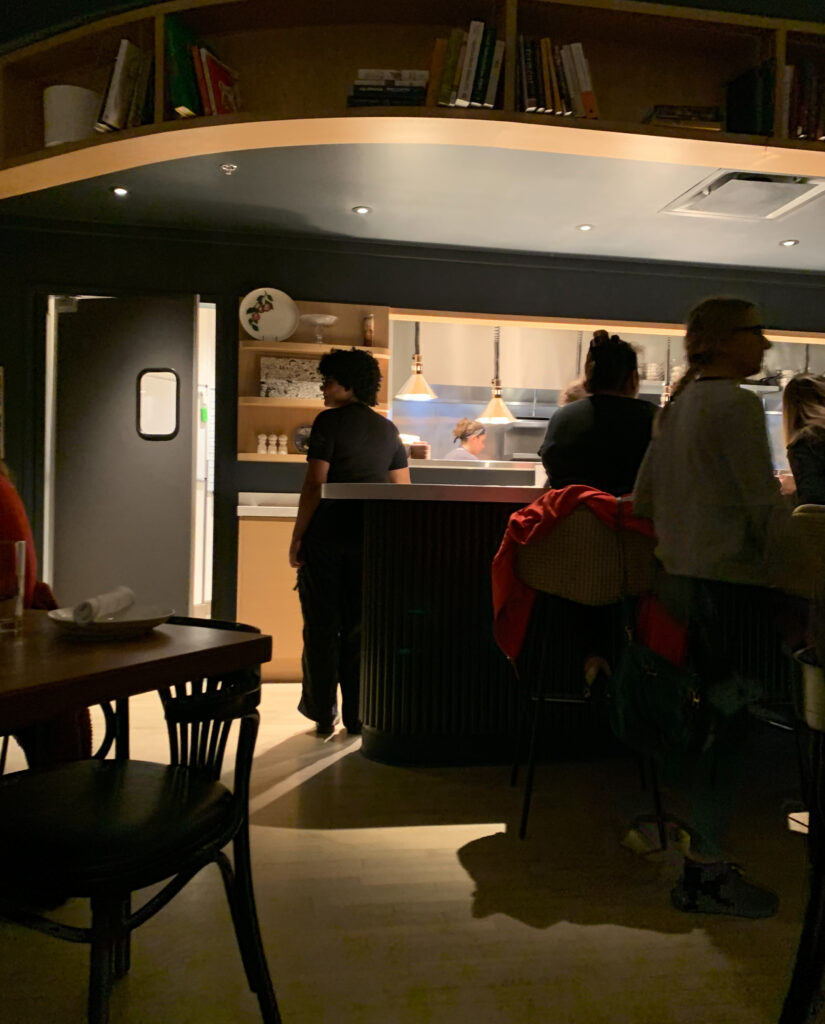
To be fair, having always arrived at the restaurant near the start of dinner service and having always placed your order in a timely fashion, your experience with the servers has been great. Each of the three you have come to know has performed their duties with effortless warmth, deference, and precision. Apart from anticipating your need for more sparkling water (something beyond the scope of the bussers but that one server, at least, got right), you can have no complaints.
Nevertheless, on two occasions, you have observed parties sitting next to you wait as many as 10-15 minutes before being greeted. You know this because the diners complained audibly to each other, wondering whom they might flag down to secure a drink or a morsel of food. In one of the two cases, the server eventually brought a round of Prosecco as a peace offering. You cannot say whether this was judged to be a satisfactory resolution. However, on another occasion, you noted that a different server spent two or three minutes—at the very peak 7 PM point of dinner—chatting with a nice older couple who were positively tickled by what they had read about Daisies. Their conversation, as best as you could hear, was passionate and personal regarding what the restaurant’s policies, the new location, and the sourcing of the food all meant from an employee level.
No doubt, these are the kinds of interactions and connections that make dining so meaningful. Yet, the diners’ interest in the business—gleaned, no doubt, from some fashionable source—felt a bit contrived, and the response given (while rooted in firsthand experience) seemed like a rehearsed spiel in its own right. It may be fair to say that catering to these curious souls, ones who are also fans of what Frillman is doing, has become part of the job in line with the concept’s burgeoning popularity. But, unquestionably, any resulting praise about pay equity or staff retention starts to ring hollow once you realize how much the servers struggle to keep up with the pace of a busy restaurant.
Again, you must admit that you have felt insulated from the worst effects of this problem: you get your wine, place your entire order, and really do not need anything until dessert. However, you certainly recall waiting as many as 20 minutes between savory courses and up to 25 minutes for (largely premade) sweets. This is all to say, there is clearly some inefficiency going on between the front and back of house. Daisies has routinely lagged when operating at full capacity during peak days (Saturday), and servers have not shown themselves to be adept at slowing the bleeding. These could just be growing pains (though certainly not the kind that stood in the way of those rave reviews just two months after reopening) but, here, particularly vexing ones.
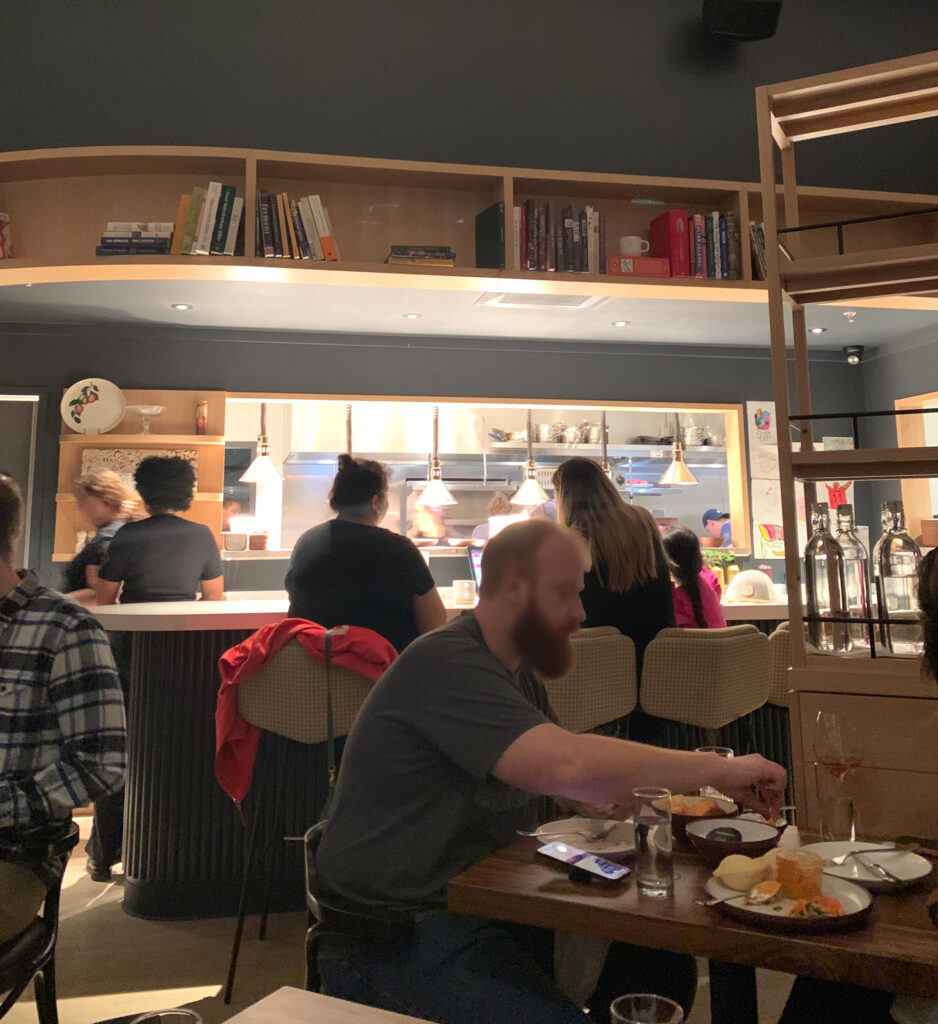
How can any diner be on the hook to pay a 25% surcharge for service that is stretched so thin—that makes a bad impression from the get-go? How praiseworthy really is it for Daisies to distribute that added sum to its employees if the restaurant can barely manage its covers? Apart from the ceaseless work of the bussers, is it not right to question whether the servers are failing at their duties due to a lack of “incentive”? Is it even fair to heap all the expectations the “service charge” carries onto the front of house when, perhaps, raising menu prices would help direct customer ire toward where it belongs: a malfunctioning kitchen? (More on that later.)
Yes, all of the glowing reviews Daisies “2.0” earned seem to take for granted that the restaurant’s service really is exemplary. At the very least, they assume a level of competence that ensures no diner would dare complain. Uproar over the 25% surcharge was framed as a backwards revolt over practices that were undeniably good for the industry. In truth, it represents a rational consumer response: service rarely merits a reward equal to a quarter of your check, and stripping diners of the discretion to decide if it does leaves them wholly at the restaurant’s mercy. You say this as someone who reliably leaves a 22%-28% gratuity for hospitality that hits all the marks. Daisies, at present, has no business charging more than 20% for the level of quality being offered—and to think the restaurant has the nerve to leave a tip line on the receipt (for “exemplary” service) too!
As you think back across your experiences, that round of Prosecco (offered to the couple next to you to apologize for the long wait) was not the only freebie being flung. Across four visits, your server offered complimentary scoops of gelato, a scoop of sorbet, an espresso martini (one full-sized cocktail split between two guests), and those aforementioned pours of dessert wine in turn. This leads you to believe that Daisies, as a policy, empowers the staff to provide these bonus items as a gesture of goodwill. Of course, the cost of these items is negligible, and it is hard not to see them as a means of ameliorating the failures of service and distaste for the service charge under the banner of “generosity.”
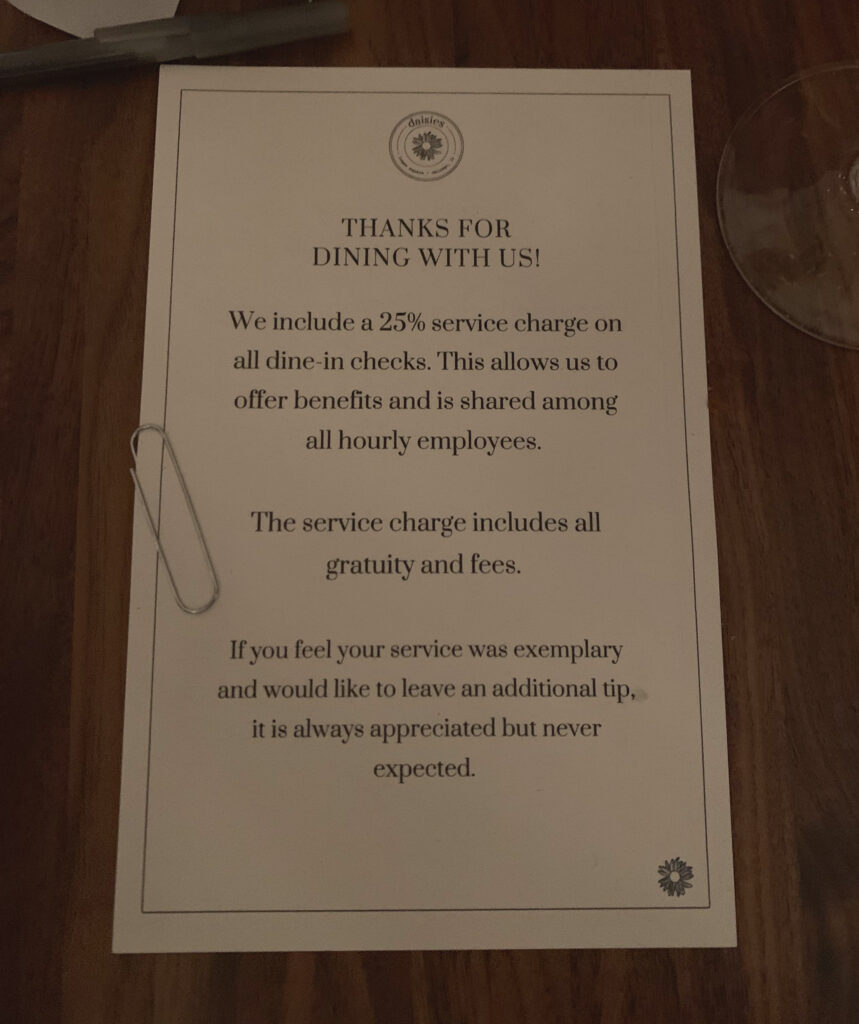
The strategy seems to be: do just enough in the short term to keep diners from complaining while slowly normalizing the 25% fee. With the help of the press, the crowd of 30-, 40-, and 50-somethings—predominantly white professionals clad in dress attire—who patronize Daisies actually feel they are engaging in ethical consumption. (Or, maybe, they will simply pay any price to eat somewhere trendy.) What matters is that Frillman got his foot in the door and is working to rewrite expectations about what it costs to eat out in Chicago. But, has the chef-proprietor really built a model for the future or, simply, a means through which he charges well-meaning patsies far more for much, much less?
You support what Frillman is fighting for, but he does a disservice to the cause by propping up service that is, at times, lamentably below average. This makes the whole service charge thing seem like a cynical gimmick, a means for a media-savvy chef to tap into what journalists are desperate to celebrate, rather than the paradigm shift it has been presented as. Convincing Chicagoans this is a meaningful, worthwhile change will take more than freebies and hype. It demands a true hospitality visionary that ensures each and every interaction at Daisies (not to mention each and every dish) proves the point: equitable pay and benefits yields a higher level of performance than what was possible under the old system.
For what it’s worth, the servers do have some help: you typically spy two or three managers working the floor in slightly more formal dress. They are usually hustling from host stand to bar to kitchen but, thankfully, do not view clearing plates or folding napkins as beneath them. Just the same, these managers are not the sort to go around shaking hands, dropping cards, and making sure their patrons are happy. Rather, they help to operate the business without demonstrating that extra degree of ownership. (Omilinsky, in your experience, has also not been particularly friendly behind the pastry counter.)
This behavior is echoed, at the very top, by Frillman himself. You observed the chef-proprietor’s presence during just one of your four visits. Clad in a baby blue cap and hoodie, he kept an eye on things from in front of the pass while joking around with his staff. Only one booth of customers seemed to attract any special attention or conversation. However, you do really respect that Frillman felt comfortable clearing plates, wiping down tables, and folding napkins whenever he noticed these tasks needed to be done.
Again, this speaks to a mechanical expression of ownership that—while admirable—falls short of the emotional experience you idealize. Daisies, of course, is careful to note that it is not really an “Italian” restaurant—the sort of place that lends itself to the romance of a chef-patron who shares in a tableside toast before heading back to the kitchen and executing their personal, soulful cuisine. Perhaps the scale of the restaurant precludes conjuring this sort of spirit even if it was desired (though, again, this is where the right managers could step up). But what happens when you strip this sort of concept of its heritage?
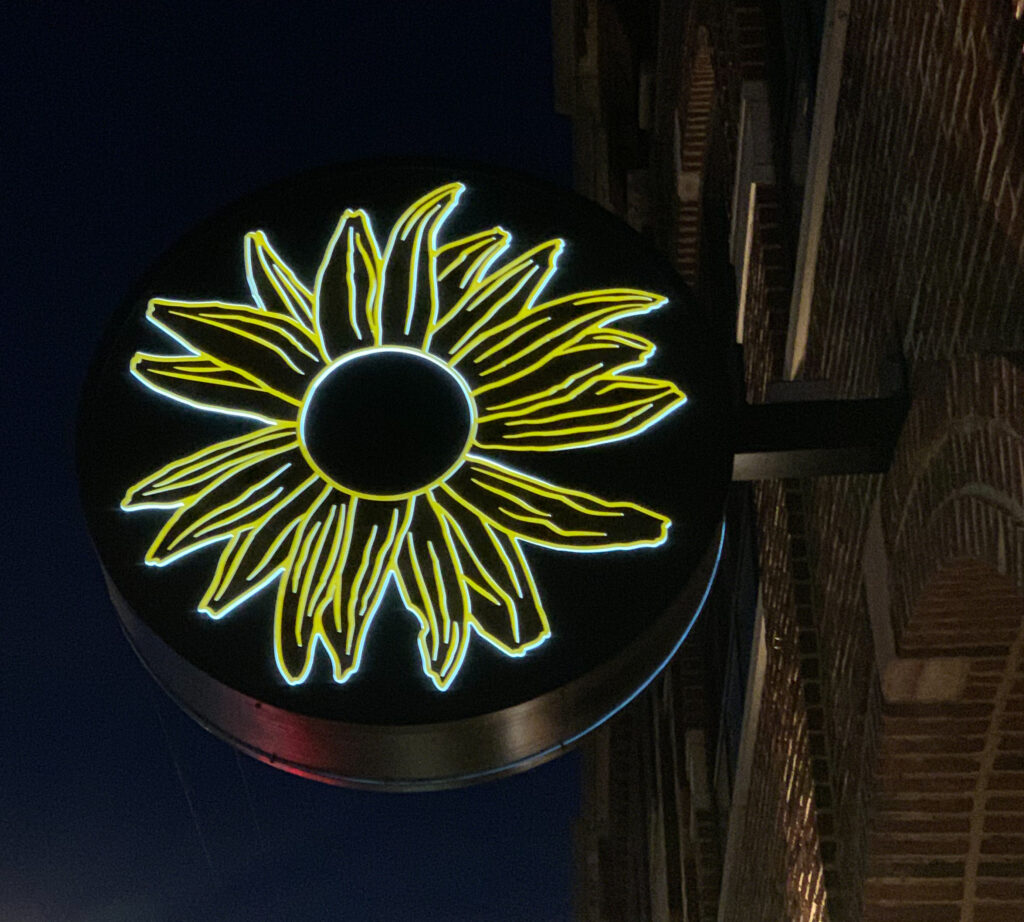
You are left with a place that sells pasta and vegetables at a 25% premium, a place with a businessman-chef you get to know through the media but who leaves the real work to his “head of culinary.” To be fair, you have long let go of any expectation that an executive chef will actually be cooking at a given establishment. But, if they’re not cooking and not personally hosting you—if the servers they have entrusted with curating your experience flounder in the face of an average Saturday night—what are you paying for? To subsidize Frillman Farms and support a restaurant family that makes you feel forgotten? To participate in a progressive compensation scheme (“experiment”) that robs consumers of their agency while rewarding mediocrity?
Daisies claims “if service gets overwhelmed, the restaurant will remove the service charge.” You would like to know how often—if ever—that happens, for it seems all too easy to bring out the Prosecco and remind patrons they’ve already agreed to the extra 25% when booking the reservation.
At the end of the day, Frillman charging a 20% fee (as Kumiko or Smyth does) would hardly be worth mentioning. Some consumers would still complain, but you remain firmly in the realm of “normal” expected gratuity (whatever the additional sum is ultimately put toward). However, with that additional 5%, Daisies raises expectations beyond what the restaurant can satisfy.
25% promises excellence even if it proclaims equity, and relying on friendly journalists—happily spinning one or two superficial visits into a rousing endorsement of practices they personally feel to be just—to obscure that fact is devious. It transforms Chicago’s dining scene into even more of a public relations battle and, by the black magic of psychological priming, leads diners further astray in discerning quality on their own.
Frillman’s heart may sound like it’s in the right place. He and his associates might know all the right things to say in order to tickle those who are predisposed to like what they are doing. But, as a diner judging Daisies against all those doing things in a more traditional (or at least measured) manner, the restaurant is more concerned with its message than with providing substance. Frillman wants to lazily benefit from being “the first”—rather than truly pushing his team to be its best—and it is laughable to see the chef position himself as any sort of leader just because he shoved a service charge down the city’s throat. (If this sounds a little harsh, just wait until you get into the food.)
With your beverage order settled and your server (thankfully) at the ready, it is time to order food. Daisies’s menu, at any given time, includes close to a dozen “Starters,” close to another dozen “Pasta,” and a half-dozen “Proteins.” Over the course of your four visits, certain seasonal items have been excised before you could try them. However, when factoring in their replacements, you have sampled all of the available offerings (save for one or two desserts).
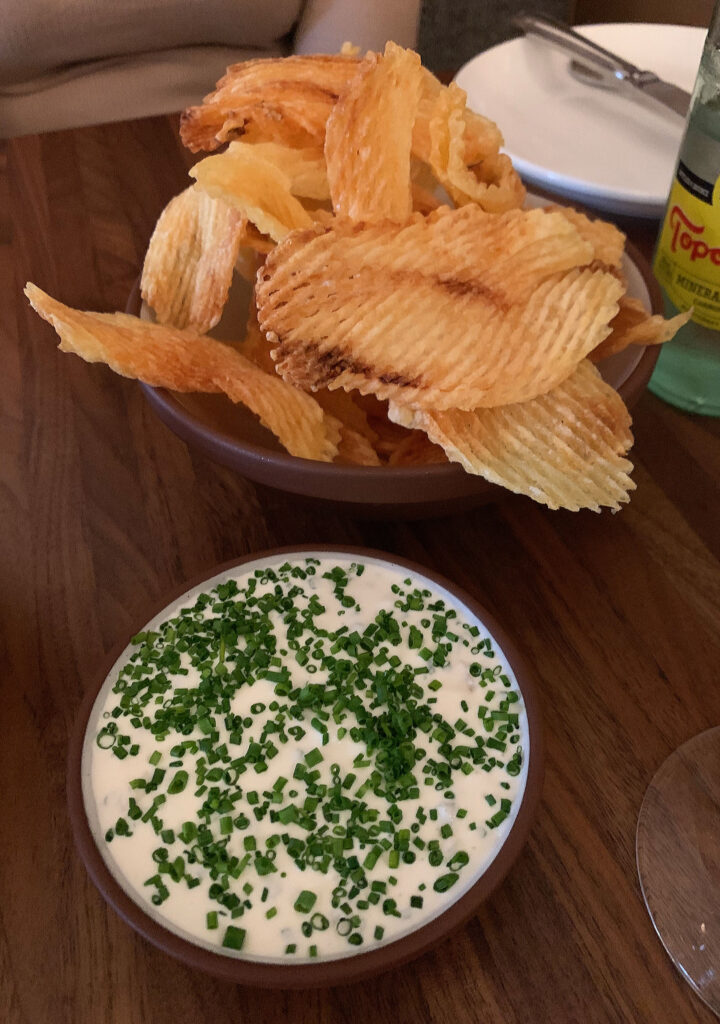
To start things off, you have that old favorite from Daisies “1.0”: the “Onion Dip” ($9) that first appeared on the menu at launch and that references the chips and dip Frillman enjoyed “at family gatherings growing up.” Tapping into this kind of nostalgia is often a surefire strategy for success, and the chef-proprietor artfully conjures a feeling of generosity (via shared snacking) to mark the start of the meal. Plus, to the kitchen’s credit, they typically get this dish on the table within mere minutes of placing the order.
The dish comprises a small ramekin of the namesake dip, blanketed with chopped chives and joined by an overflowing bowl of “housemade ruffles.” Invoking the name of that beloved ridged brand of chip seems like a risky move on the surface. However, Frillman has constructed a near-perfect doppelgänger: large, sometimes twirled, but predominantly flat, grooved, and crispy. Though the chips are just a touch underseasoned for your palate (perhaps a strategic decision that is meant to better showcase the flavor of the onion), they arguably display greater delicacy than their inspiration.
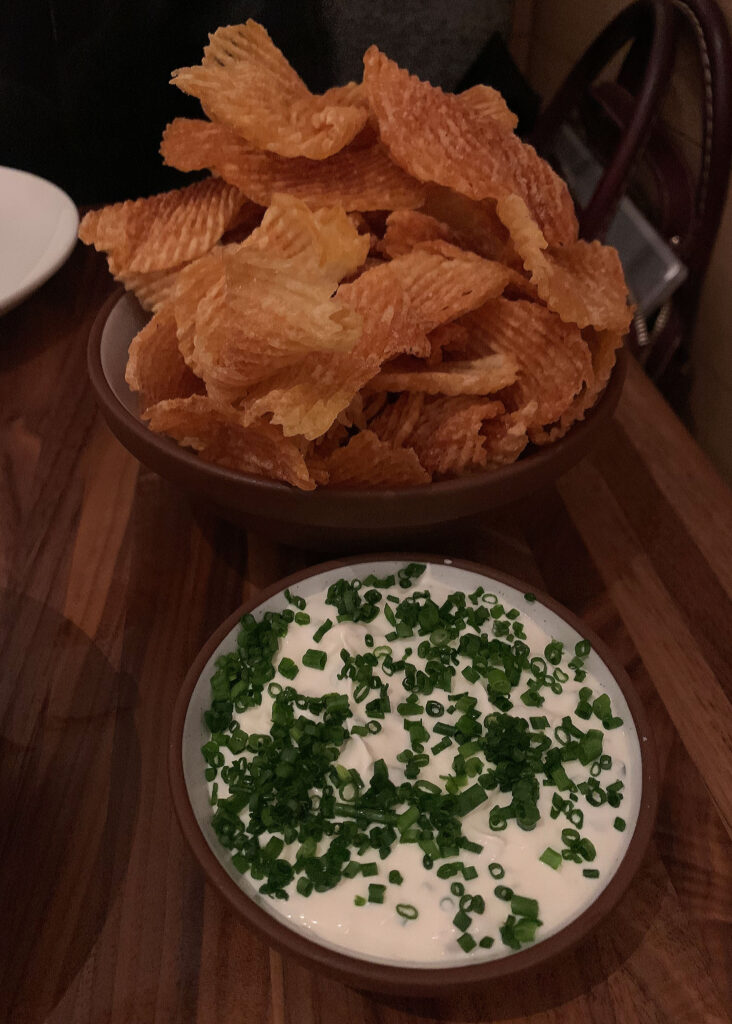
Importantly, the chips retain their structure when dunked into the dip. You can oh-so-easily fall into that mindless habit of sipping, crunching, and making conversation once they appear. However, you cannot say the onion dip adds all that much to the equation. It is tangy, rich, and creamy but not savory—not concentrated with allium flavor—enough to make much of an impression. Of course, the dip kind of provides the dish with its reason for being, but you wonder when the kitchen last took a hard look at this recipe and tried to refine it. As it stands, the chips are a nice snack, and the “Onion Dip,” itself just a bland passenger.
Now, returning to the question of strategy (and to your desire for a bit more salt), Daisies “2.0” has introduced the innovation of offering a “Caviar Supplement for Onion Dip” box in the top corner of the menu. Comprising “Smoked Trout Roe” ($18), “Golden Kaluga” ($60), “Osetra Reserve” ($85), and “Beluga” ($135) options, this quartet of roes allows patrons to gussy up the dish (and provide it with an extra dimension of texture/flavor) without necessarily breaking the bank.
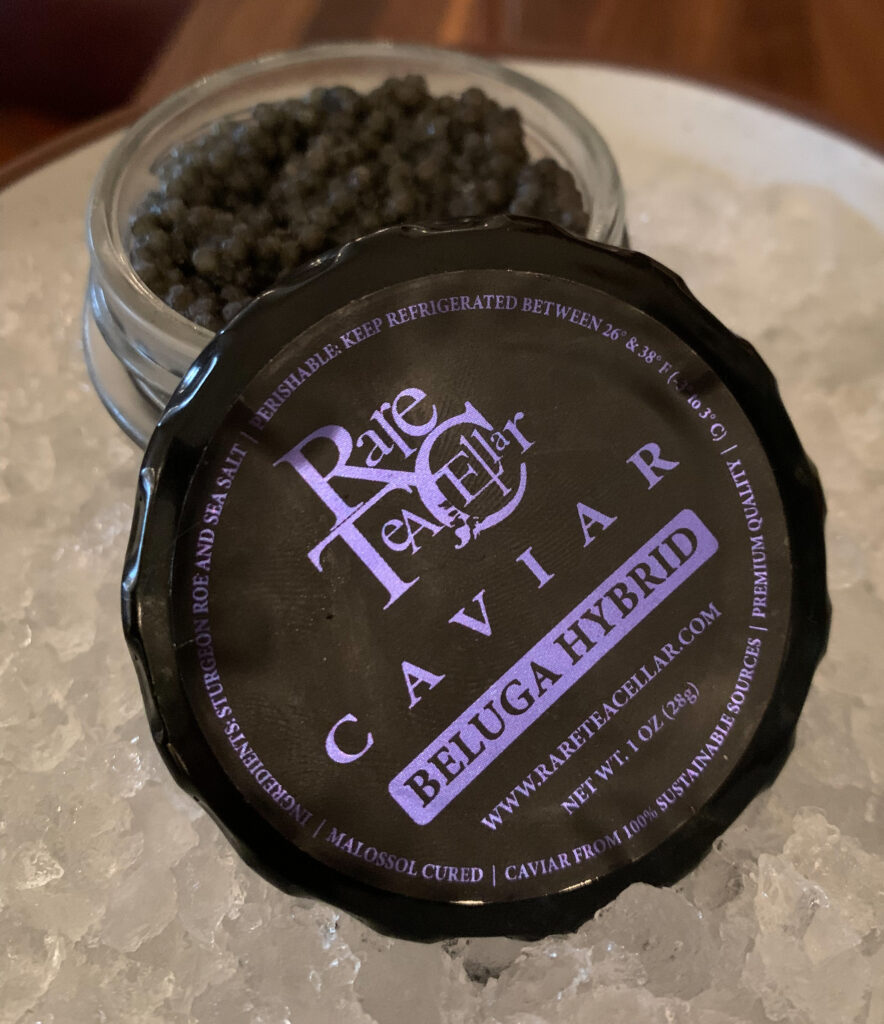
It’s certainly a tempting offer, but one that has presented a couple problems. First, you know that beluga (that is, roe from the Huso huso species of sturgeon) has been banned in the United States since 2005, with only one company (Marky’s) being permitted to produce the product (as of 2020) due to its work sustainably reproducing the fish at an aquafarm Florida. Daisies’s “Beluga” is, in fact, a beluga-siberian hybrid (Huso huso x Acipenser baerii) sourced from Rare Tea Cellar. Now, you can understand using shorthand in some situations, but there is nothing preventing “Beluga Hybrid,” spatially, from fitting in alongside the other supplemental roes. No, you think it is clear that the restaurant greedily wants to trade on the cachet “beluga caviar” still carries despite the ban: it being historically featured as a totemic luxury product across media. Ultimately, Frillman is guilty either of incompetence or deceptive marketing for continuing to sell the hybrid under a more prestigious label.
Yet, it gets worse. Having ordered the “Beluga” supplement during your first visit, you were struck by just how mushy, mushroomy, and just plainly salty the roe was. Hybrid or not, relative to all other species you have tried, the $135 splurge offered no fireworks. Suspicion aroused, you ordered the “Beluga” yet again during your second visit. In this case, the eggs were less slimy and possessed a greater depth of deep-sea flavor. You are still not sure the beluga hybrid surpassed the “Smoked Trout Roe” (kindly offered as a freebie on that occasion) by all that much, but you could at least justify some of the product’s price this time. That being said, the discrepancy between the two experiences disturbed you.
By passing the “Onion Dip” (and its supplement) on your third visit, you gave the dish one last try during your fourth. For whatever reason (perhaps not wanting to take the risk—even if it might provide some final clarification), you opted for the “Osetra Reserve” this time. When the roe arrived, it was mushy and flavorless in the same manner as your initial encounter with the “Beluga.” Now knowing not to second guess your perception, you turned the caviar receptacle over and found an expiration date of “29723” (July 29th, 2023) on a product that was served on November 18th, 2023. Considering that caviar typically has a shelf life of six weeks, this means Daisies served you roe that was a little under 10 weeks past its expiration. While the “Osetra Reserve” did not seem offensively spoiled to your senses, it still presents a health risk given the microbial load the eggs carry even “under the highest hygiene conditions.”
Again, being charitable, Frillman and his kitchen may simply be incompetent. At worst, they are simply unwilling to steeply discount or take a full loss on a pricey ingredient that has gone bad. You will admit that you can understand how the higher-tier roes likely do not see much turnover. However, being served anything that is noticeably expired to such a degree is utterly disgusting. It makes the prospect of paying an additional 25% for the experience laughable, and it calls into question the restaurant’s status as a “community-building” force (that may just poison its neighbors). At the end of the day, the “Caviar Supplement” is a ham-fisted attempt at premiumization from a chef that has no business handling luxury ingredients. The “Smoked Trout Roe” may be a safer bet for those really looking to splurge, but why take the risk?
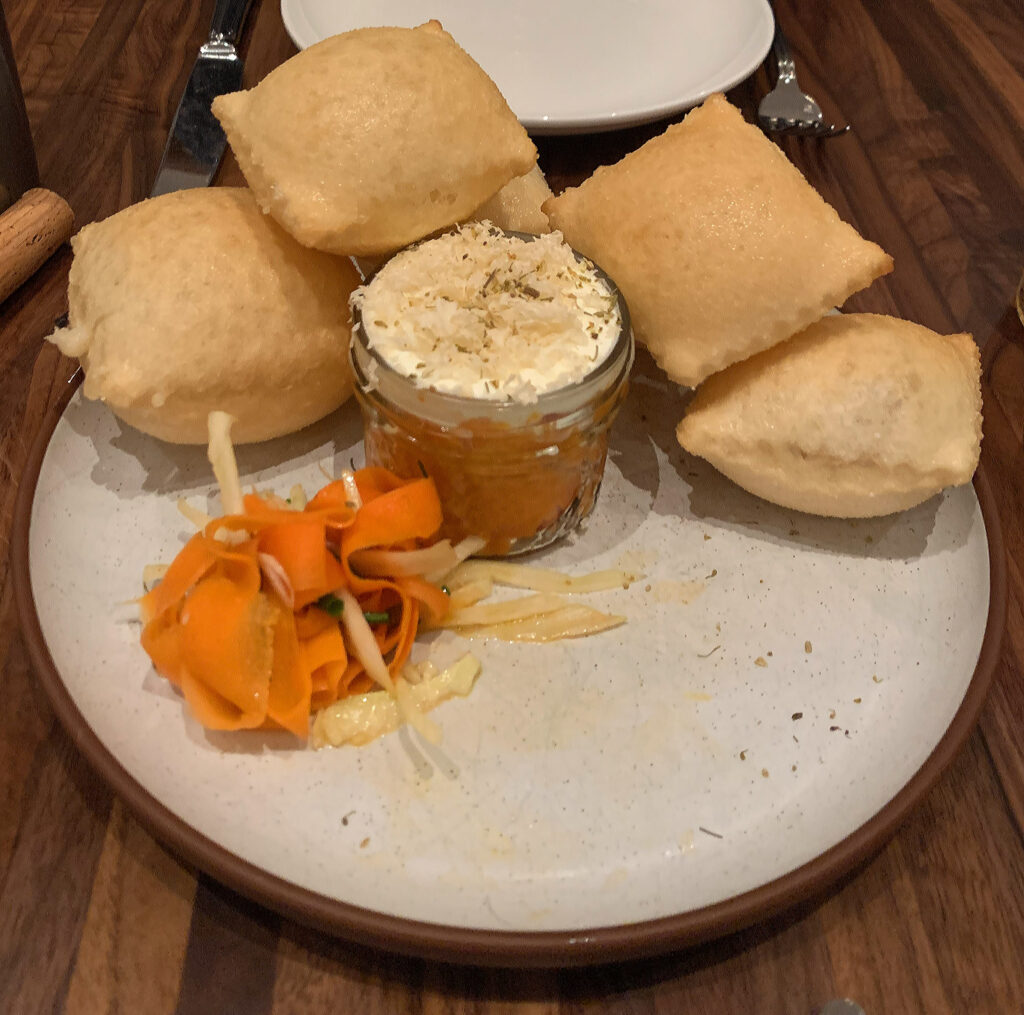
Another longstanding item, dating back to the earliest days of Daisies “1.0,” is a dish of “Potted Carrots.” Formerly known as the “Carrot Rillette,” the preparation was alternatively labeled “just vegetables, treated right” and “almost too subtle” relative to its “bold companions” by critics. It once came served with seeded crackers and toasted sourdough but, in the words of the Tribune, skyrocketed from “starter to stellar” at Daisies “2.0” with the addition of “housemade gnocco fritto.”
At core, the “Potted Carrots” stay true to the rillette form (while ditching a term that has become increasing opaque to the public). The vegetables are shredded, jarred, and slowly cooked before being capped off by a layer of duck fat that is charmingly referred to as a “frosting.” Some long ribbons of pickled carrot join the potted spread on the plate while, stacked temptingly, sit a half-dozen of those gnocci fritti. This fried, puffed bread (that actually bears no relation to the pasta known as gnocchi) has been featured around town at newer Italian spots like Adalina and Ummo, where it is often paired with cheese and charcuterie. However, at Daisies, it stands as a great example of the increased technical ability Omilinsky has brought to the savory side of the menu and even to some of Frillman’s most popular recipes.
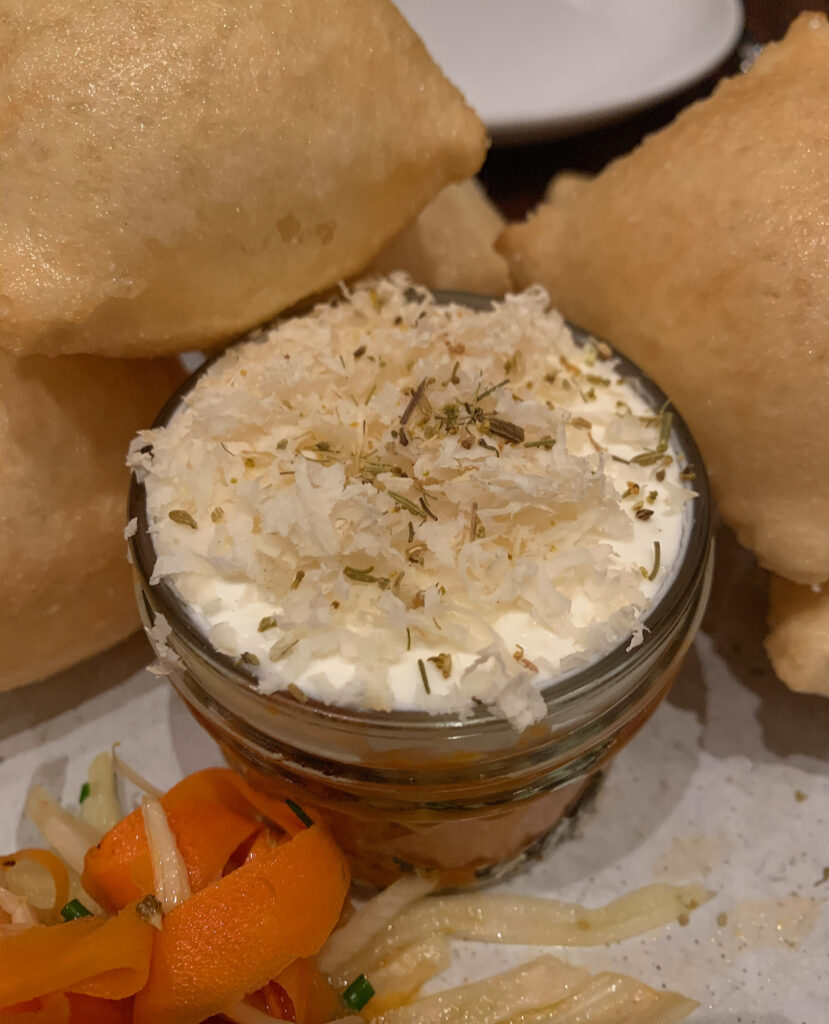
Diving in, the jar’s cap of duck fat yields effortlessly to your fork (no hardened, greasy mass here) and allows you to cleanly extricate a clump of the shredded vegetables. Taken alone, the potted carrots are pleasantly moist, with a subtly crisp texture drawn from the interlacing of so many fine slivers. In terms of flavor, the vegetables are subtly sweet, caramelized, and deeply satisfying thanks to the added layer of richness. As a counterpoint, the pickled carrots are more pronouncedly crunchy and cleansing in their sourness. Meanwhile, the gnocco fritto—when utilized—extends and enhances the sensation of the “rillette.” Arriving warm, they gently render the duck fat without obscuring the carrots’ texture. To be fair, the gnocci fritti do seem just a bit underdone and doughy; however, they largely still satisfy the puffed, airy quality you expect from the form. Plus, relative to crackers or toast, they are simply more charming.
Overall, the “Potted Carrots” make for one of Frillman’s best dishes and deservedly a Daisies classic. The treatment and presentation of the star ingredient epitomize exactly how inventive and enjoyable vegetable-forward preparations can be while, at the same time, the gnocci fritti demonstrate that the restaurant is not done growing. Well done!
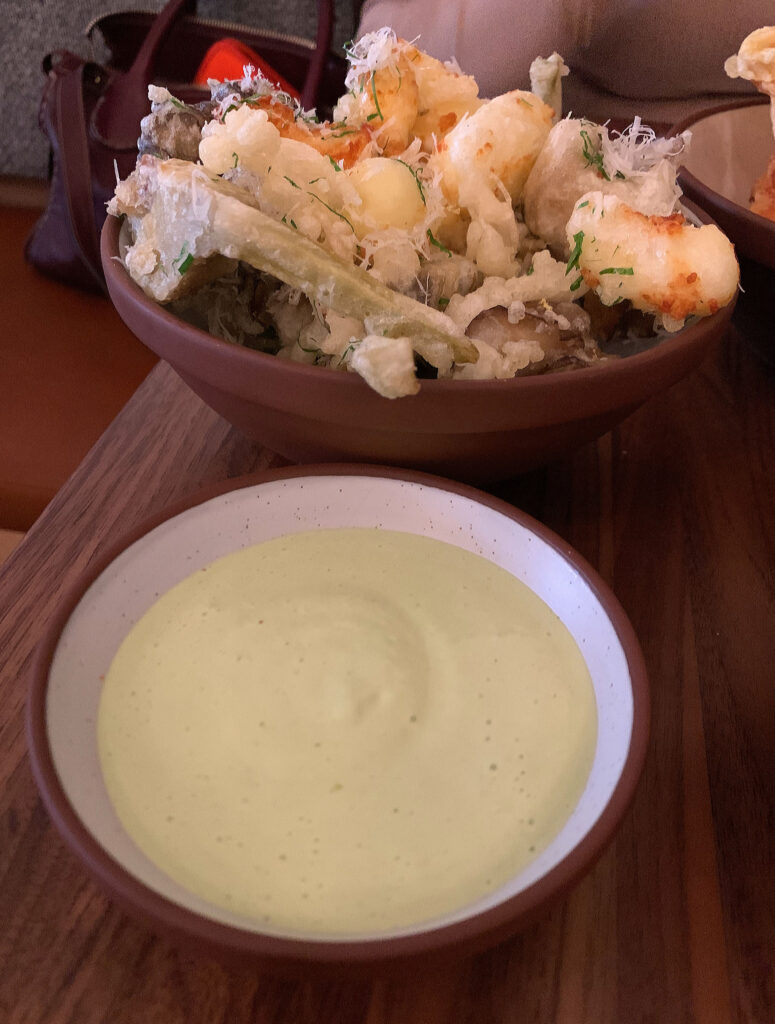
Next, you come to another greatest hit and an item that the restaurant’s very first review (from the Chicago Reader in 2017) claimed is something “Frillman’s future regulars will never allow him to take off the menu.” That pronouncement proved to be prescient, for the dish has changed its name and pricing over the years (from the $9 “Fried Mushrooms” to the $11 “Fried Mushrooms & Cheese Curds” to the $13 “Mushrooms & Cheese Curds”) without really changing in spirit. If anything, with the launch of Daisies “2.0,” Frillman has only upped the ante.
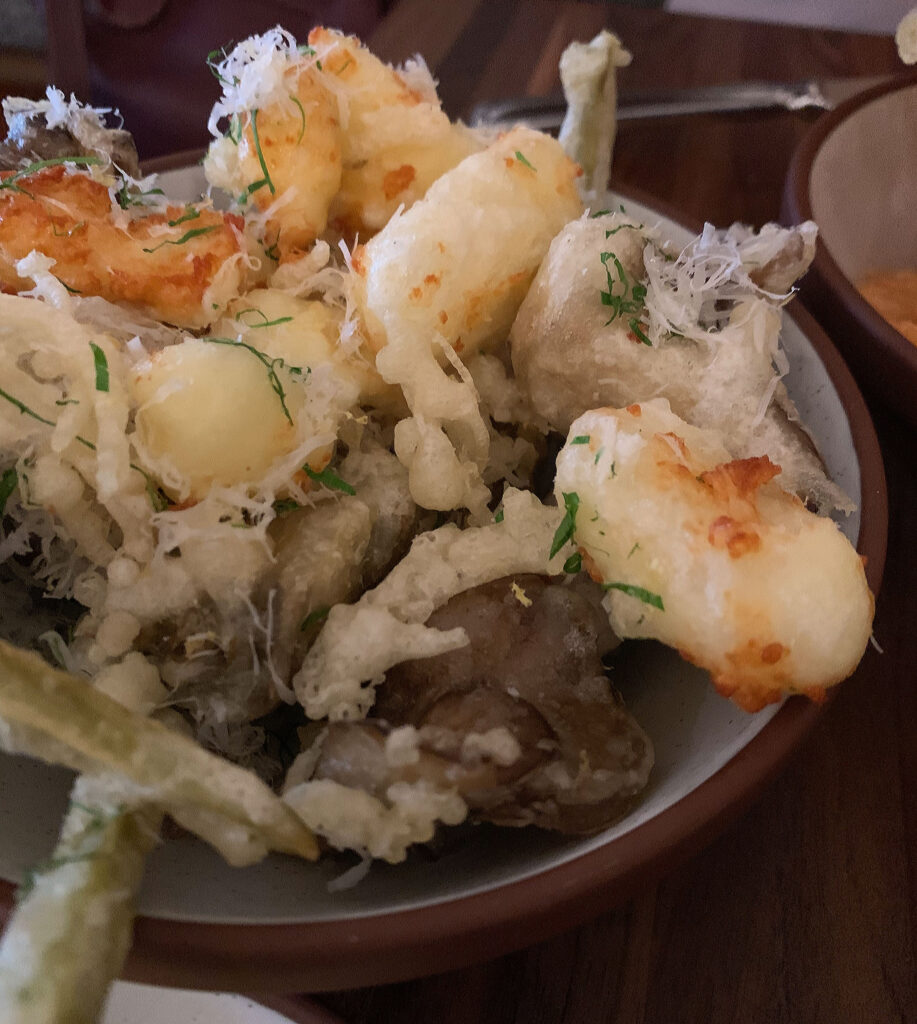
The ”Fritto Misto” ($15), much praised by critics (and by The New York Times in particular), comprises a heaping bowl of tempura-fried mushrooms, cheese curds, and—perhaps justifying the increase in price—artichoke hearts (each complete with a long, edible portion of its stem). This assortment, free of any “airfreighted squid,” has long been paired with a tarragon-buttermilk dipping sauce that is now termed an “aioli.” The move toward some greater utilization of Italian terminology—at a concept Frillman originally didn’t “want to label…as an Italian restaurant”—is curious. However, you think this maneuver, which is only otherwise seen in the naming of the pastas, serves to wink at tradition while preserving the element of surprise that often underlies the chef’s locally-sourced and personal compositions.
On the palate, the mushrooms and artichokes both display a soft but dense and meaty quality that contrasts beautifully with the delicate, flaky-crisp tempura coating. The cheese curds, true to style, are a bit chewier and possess that telltale squeak. Though these three core elements are rendered in a sizeable fashion (something that moderates the influence of the breading and allows you to better appreciate the actual ingredients), you also enjoy crunching on the smaller crispies collected at the bottom of the bowl. In terms of flavor, the “Fritto Misto” itself does not have too much going on: the artichokes are a bit nutty and the mushrooms a tad earthy, but some gratings of parmesan provide the only real savory depth. The tarragon aioli, likewise, is creamy and mildly tangy with undertones of anise; however, it fails to provide any real spark. Overall, this is a good—not great—example of the form that earns points for being vegetarian but is not exactly convincing. You would like to see some hot or pickled peppers incorporated to make the dish’s flavors feel more forceful as the artichokes, mushrooms, and cheese curds do not offer enough on their own.
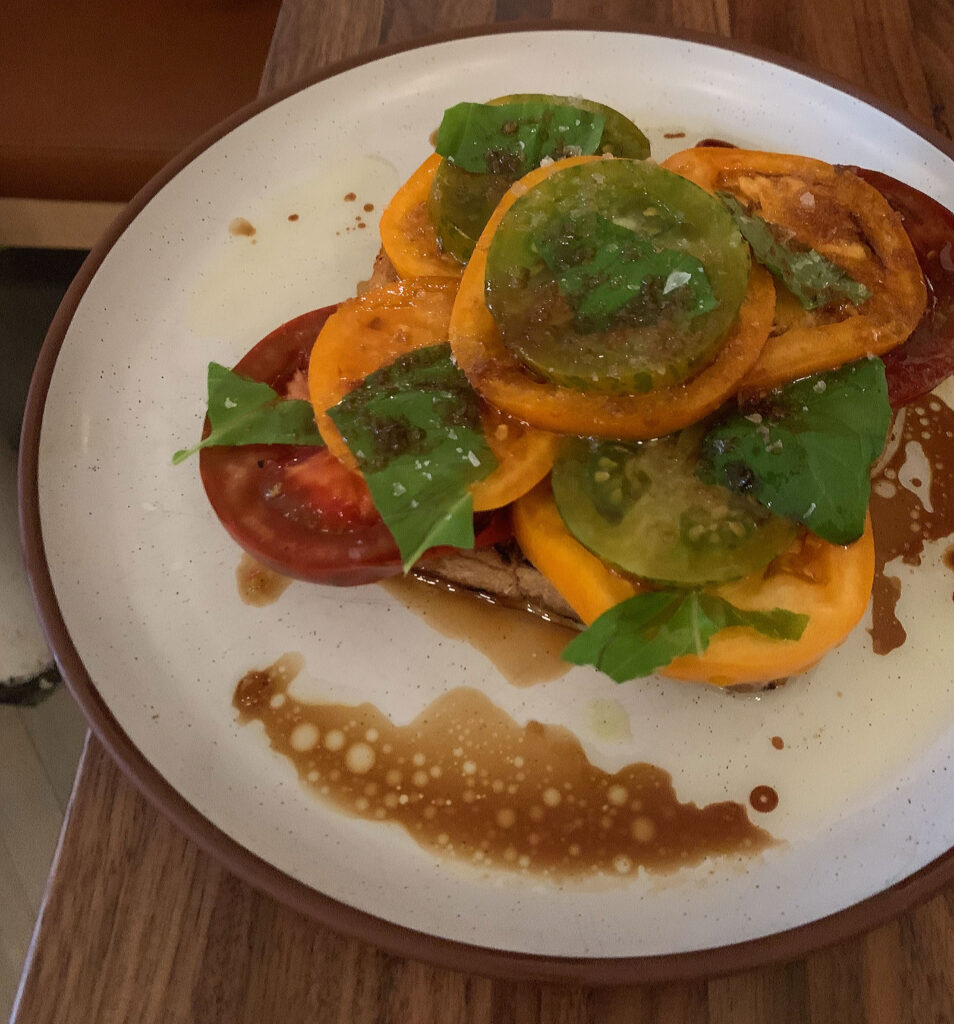
Originally appearing on the menu in 2018, “The Overpriced Tomato” ($18) has become one of Daisies’s seasonal staples. Conspicuously utilizing an ingredient sourced from Frillman Farms, the dish offers a clear chance to taste what the chef’s brother is bringing to the table. Its title (and juxtaposition with “cheap balsamic”) also irreverently highlights the cost of good produce, managing expectations in a way that you think actually allows the preparation to strike guests’ palates with greater force.
The dish comprises a slice of toasted sourdough topped with a pyramid made from 10 heirloom tomato slices (ranging in thickness and color but building toward a center peak). These ingredients are coated in a generous drizzle of molten bone marrow, sprinkled with flaky salt, garnished with leaves of basil, and finished with a spurt of that aforementioned “cheap balsamic.”
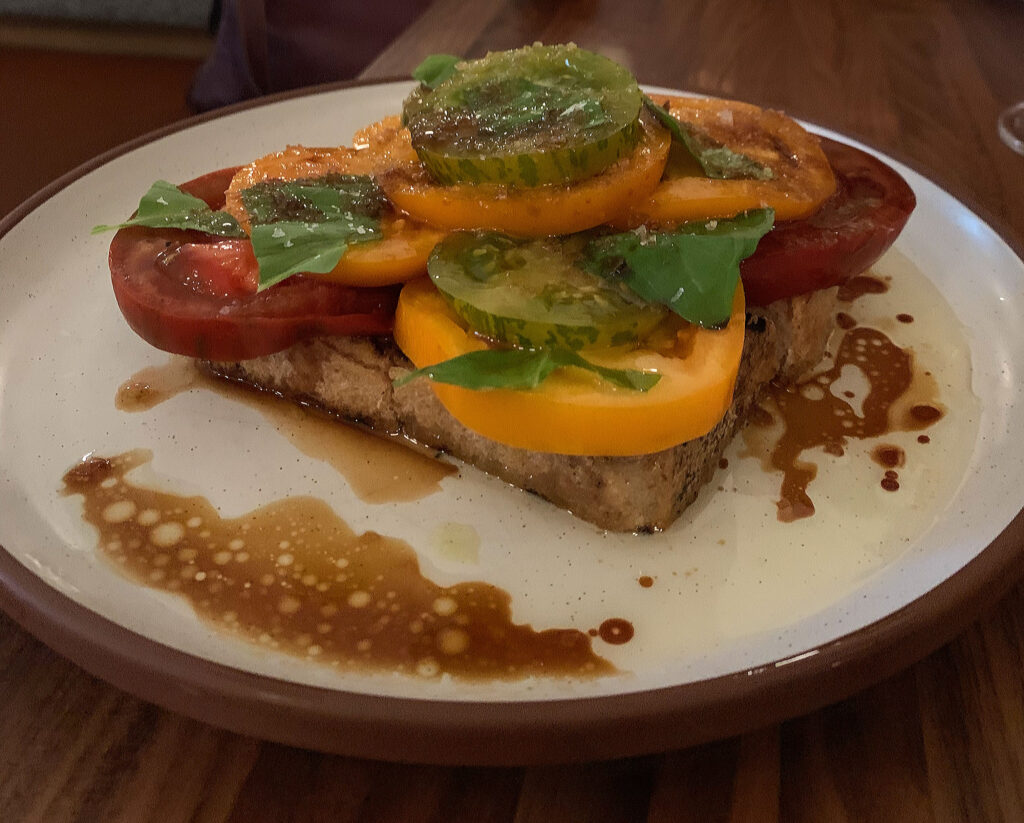
Diving in, you find that the base layer of toast is slightly moistened but generally retains a degree of crispness and structure. This allows you to portion out a few layers of the “pyramid” without the whole thing falling down. On the palate, the tomatoes—even the very thickest of the bunch—are firm (enough to easily cut) but juicy and meaty. They collapse into the mildly crisp sourdough rather nicely and make for a sensation that is something like the perfect piece of bruschetta. Alone, you think the tomatoes display a moderate degree of acid and sweetness. However, they really come alive with the warming richness of the bone marrow, the generous sprinkling of salt, and the jagged tang of the balsamic (not to mention that touch of basil too). Of course, what tomatoes wouldn’t seem like stars with this kind of supporting cast?
“The Overpriced Tomato” certainly demonstrates the textural quality of what Frillman Farms is growing. Nonetheless, these heirloom varieties are not comparable to dedicated culinary crops (like the kind served at Blue Hill) whose superlative concentration of flavor can better stand on its own. No doubt, this is one of the most enjoyable dishes Daisies has served you, yet its reliance on bone marrow and a heavy dressing of salt and vinegar does not exactly inspire confidence in fresh produce’s power to please guests without excessive ornamentation. Maybe you are reading into a low-intervention, ingredient-forward philosophy that the kitchen is not, in truth, consciously pursuing. But why utilize and charge such a high price for a product that demands so much “help”? Putting this point aside, you still appreciate the dish in hedonistic terms.
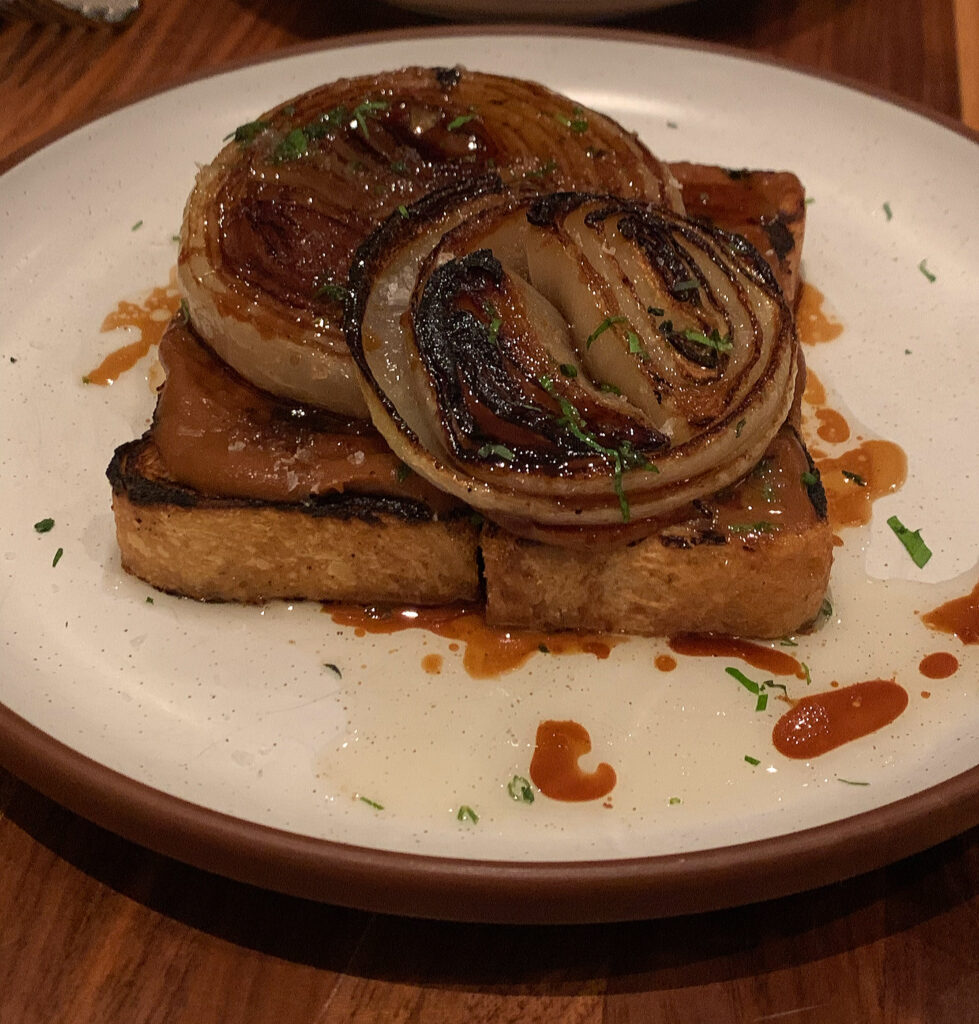
A more recent addition to the menu—serving to replace “The Overpriced Tomato” once it went out of season—has been a variant of the same idea titled “Sweet Onions” ($17). Unsurprisingly, the dish takes the same form: a piece of toasted sourdough topped with slices of the titular allium. Bone marrow and flaky salty, once again, also make an appearance. However, in this case, the onions are beautifully softened—just a bit charred and caramelized on the edges of the rings—and joined by a layer of onion jam and a black garlic drizzle. Thus, while the tomato (despite its healthy dressing) was still somewhat about freshness, its successor aims even more concertedly at depth of savory flavor. And, you must admit, the preparation is a rousing success.
It probably helps that the “Sweet Onions” are not hyped as “overpriced” or as being sourced from a particular farm. There’s no smugness and no promise that you are going to experience a raw product at its best. Rather, the rings of allium are tender, faintly crisp, and moistened (despite being cooked down) by the bone marrow and black garlic. They take on an extra degree of richness from the thick and creamy onion jam before melting against the rigid toast. In terms of flavor, the preparation is plenty sweet (as its name suggests). However, the natural sugars of the caramelized onions are balanced by an immense concentration of umami uplifted by just a bit of tang. Yes, the double dose of bone marrow and black garlic is simply extraordinary by your measure. However, the onion jam ensures the star ingredient remains at the forefront even if those rings of allium get irregularly distributed across the bread.
While it is worth noting that this preparation may seem a bit too salty or intense for some palates, the “Sweet Onions” rank as one of the two or three top dishes across all of your visits. Given your reaction to “The Overpriced Tomato” (at least on a philosophical level) that may seem a bit ironic. Nonetheless, you think onions necessarily demand a bit more processing and artifice to truly be superlative. Unlike tomatoes, which do—at their best—impress in a totally unadulterated form, Frillman can more easily justify loading this allium toast up with umami flavors. In doing so, he has created something that still feels like it honors the star ingredient while, additionally, offering an absolute hedonistic delight. Bravo!
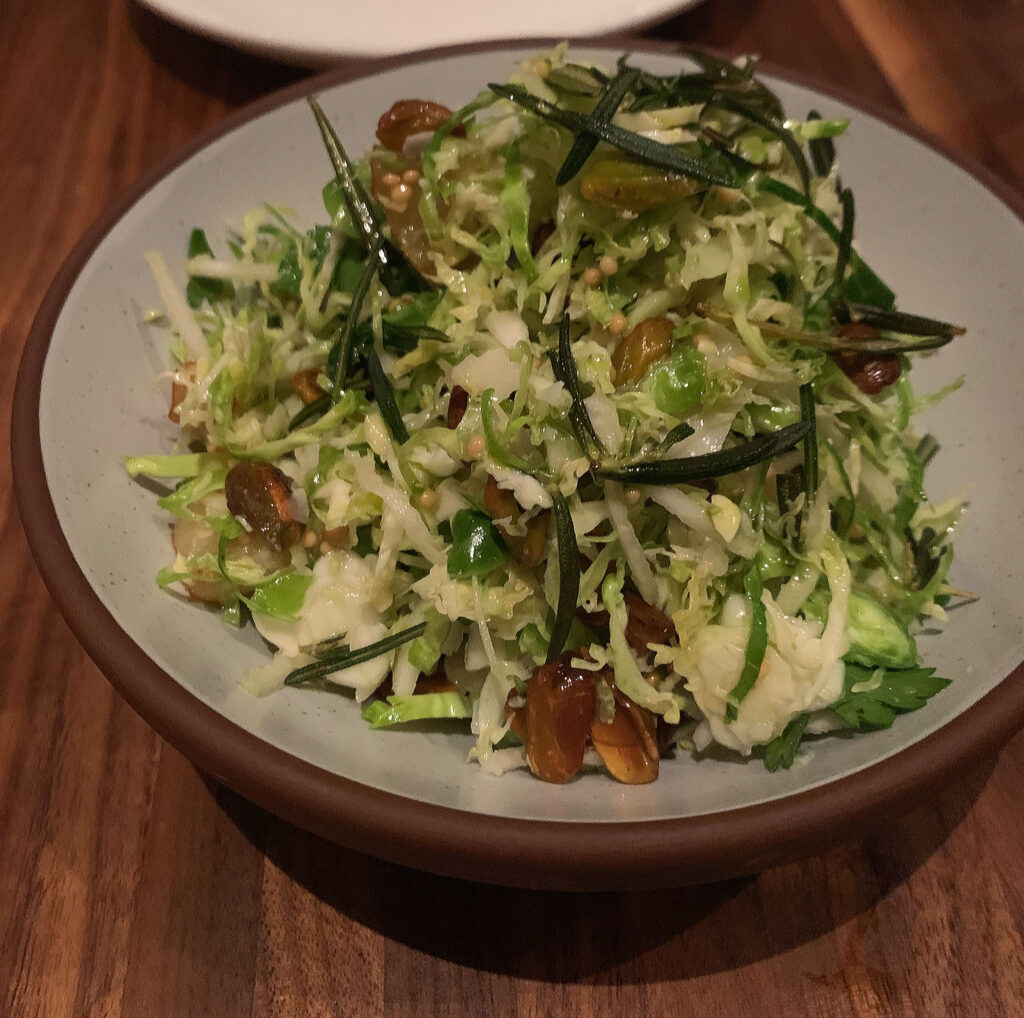
Turning toward lighter fare, you come to the first salad you have sampled at Daisies. Originally offered in 2022, the “Shaved Brussels Sprouts” ($16) actually arrived at the table during your pasta course in one instance. However, given that the “Starters” are usually not interspersed among the later dishes in this fashion, you assumed its appearance then was a mistake (though having a crisp, refreshing reprieve alongside a heavy sauce is sometimes appreciated). Thus, it makes sense to include the item as part of its proper category.
Other than the titular brassica—rendered in thin strips, leaves, and a few larger cross sections—the preparation comprises chunks of pear, bits of pistachio, and fried rosemary leaves. On the palate, the salad offers a softly crunchy sensation (drawn from the robust but properly shaven brussels) that is highly pleasing and punctuated by the harder pieces of nut and crispy strands of herb. Yes, that rosemary element is quite intriguing: you like how it feels against your teeth, but the leaves definitely dominate when it comes to the dish’s flavor. You do not sense any of pear’s sweetness or even much of the pistachio. Instead, the rosemary seems to blanket the other ingredients with a woodsy, savory note that overshadows any of the resonant tang (or simple depth) you would expect from such a salad. Hm, you are not sure what is going on here, but the dish’s textures are let down by a total lack of nuance.
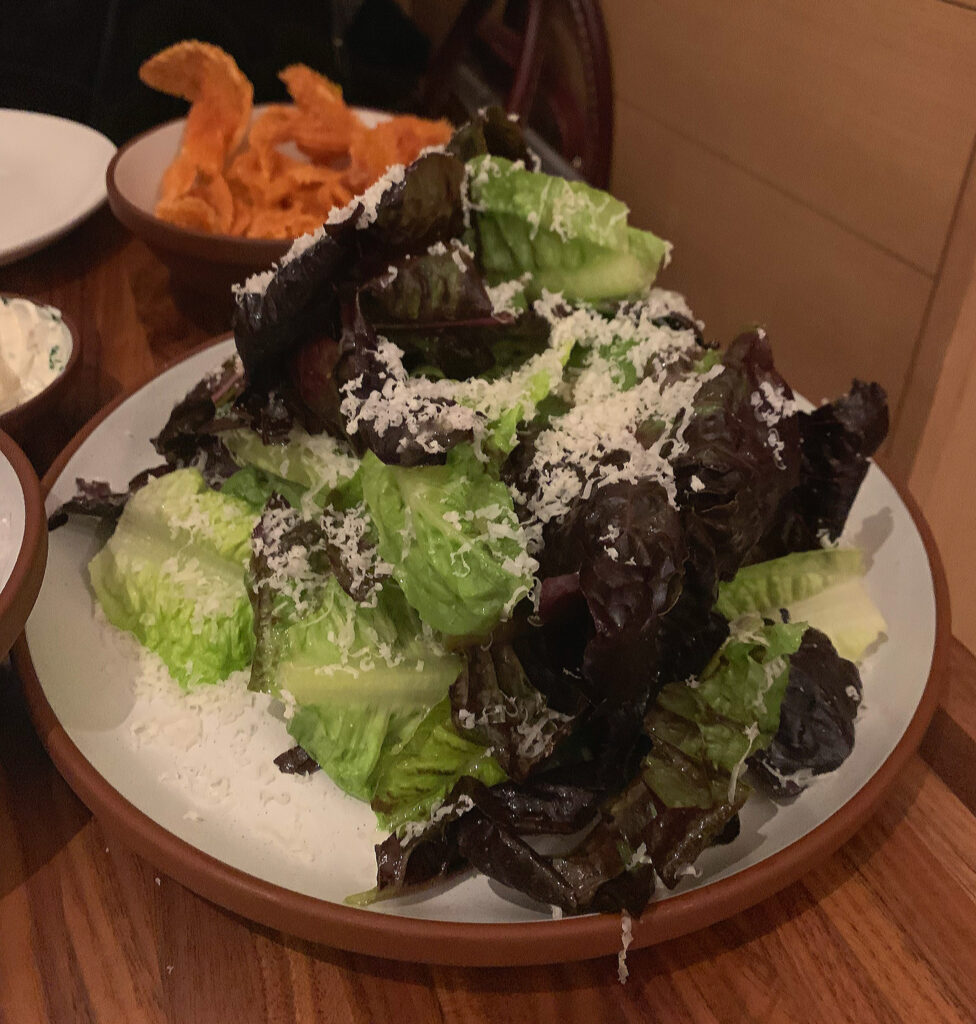
The ”Simple Green Salad” ($15), by comparison, does not try to do anything too fancy. It is made up of rather sizable leaves of lettuce that are lightly coated in a “wishbone” vinaigrette (playfully styled after the Wish-Bone brand of products) and topped with shavings of pecorino.
Approached with your fork and knife, the salad pleases you with its size and the crisp, refreshing quality of the leaves. While the dressing is straightforwardly sweet and tangy, the pecorino provides a sharp, salty note that makes the dish a bit more exciting. Overall, you cannot really complain about this preparation even if the recipe is rather boring. It adequately provides exactly what its name promises and can be easily ignored diners looking to experience food with a modicum of creativity.
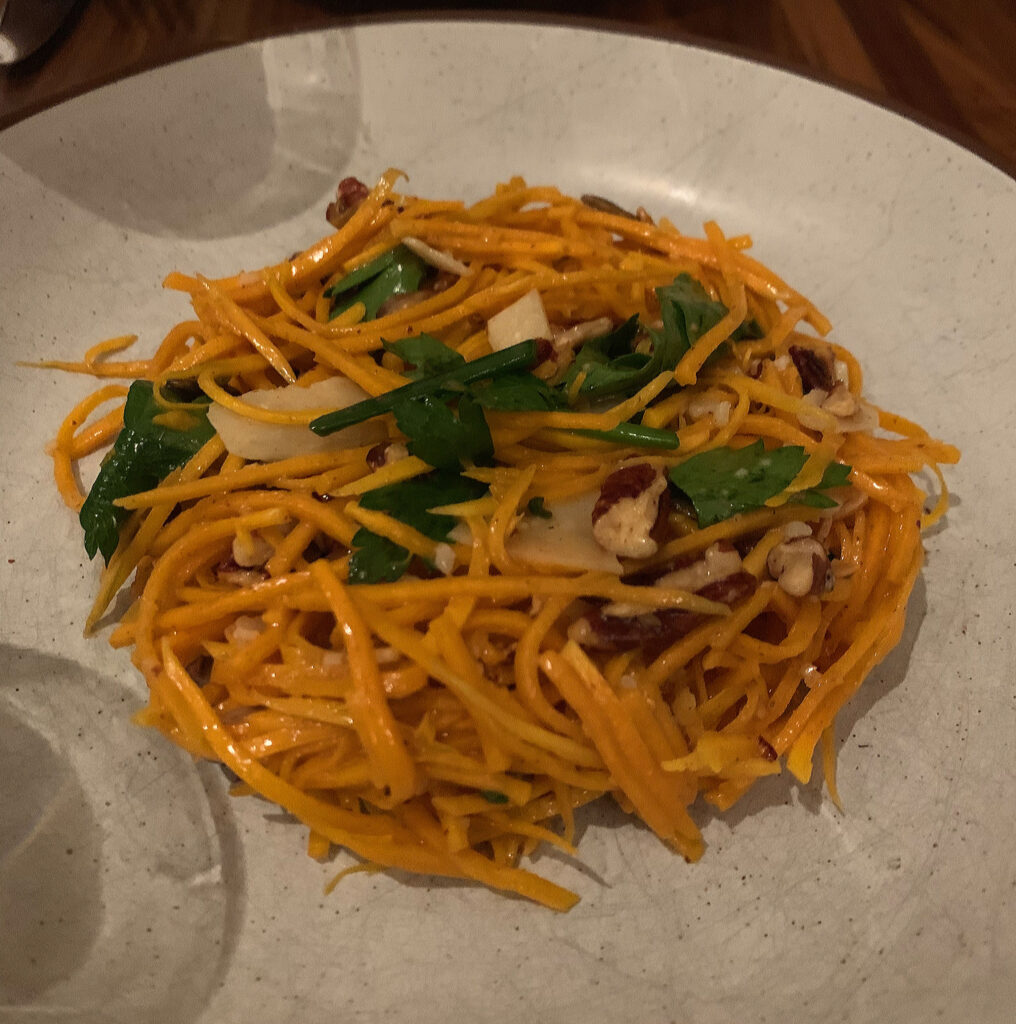
Such patrons will, undoubtedly, want to order the “Squash Salad” ($15) instead. This item might not offer the same heaping size as its “simple” counterpart, but—in terms of both texture and flavor—it is a total delight.
The dish comprises shreds of squash that are dressed in brown butter and formed into a mound. Interspersed within, you find shavings of parmesan and small pieces of pecan. On the palate, the fibrous fruit displays a soft, moistened crunch that is nicely contrasted by the heartier snap of the nuts. The squash’s own mildly nutty flavor, likewise, is absolutely supercharged by the combination of brown butter, cheese, and pecan. You simply love the intensity here. It’s truly a salad for hedonists. Well done.
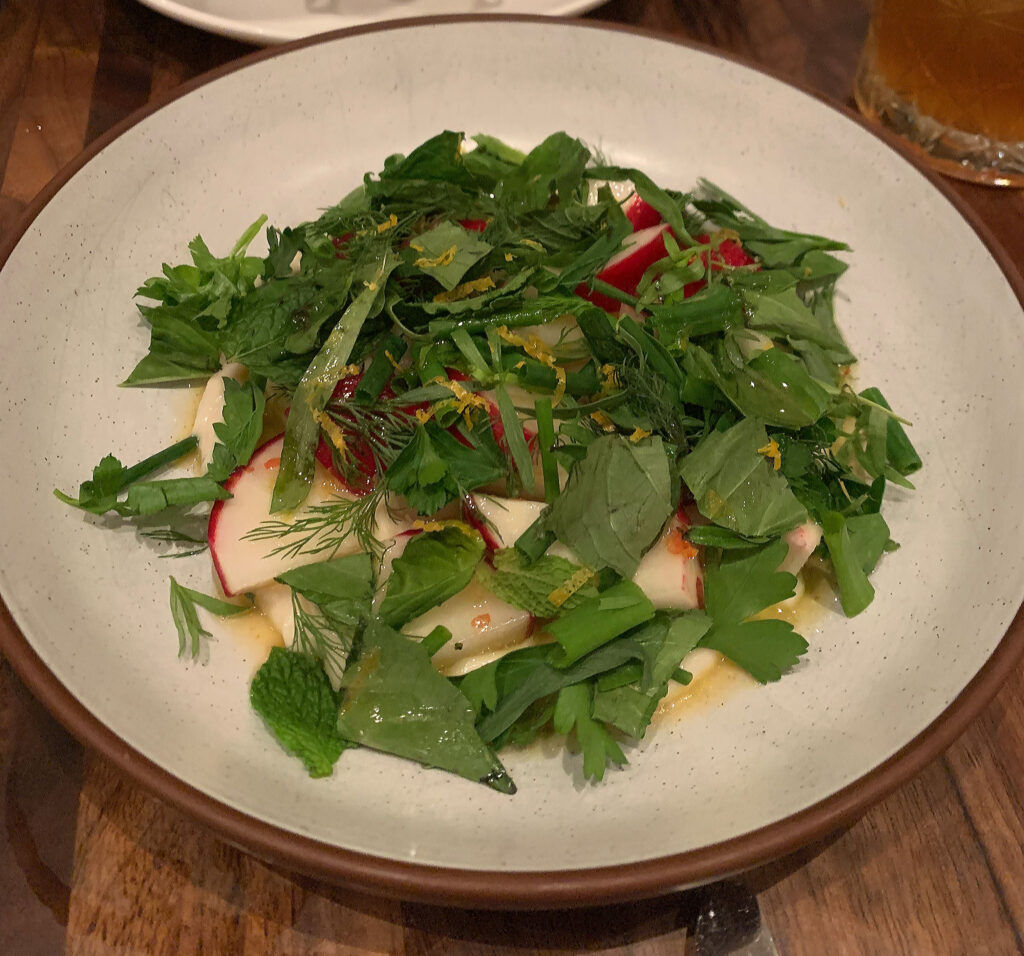
Also fitting (somewhat) into the salad category has been a verbal special of “Radish” ($15). This is hardly the sort of ingredient you get excited about (though, pickled, it can be quite nice), but hearing this humble brassica touted tableside piqued your interest. The red radishes are sourced from Frillman Farms (presenting yet another good test of brother Tim’s agricultural prowess) and paired not with butter and salt but with thin slices of housemade lardo and a thicket of soft herbs. The dressing takes the form of a calamansi vinaigrette while a drizzle of anchovy oil acts as a finishing touch.
Visually, you must admit that this is one of the restaurant’s most strikingly verdant presentations, with those slices of the titular root vegetable peeking out like so many jewels. On the palate, the radishes are crisp and crunchy like what you might expect from crudités. The soft herbs do not affect the texture much, but the beautifully translucent lardo works to surround the brassica with a rich, creamy coating. In terms of flavor, the dish is defined by the uplifting notes of basil, chive, dill, mint, and parsley. These varied herbs harmonize surprisingly well and, combined with the radish’s own sharpness, imbue the preparation with a mildly savory finish. That being said, you wish you could better perceive the tart, citric character of the calamansi or the concentrated umami of the anchovy. No doubt, these elements work in the background to build balance; however, you would prefer to see them in the foreground as the dish, ultimately, is a bit boring. In truth, only those who absolutely love radishes will find any pleasure in it.
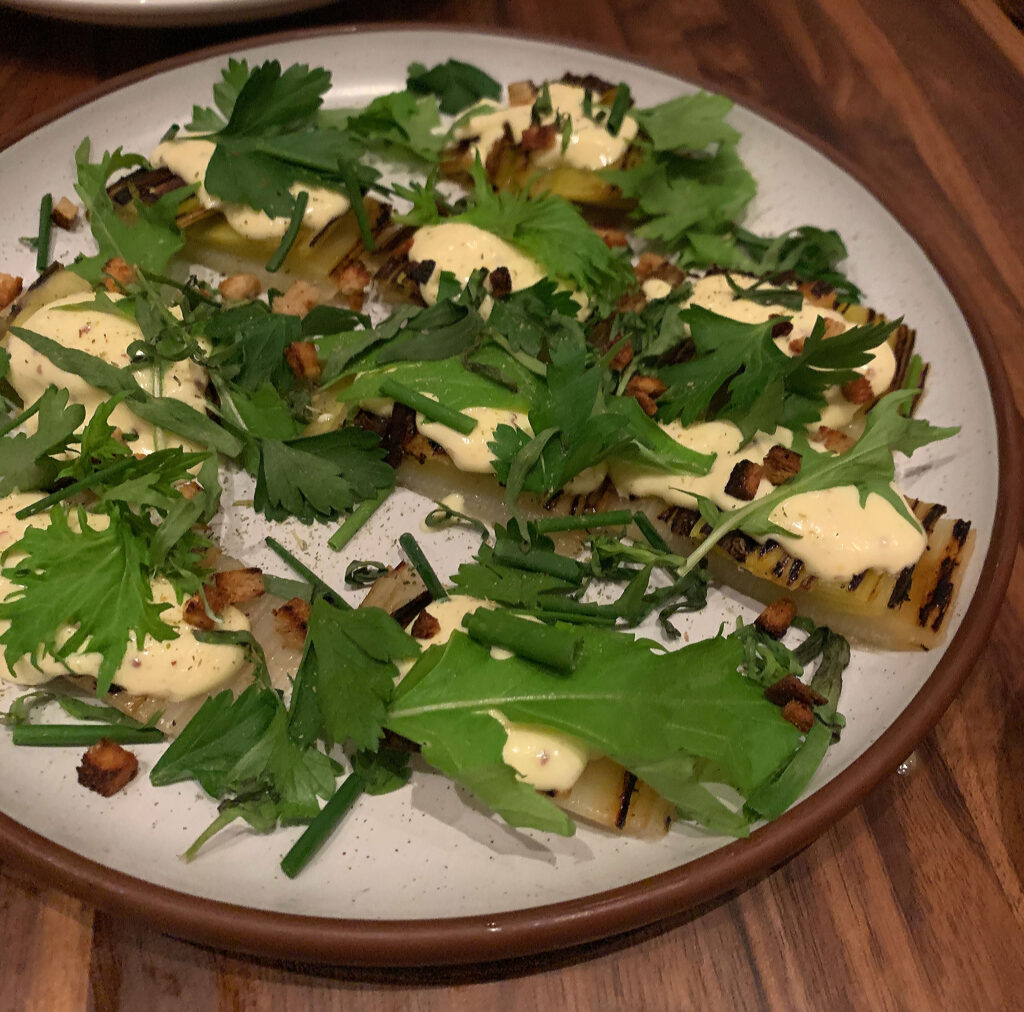
You can tell almost the exact same story when talking about the “Leeks” ($16), an item that has featured on Daisies’s menu as far back as 2017. The allium is braised, lightly charred, and sliced into thin layers that are stacked in piles throughout the plate. Rather classically, the leeks are coated in a mustard hollandaise and then studded with some rye croutons. A blanketing of soft herbs, once more, completes the presentation.
On the palate, the leeks are nicely softened while retaining a faint crispness that is echoed by the more powerful crunch of the tiny croutons. Their accompanying sauce is rich and creamy, though it takes a bit of effort to distribute it throughout all of the allium’s layers. The dish’s flavor, meanwhile, is defined by the tangy mustard hollandaise, the subtle bitterness of the leeks’ char, and the bright, peppery notes of the various soft herbs. Though the rye crouton helps the preparation feel a bit more savory, it could really use more salt. That would serve to unlock the sweet, oniony character of the leeks, for, as it stands, the star ingredient just doesn’t deliver much pleasure. Yes, the “Leeks” are more or less a repeat of the “Radish” with a couple elements swapped out. Neither dish (though both confident in the light touch they entail) inspires you to want to eat your vegetables.
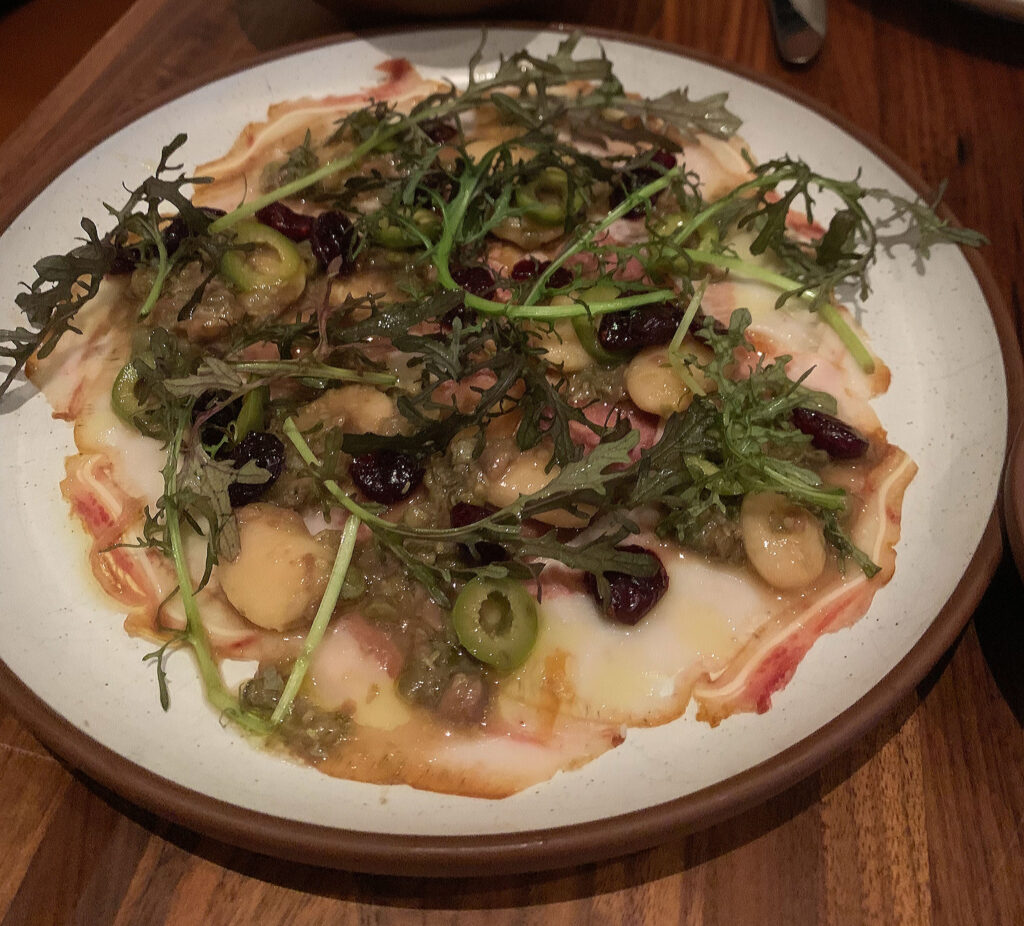
Turning, at last, toward the meatier side of the “Starters” section, you begin with the “Porchetta di Testa” ($15). This cooked roulade of pig’s head (made in-house) is very thinly sliced and draped over the surface of a plate. The pork is then garnished with marinated beans, Castelvetrano olives, and dried cranberries while some sprigs of arugula and a dressing of aged sherry vinegar form the finishing touches.
On the surface, this seems to be yet another layered composition in the vein of the “Radish” and “Leeks.” However, relative to his vegetable-focused creations, Frillman displays an uncommon virtuosity here. The all-important porchetta is, itself, beautifully tender and well matched to the soft, slick beans. Though the bits of olive, cranberry, and arugula provide an engaging textural contrast, the dish really shines in terms of flavor. Anchored by the tangy sherry vinegar, all the varied sweet, buttery, and nutty notes of the garnishes take hold. Combined with the pork’s own richly meaty, subtly herbed and spiced character, they drive the dish’s savory power into the stratosphere and leave you licking your lips in amazement like few of this restaurant’s dishes can. In sum, this preparation is beautifully done and should serve as a blueprint for how to rebalance the menu’s other, blander starters.
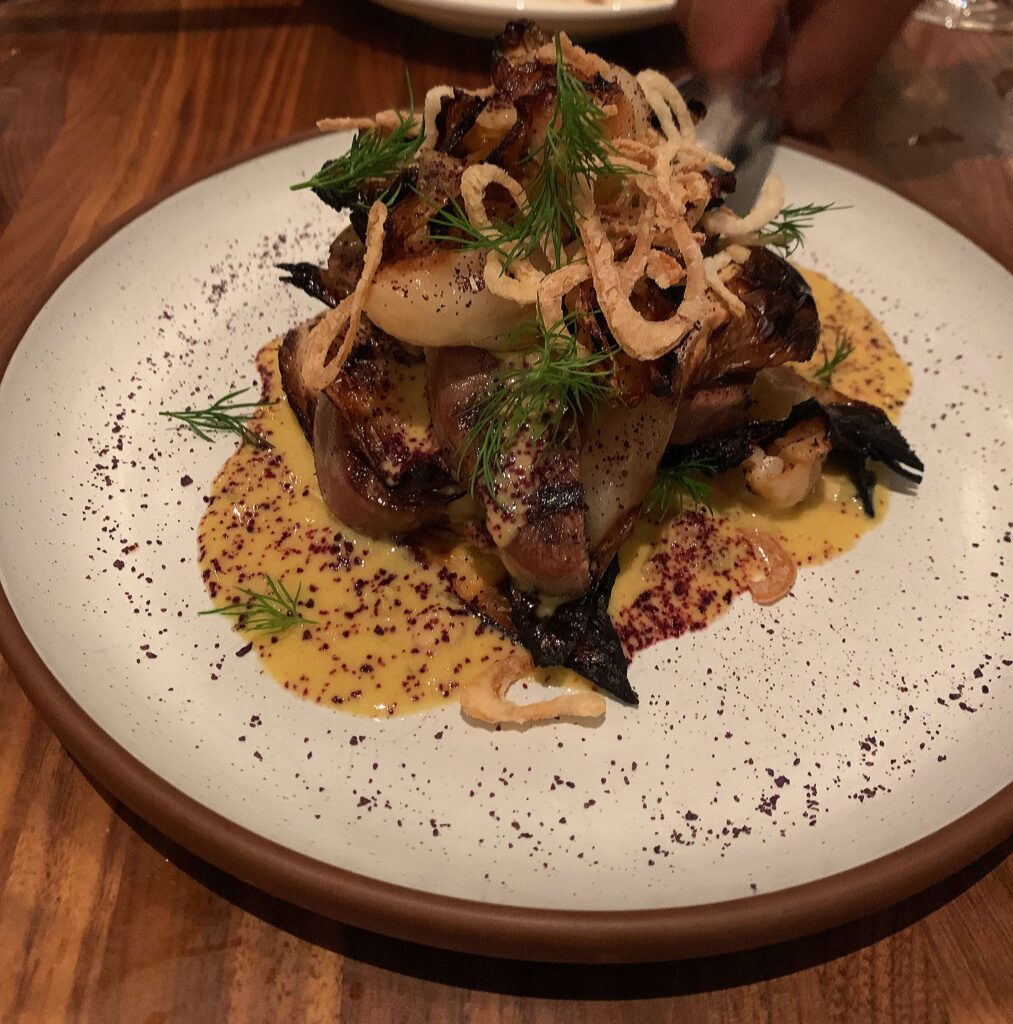
Next, continuing with the more substantial fare, you have a “Beef Tongue” ($18) praised by one critic as “smoky and delicate like the love child of a flavorful ribeye and tender filet mignon.” In truth, the preparation has been around since 2019, when it went by the name of “Green Cabbage.” True to that other title, the dish comprises large chunks of the tongue mingled with leaves of the brassica. The combination is coated in a “clam vinaigrette” and comes topped with sprigs of dill and some crispy onions.
Approaching the dish, you do agree that the beef tongue, after offering a bit of chew, proves nicely tender. This, in turn, forms a fitting complement for the hearty crunch of cabbage and the more finely crisp fried allium. Taken together, these elements feel undeniably hearty. However, the preparation’s flavor rests on the briny, tangy vinaigrette in concert with the sweet, anisey dill and just a touch of bitterness from the beef’s char. The resulting combination is roughly savory and rather intriguing without making total sense (or achieving complete satisfaction). Yes, the recipe’s real virtue is that the tongue is so nicely cooked and well matched to the cabbage even if the accompanying flavors do not follow suit. Overall, this makes for an intelligent dish that ranks among the menu’s better items without rising to the level of being totally convincing (or worthy of a repeat).
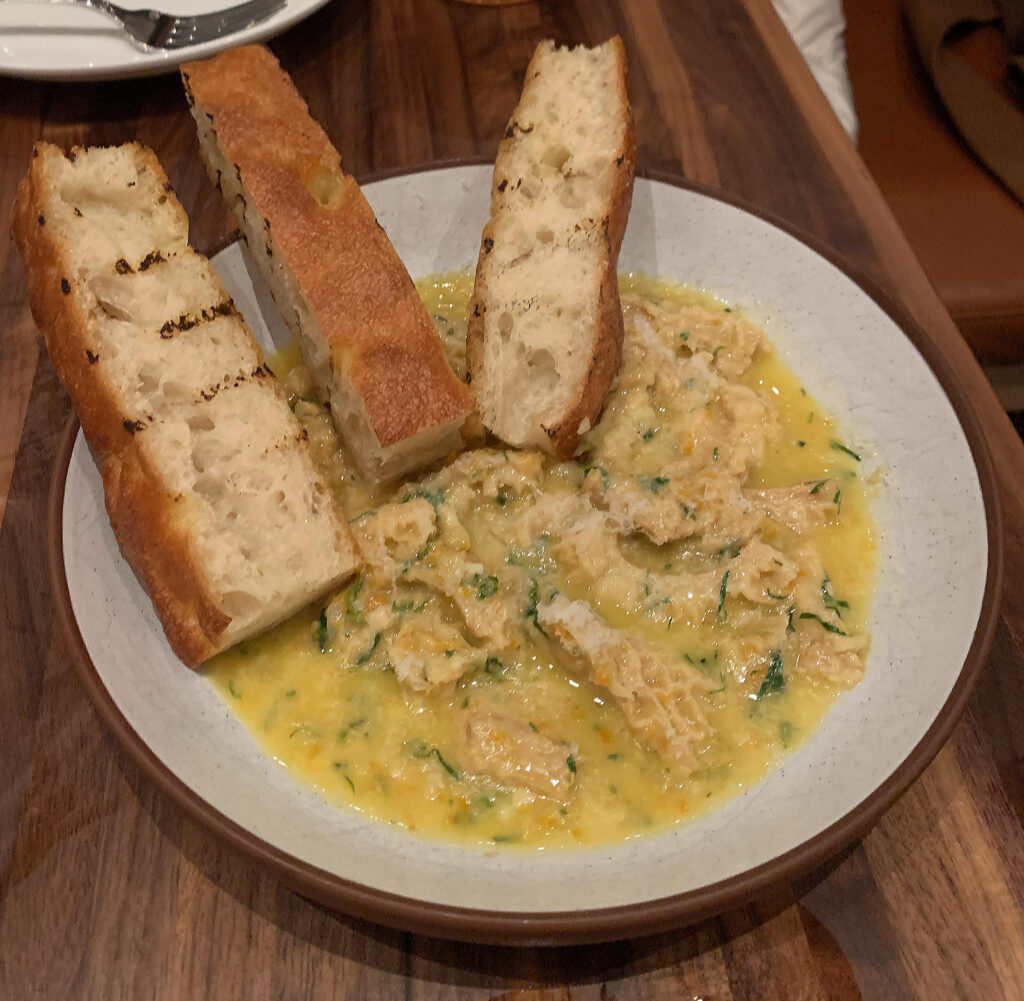
With the last of the “Starters,” you also come to the best. As funny as it sounds, Frillman’s “Tripe” ($12) actually surpasses anything else the chef makes. (Oh, how great Daisies might grow to be if it ditched the vegetable gimmick and dedicated itself wholly to offal.) His preparation of the stomach lining is rather simple: the meat is braised then served with the braising liquid, some soft herbs, a bit of grated parmesan, and a few slices of toasted focaccia.
Visually, the dish feels rather approachable because the pieces of tripe are so small and do not display too much of the signature (somewhat off-putting) “honeycomb” structure. More importantly, the offal is extraordinarily tender, melting, and imbued with a striking depth of clean, livery flavor that scratches the very deepest carnivorous itch. From this foundation—which, you must admit, represents perfection as far as this ingredient is concerned—the sprinkling of herbs and parm only offer a little added thrill. The focaccia, likewise, is good but not great (yet, nevertheless, hard to resist when coated in the accompanying juices). However, the tripe—oh, that tripe—is really special. This dish speaks to a degree of boldness and bravery that is largely missing from the rest of the menu. It is, along with the “Potted Carrots,” “Sweet Onions,” “Squash Salad,” and “Porchetta di Testa,” one of only a handful of items you would really feel compelled to order again. Bravo!
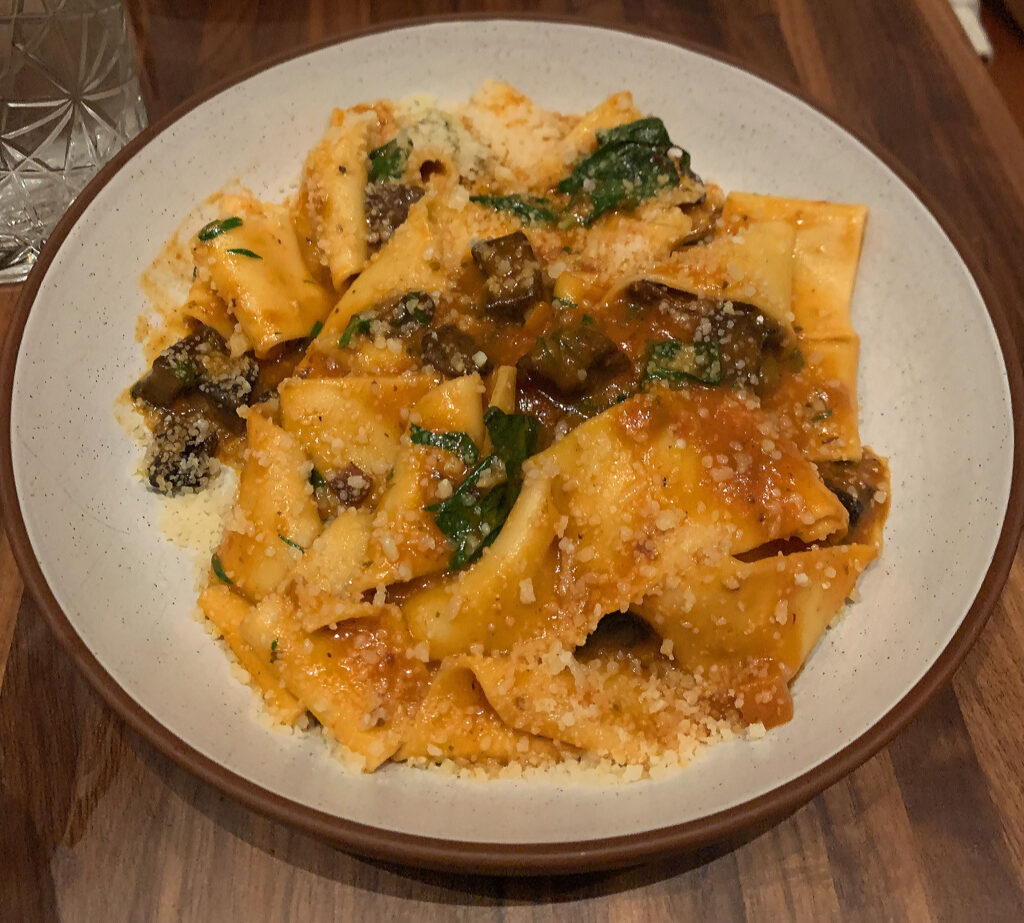
Next, you come to what is arguably the main event: the dozen or so varieties of “Pasta” on which Frillman has made his name. You start with a fairly simple example. Daisies’s “Pappardelle” ($21) comprise long, wide ribbons (suitable for “gobbling up” as the name literally suggests) paired with a mushroom ragu, “house cheese,” and basil.
Diving in, you must admit you find the noodles—despite your digital dexterity—a bit hard to twirl or handle without a knife. This is a testament to their impressive width, which seems about 50% greater than what you might expect for the form. Nonetheless, this oversized rendition presents an appealing canvas for the pasta’s sauce and generous crumble of cheese. On the palate, the pappardelle offer a nice al dente chew. However, you find the mushroom ragu to be watery. Yes, the dish does not offer any satisfying degree of umami or even much influence from the basil or cheese (just what is “house cheese” anyway?). Instead, it merely represents a decent vegetarian option with some fleeting earthy notes.
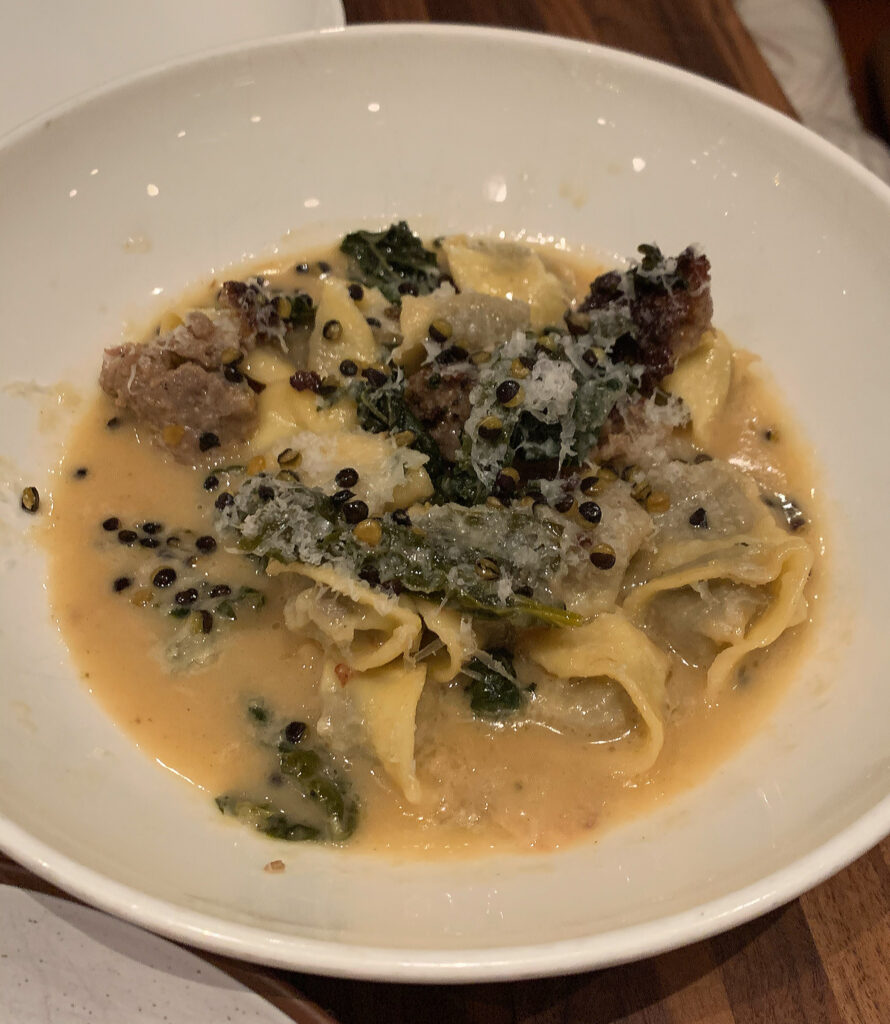
Moving on, you find that Frillman’s “Cappelletti” ($19) tell a similar story. These “little hats” are stuffed with cheese and paired with black lentils, braised kale, and chunks of fennel sausage. However, admittedly, the presentation looks like a bit of a mess.
On the palate, you actually find the cappelletti to be soft, subtly chewy, and rather appealing at a textural level. Yes, the pasta does tend to stick together a bit (a recurring problem at Daisies), but Frillman is undoubtedly at his best when making shapes that take on more of a stuffed or “dumpling” form. That being said, the “little hats” swim in a murky liquid that can hardly be called a sauce. This tepid pool is rather thin and flavorless almost to the point of detracting from the cappelletti’s mouthfeel. Further, though the combination of lentils, kale, and sausage harmonizes well, the dish lacks salt and, thus, savory power. Ultimately, you are left with another preparation that is missing depth or any kind of appreciable finish.
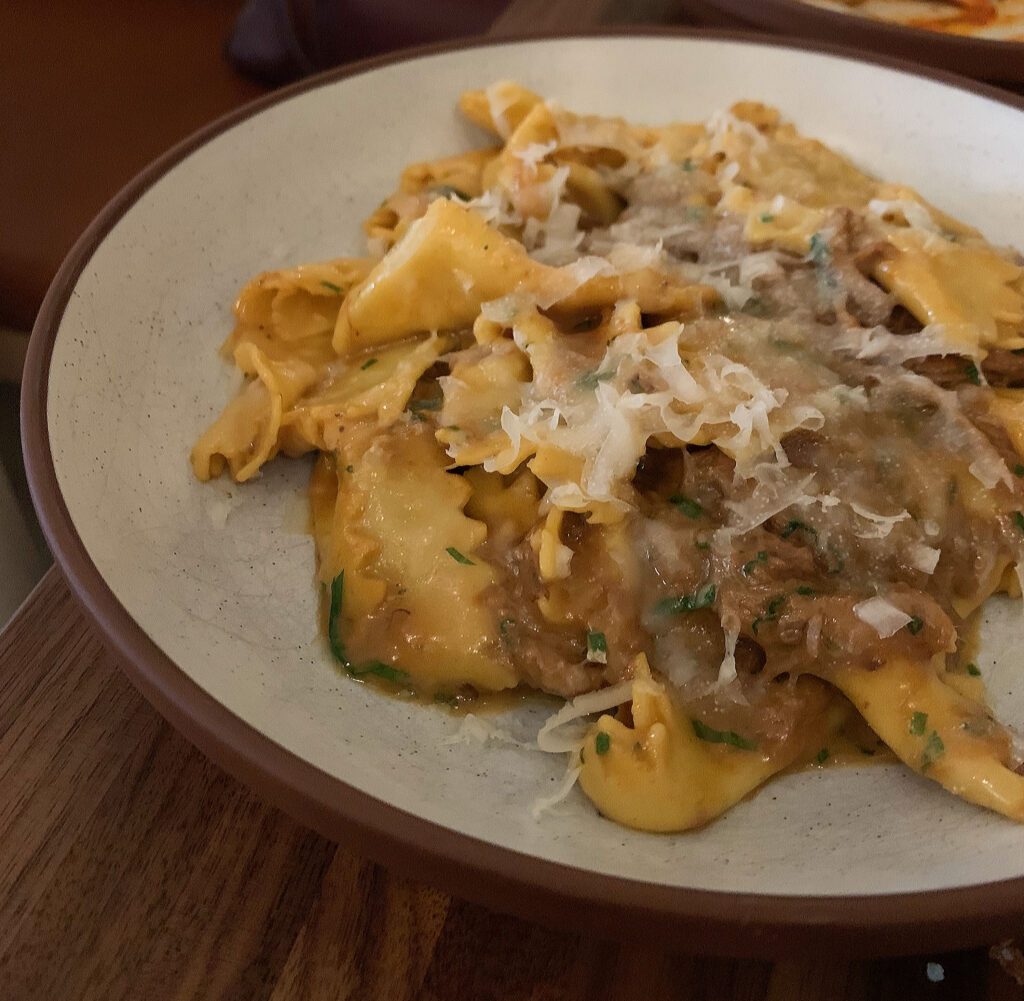
Of all the pastas served at the restaurant, Frillman’s “Stracci” ($24) carry with them the highest expectations. These “rags” have been on the menu since opening, when they were highly praised by critics. The exact preparation has evolved over time (once featuring peas and, later, broccoli) but continues to center on long, irregular ribbed noodles in a lamb sugo with shaved pecorino. At present, some soft herbs form the finishing touch.
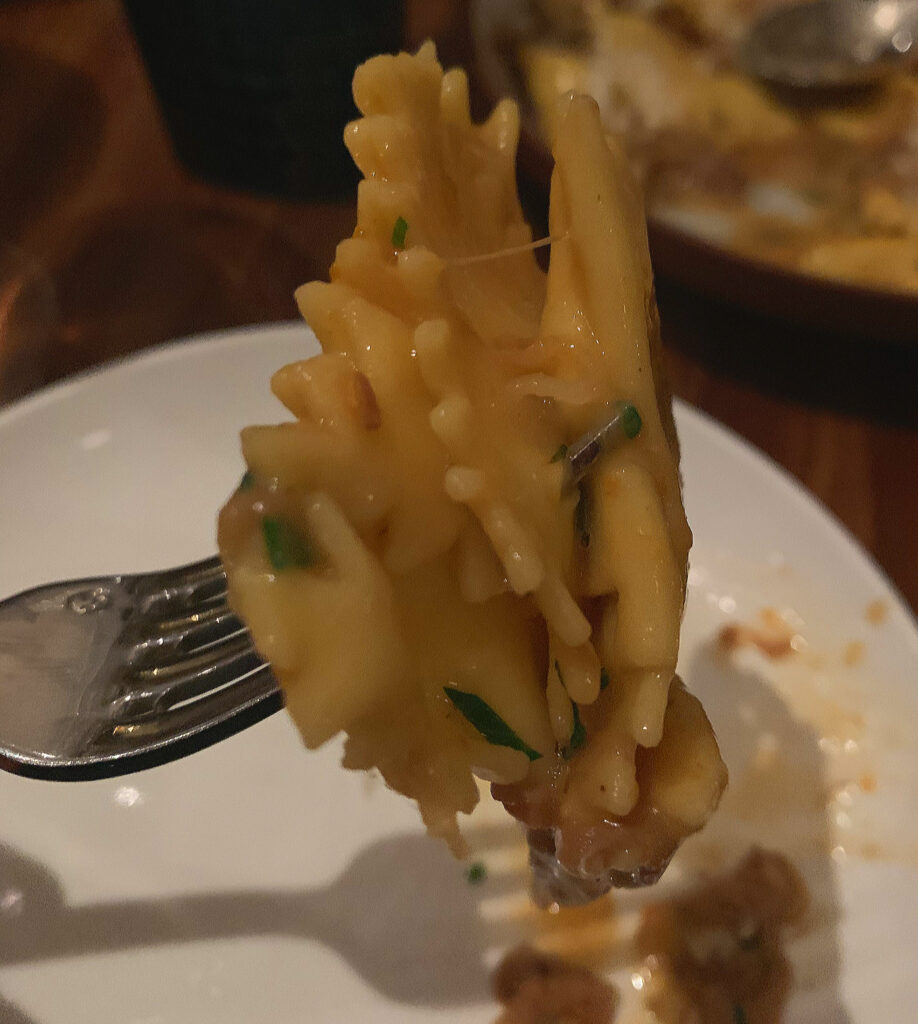
On the first occasion you sampled them, the “Stracci” really impressed you: the noodles were not only perfectly al dente but smacked of the rich, meaty, mildly sweet, and lastingly savory notes you have wanted from Daisies’s other preparations. However, trying the “Stracci” once more during your fourth visit yielded noodles that were clumped together (in layers of four or five at a time) in a watery sauce with only a faintly meaty-gamey flavor. Off nights happen, but this is an awful degree of inconsistency that can only, once more, harshly call that 25% service charge into question. If you cannot reliably cook and sauce pasta—your best, most longstanding recipe for that matter—what business do you have running such a concept?
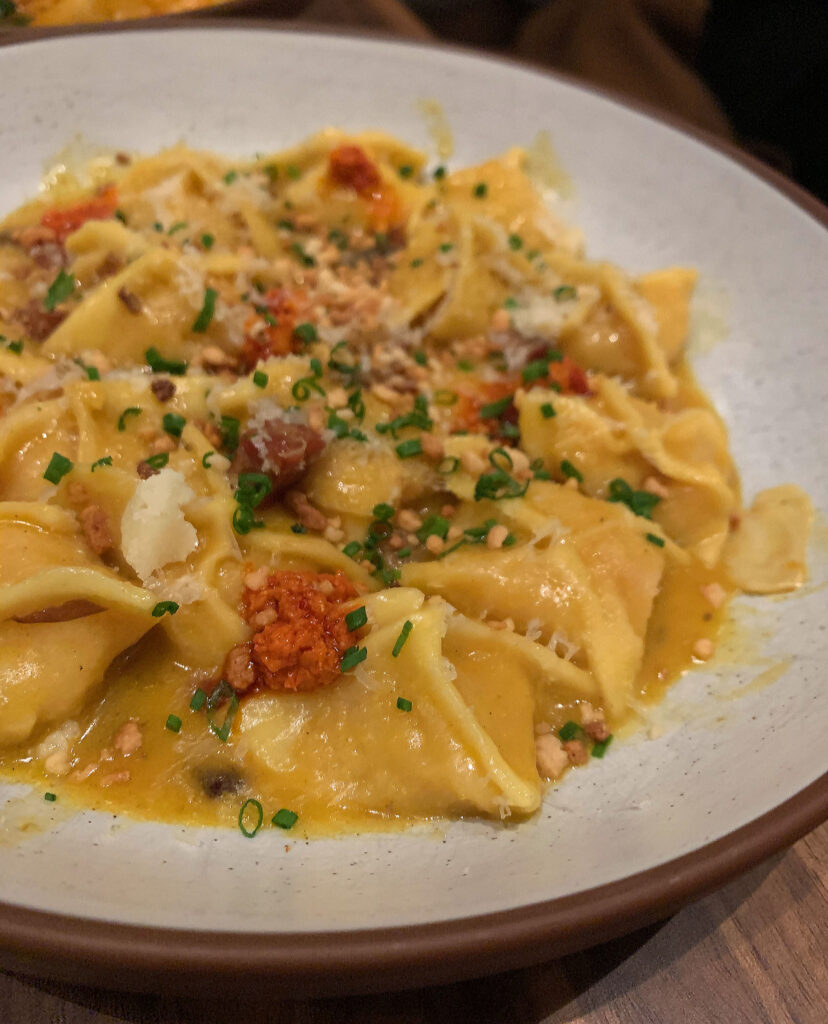
You next come to the “Pumpkin Manti” ($23), a dish originally offered in the post-pandemic, pre-“2.0” era. Rather than taking inspiration for its shape from Italy, the pasta draws on a pinched dumpling form seen across Armenian, Central Asian, and Turkish cuisines. The pyramidal pockets are stuffed with pumpkin and come paired with crispy pancetta, crumbled amaretti cookies, shreds of parmesan, some chives, and neonata (a spicy Calabrian condiment made of “newborn” fish—also called “the caviar of the south”).
Approaching the bowl, you must admit that you love the dish’s bold, varied components and the bursts of orange and red found throughout the presentation. Also, as with the “Cappelletti,” the dumpling-like form of the manti is a big success: being soft, a bit chewy, and enriched by the smooth pumpkin filling. However, the crispy pancetta—almost always a surefire hit—is weirdly dense and hard to masticate. The pasta possesses some sweetness and a bit of burn (drawn from the amaretti and neonata respectively), yet you are left with an unpleasant, harsh sensation in your throat. Even the level of salt, rather than being too low as it was in many of the other dishes, actually seems too high in this case. Overall, this is a confusing showing from the “Pumpkin Manti,” and, despite your high hopes, it ranks near the very bottom of all the items you have sampled.
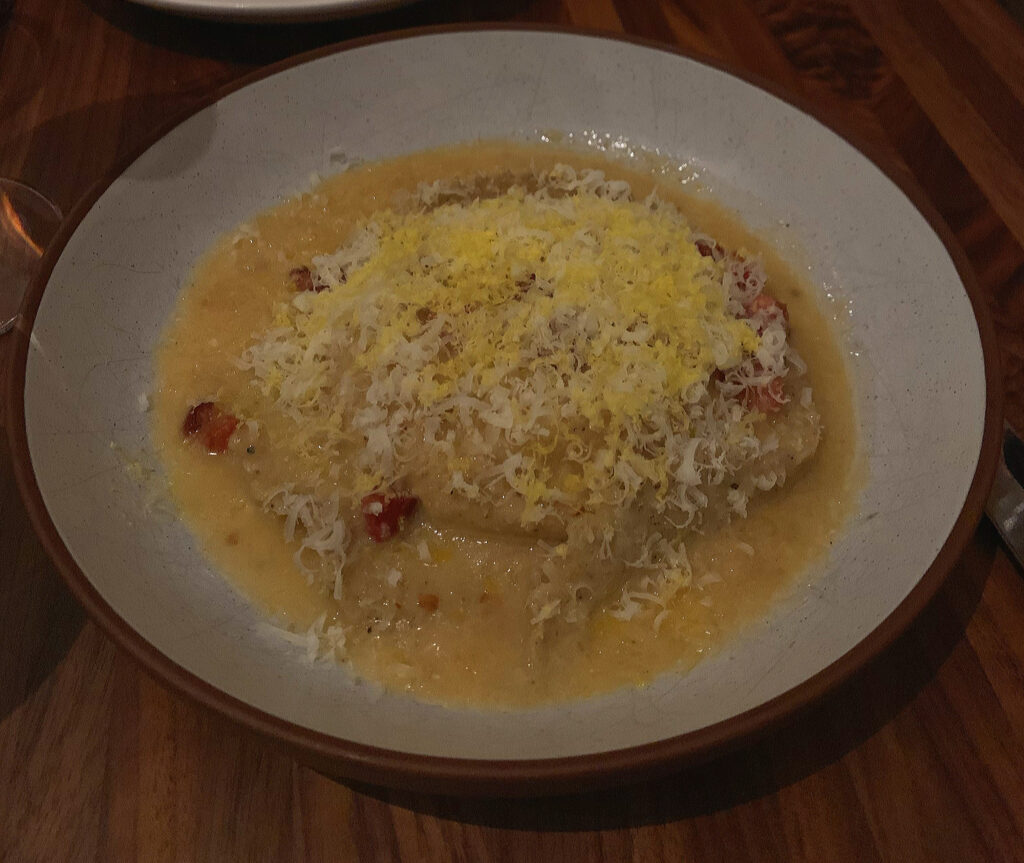
Though Frillman has served various plays on a carbonara in the past, his “Raviolo ‘Carbonara’” ($25) represents a take on the recipe that looks beyond the noodle. This singular pocket of pasta (whose name is sometimes said to derive from its resemblance to a “small turnip”) is filled with egg yolk and ricotta, paired with pieces of crispy bacon, and topped with an avalanche of shredded cheese (both parmesan and pecorino).
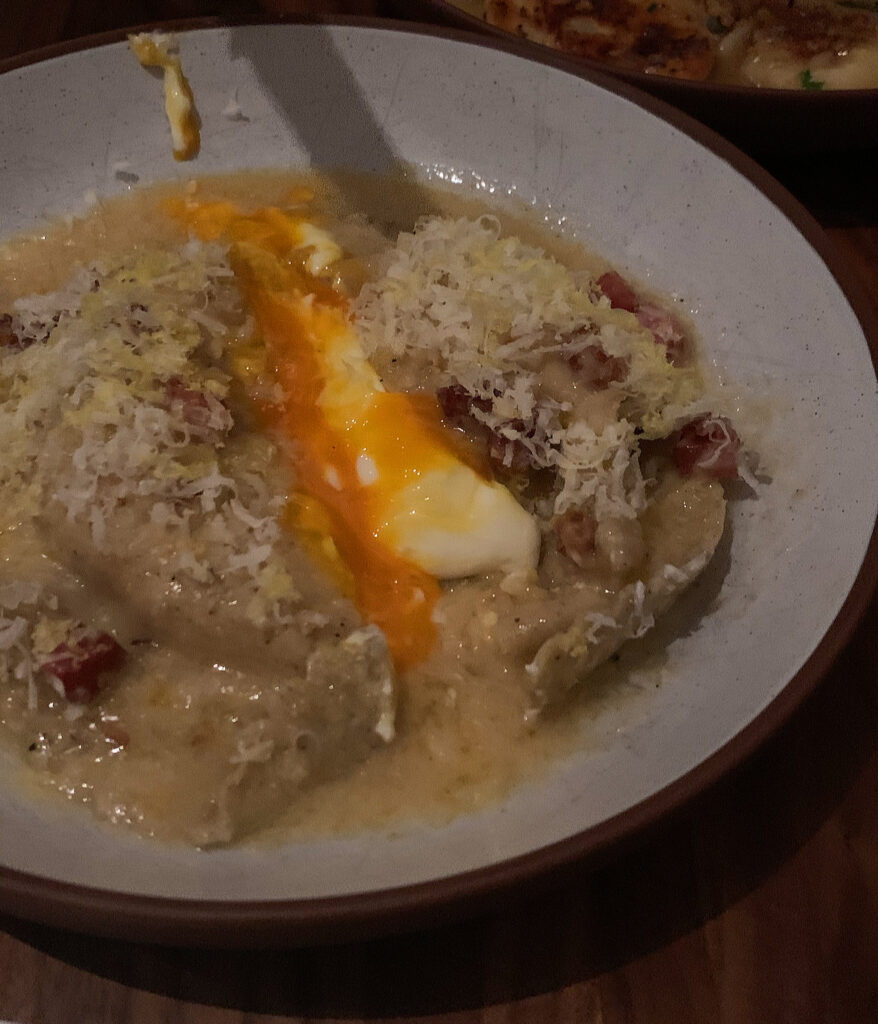
Pierced with your knife, the raviolo’s egg and cheese filling oozes out temptingly. Compared to the dish’s surrounding sauce (which, again, is thin and watery), these components are rich and encompassing. They serve to join the pasta wrapper to its topping of shredded cheese and make for a cohesive bite. On the palate, the sliced segments of raviolo are decent enough—not quite offering the pleasing chew of the earlier dumpling forms nor the intricacy of the layered noodles. However, the pieces of bacon are, like the preceding pancetta, too dense. The filling of egg yolk and ricotta is also unpleasantly lukewarm while, additionally, you encounter a strong lemon note that precludes any depth of savory flavor or larger feeling of satisfaction. In sum, this is another miss.
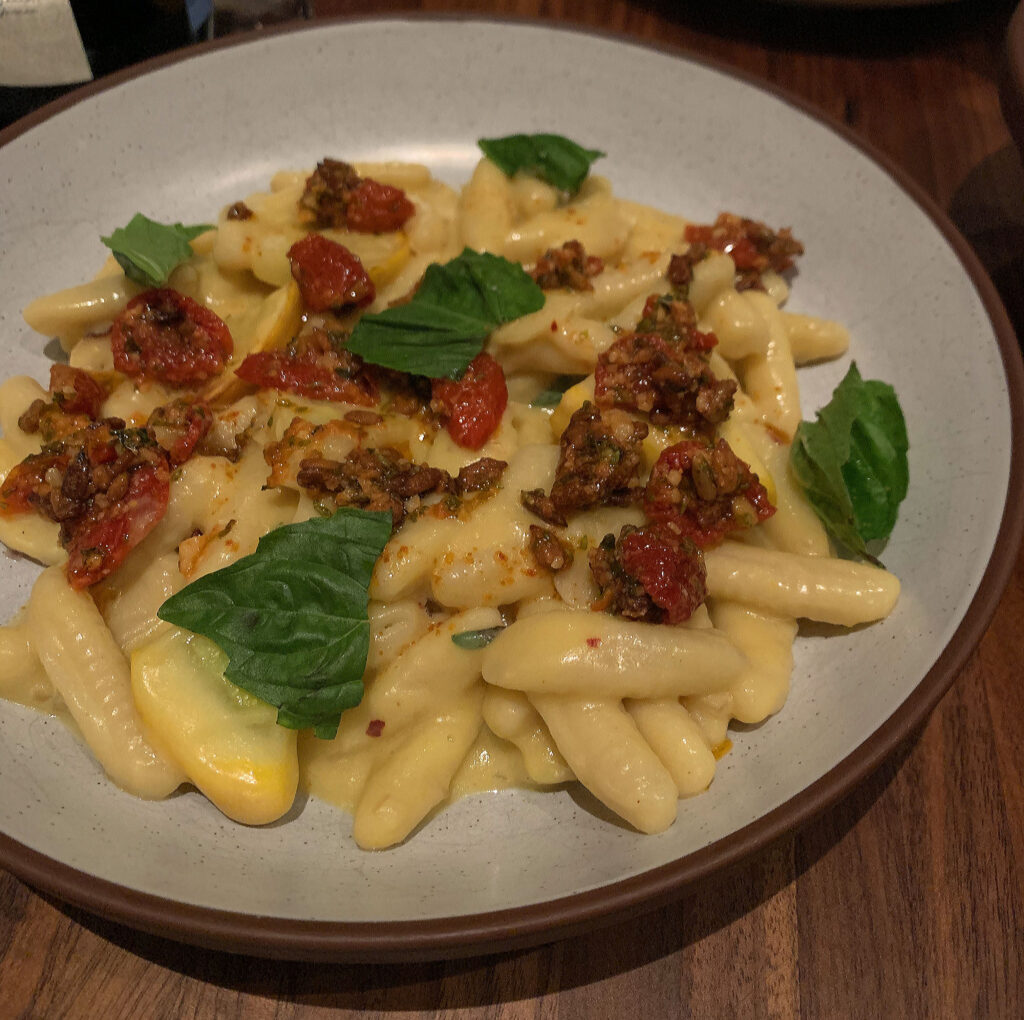
Offered toward the beginning of fall, Frillman’s “Cavatelli” ($22) represents, like the “Pappardelle,” yet another vegetarian preparation. Here, the “little hollows” are dressed in a summer squash sugo and topped with dried tomato, some roasted seeds, and basil leaves.
Visually, you must admit this is one of the cleaner, more appealing presentations. The shape of the pasta is easily discernible, and the sugo coats it temptingly with a richness that reminds you a bit of macaroni and cheese. On the palate, the cavatelli are gently chewy without feeling too dense. They possess a slick, buttery coating from the sauce that contrasts nicely with the fine crunch of the seeds but is not quite ideal with the somewhat stringy dried tomatoes. The dish’s flavors, too, are not as satisfying as expected. The squash sugo tastes faintly savory but lacks depth of sweetness or any real layering of other notes (the seeds and tomatoes are no help here). If you are reminded of macaroni and cheese, it is only of some frozen, “health food” variety that looks the part but feels totally hollow on the midpalate.
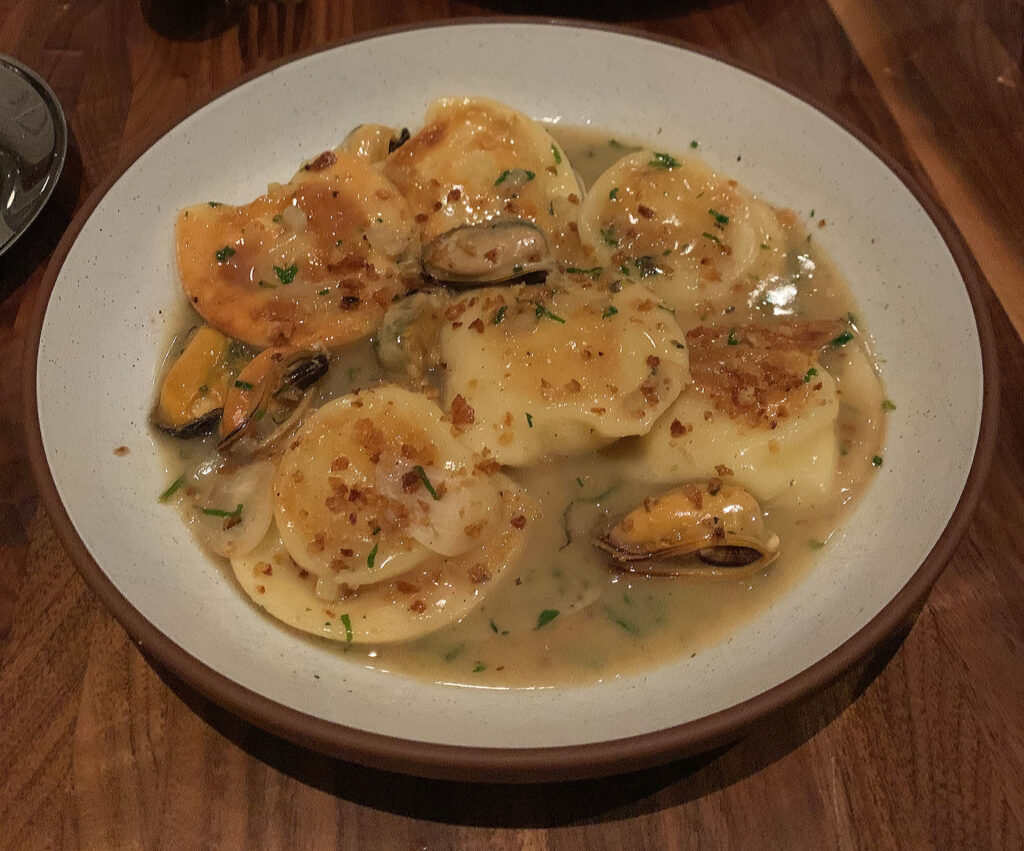
Another staple of the menu, like the “Stracci,” are Frillman’s “Pierogi.” They appeared on Daisies’s menu at opening (in 2017) and received praise for being both “pillowy” and “impossibly delicate” from critics. Though originally paired with clams and a sauce made with lemon saison in their earliest rendition, the pierogi (stuffed, as always, with potato) have been joined by mussels and “the champagne of beers” since 2018 with a scattering of breadcrumbs forming the finishing touch.
On the palate, the dumplings follow in the footsteps of the “Cappelletti” and “Manti” by being plump and pleasing. Their slightly browned wrapper is soft—and the transition from exterior to interior fairly subtle—even if the potato filling does not provide too dramatic of a contrast. In terms of flavor, you again find the sauce to lack much depth or concentration. This proves particularly vexing when you consider the pierogi’s size and how in need of some supporting notes (given the potato filling) they are. Worse still, while the mussels and breadcrumbs might act to provide some of that intrigue, you found—on one occasion—that the mollusks felt gritty against your teeth. Yes, you have encountered multiple pieces of shellfish that are sandy and made doubly sure, eating them alone, you were not confusing the sensation for the crispness of the breadcrumbs. This is, by all accounts, a total failure for a dish that should be one of Frillman’s stalwarts. How disappointing.
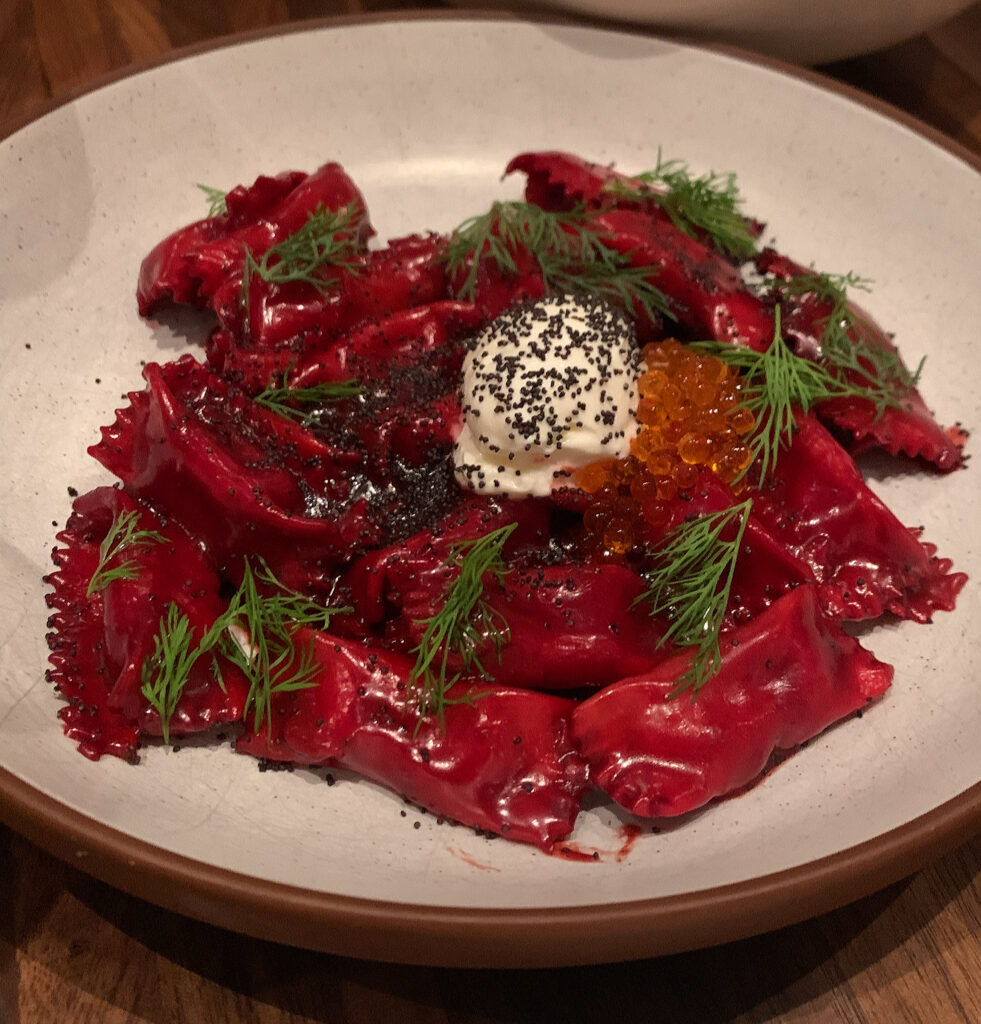
The next item, “Agnolotti” ($20), has not only been on the Daisies menu since opening but actually made the journey from Balena, where Frillman prepared it as a “customized” dish “for a single VIP guest.” The recipe, which has not changed, comprises poached and puréed beets encased in ribbed, beet-stained pockets of dough dressed with beet sauce, crème fraîche, dill, smoked trout roe, and poppy seeds. Though this may not sound appealing to some diners on paper, it actually represents Frillman’s most complete preparation of pasta (and one of only two you would characterize as good).
On the palate, the agnolotti continue to exhibit the chef’s mastery of dumpling-like forms. They are just firm enough to offer some resistance before unleashing their smooth beet center. (However, as you noticed with the “Cappelletti” and the “Stracci,” the pasta does stick together a bit and even turns waxy as it sits in the bowl.) As the agnolotti mingle with the rich crème fraîche and the finer mouthfeel of the poppy seeds and roe, a deep sweetness builds. Rather than being sickly, it sees itself beautifully balanced (and, thus, underscored) by the combination of sour, nutty, smoky, and anisey notes. The dish’s finish is short but also sweet and unique in the fact that it actually (relative to the other pastas) comes through. Overall, this is quite unique but also enjoyable—a modest success that should be used to guide the development of other worthwhile recipes.
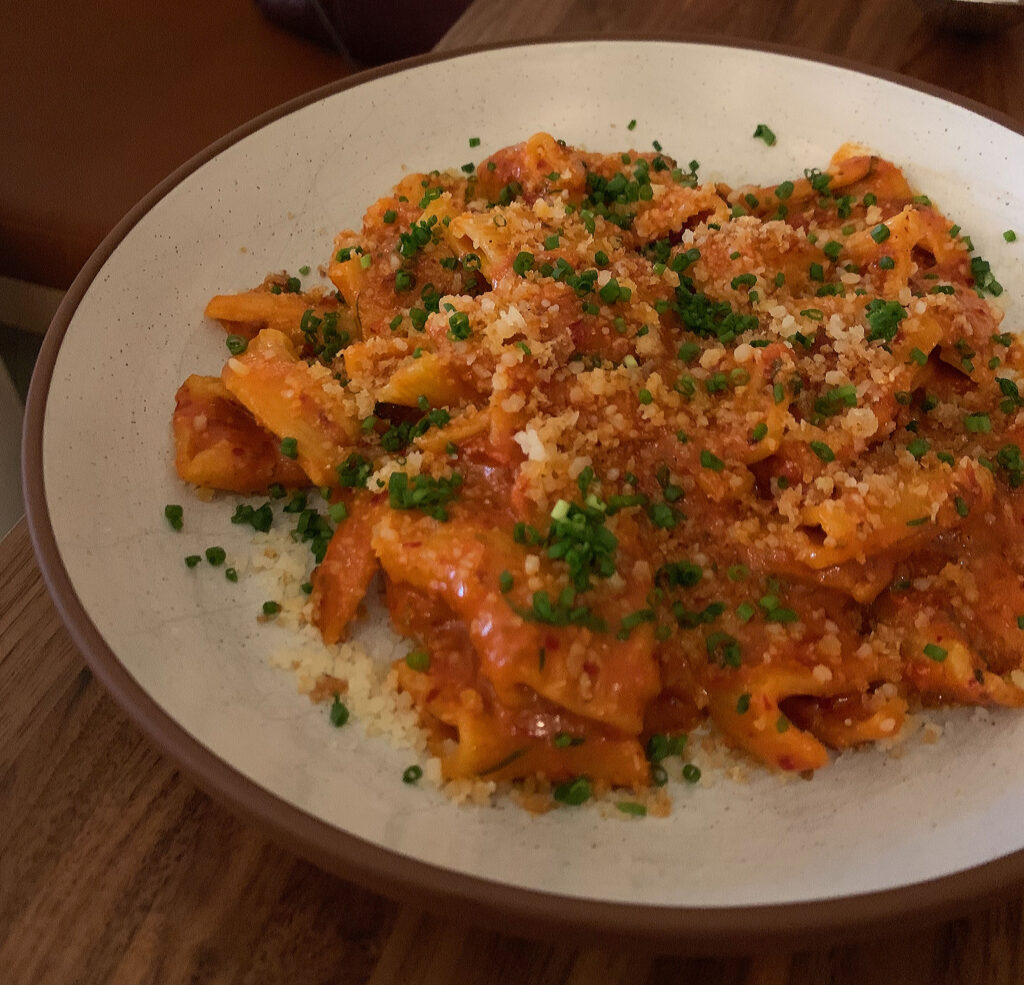
Unfortunately, the “Rigatoni” ($23), which you sampled in its early fall rendition, represents another step backward. These little “ridged” tubes should, in all honesty, be something of a sure thing. They are dressed in a sauce of fermented tomato then paired with ‘nduja (that spicy, spreadable Calabrian sausage) and oregano. Factor in a further topping of grated cheese, and you would be forgiven for thinking you were actually at your favorite Italian-American red sauce joint.
However, while the texture of the rigatoni is pleasant enough (perhaps falling just a bit short of a proper al dente), the character of the tomato is totally muted. You get a bit of acid, a bit of sweetness, a little funk, but no real depth or concentration. Likewise, the ‘nduja, oregano, and cheese have no discernible effect on the flavor composition either. It is hard to make sense of what is going on here, for the bowl seems like it would be absolutely brimming with character. You just do not think these tomatoes, treated in this manner, are up to the task of carrying such a heaping portion of pasta. All the other elements, as a consequence, get subsumed by its relative blandness.
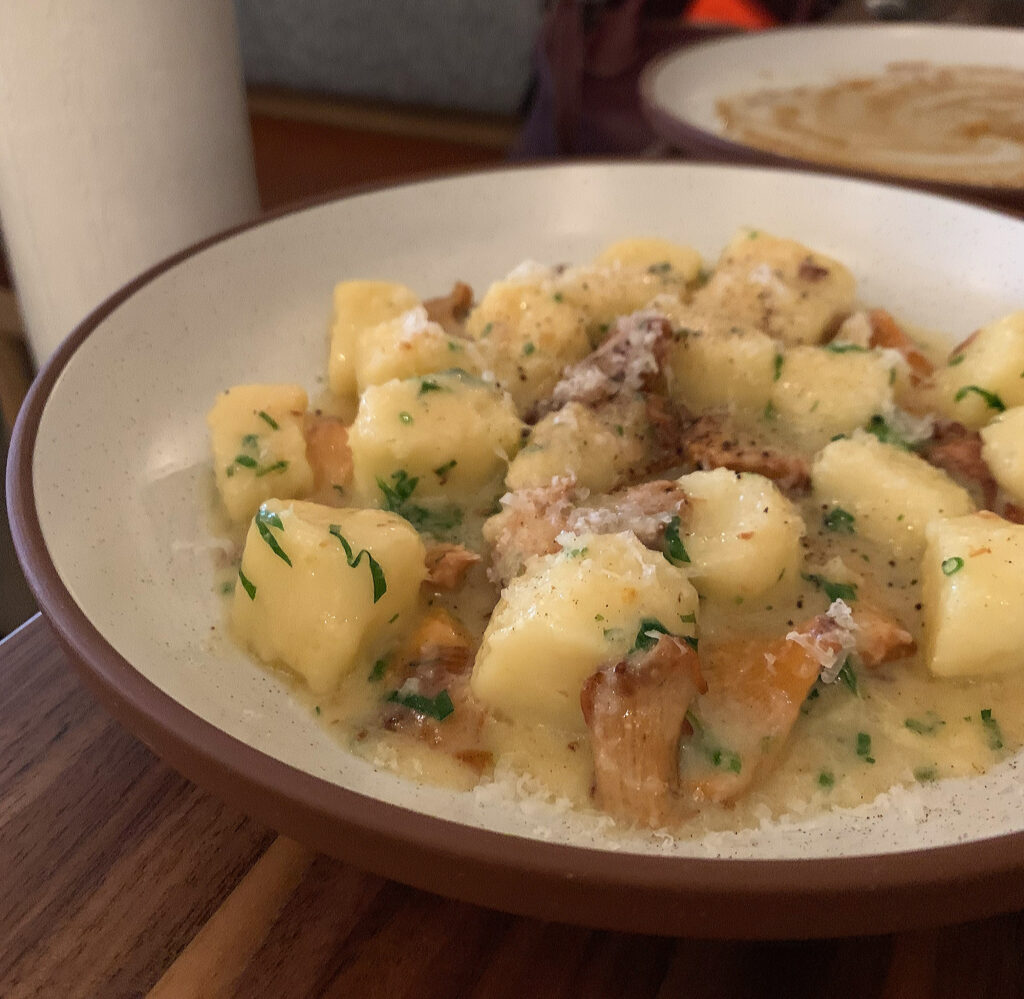
The most expensive of all the pastas offered on the menu is, without a doubt, the “Gnocchi” ($36). These little “knots” of potato owe their high price to the presence of chanterelle mushrooms in the dish. However, otherwise, it is rather classically conceived with a buttery sauce, some thyme, and a grating of parmigiano.
Gnocchi are commonly considered a kind of dumpling, and they, too, reflect Frillman’s mastery of the form. They are properly “pillowy” in a way that makes the “Pierogi” seem rather clunky by comparison, and their fleeting quality on the palate helps the meaty chanterelles really shine. In terms of flavor, the mushrooms’ earthiness is well balanced by nuttiness (also drawn from the parm) and a bit of sweetness. The dish is lightly salted but still displays a good undercurrent of umami. You think it needs just one more element to really pop, but the “Gnocchi” is—along with the “Stracci” (when executed properly) and “Agnolotti”—one of only a few successful preparations in this section of the menu.
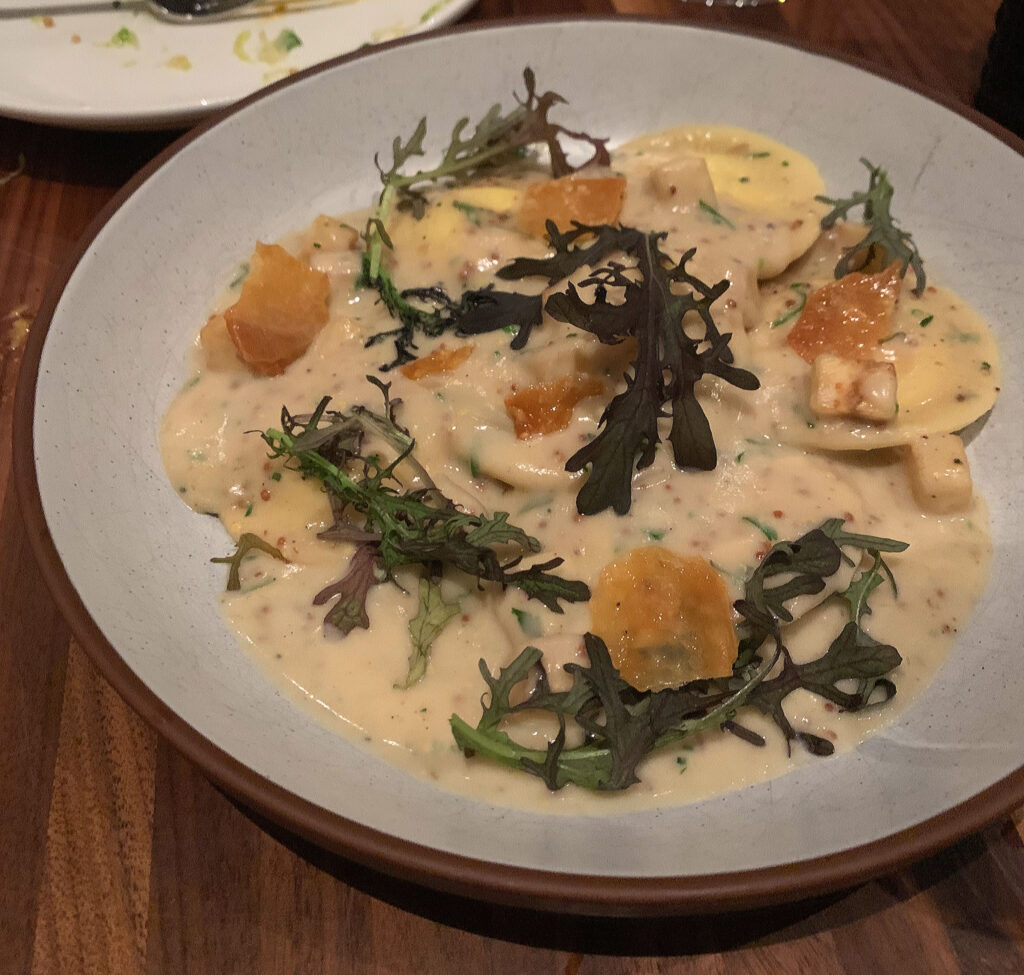
Last—and among the least—of the pastas served, are the “Ravioli” ($27). Frillman has been serving renditions of this form over the past few years, typically stuffing the pockets of dough with truffled ricotta. That continues to be the case here, along with some cubes of celery root and strips of chicken skin (a callback to the topping for the “extraordinarily satisfying” tajarin served back at opening in 2017).
On the palate, the chef’s talent with dumplings this time escapes him. The ravioli are too firm and, considering you are not given a knife, hard to manage. Their ricotta filling displays no discernible truffle flavor and, really, just no flavor at all. You appreciate the inventiveness of the chicken skin, but the resulting pieces look anemic and lack the crumbly crunch you are after. They also do not taste of anything, and—without truffle or chicken at the forefront—the whole dish just amounts to a bland bowl of cream and celery root. Despite being the second most expensive pasta offered, this is among the most disappointing.
Turning toward the “Proteins,” you encounter a category that drew some criticism when Daisies first opened but has also, slowly, expanded over time to now include some six different items. Though serving seafood and meat would seem to detract from the restaurant’s vegetable-forward focus, it also makes the menu feel more “serious” and helps to justify some of those heavier wines. It also provides Frillman with the chance to assert his personal culinary style with something other than salads and pasta.
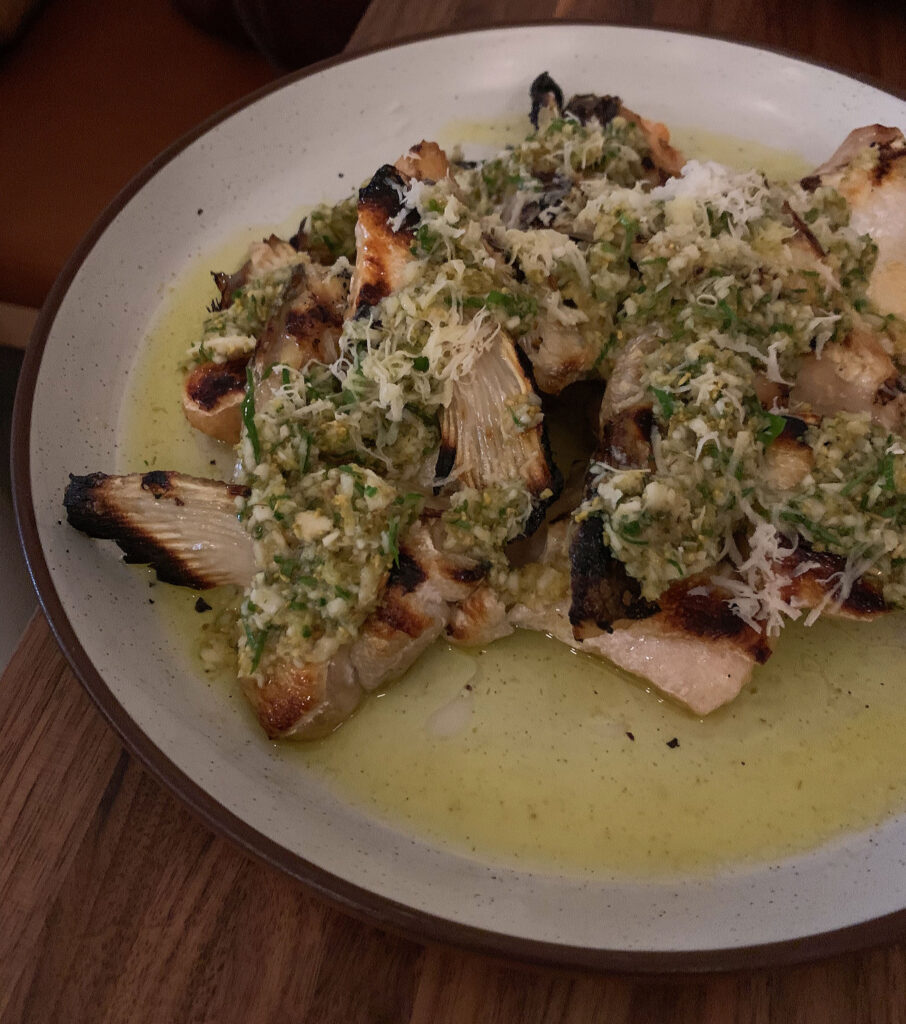
You begin with the “Salmon Collars (Bone-In)” ($19), a dish the Tribune said “seemed off” due to a “sulfurous note” but eventually excused because the critic’s parents ate the leftovers before they could taste it again. (For some reason, the resulting lesson was that they need to ask for them “well done” next time.)
For the price, you get a rather generous serving of six collars that arrive well charred and coated in a horseradish gremolata. It takes a bit of maneuvering to get around the bones, but you are rewarded with tender nuggets of salmon that, you must agree, could display a bit more crispness on the skin. However, while the fish is prepared well enough, the gremolata is a travesty. The sauce is straightforwardly herbaceous but lacks any depth of lemon and garlic. Even the horseradish is a total nonfactor. Rather than providing any uplifting pungency or savory foundation for the dish, the gremolata effectively makes every bite of salmon taste only of herbs and char. (Well, at least there’s no “sulfurous note.”) By the time you reached your second collar, this already felt like an absolute chore to eat.
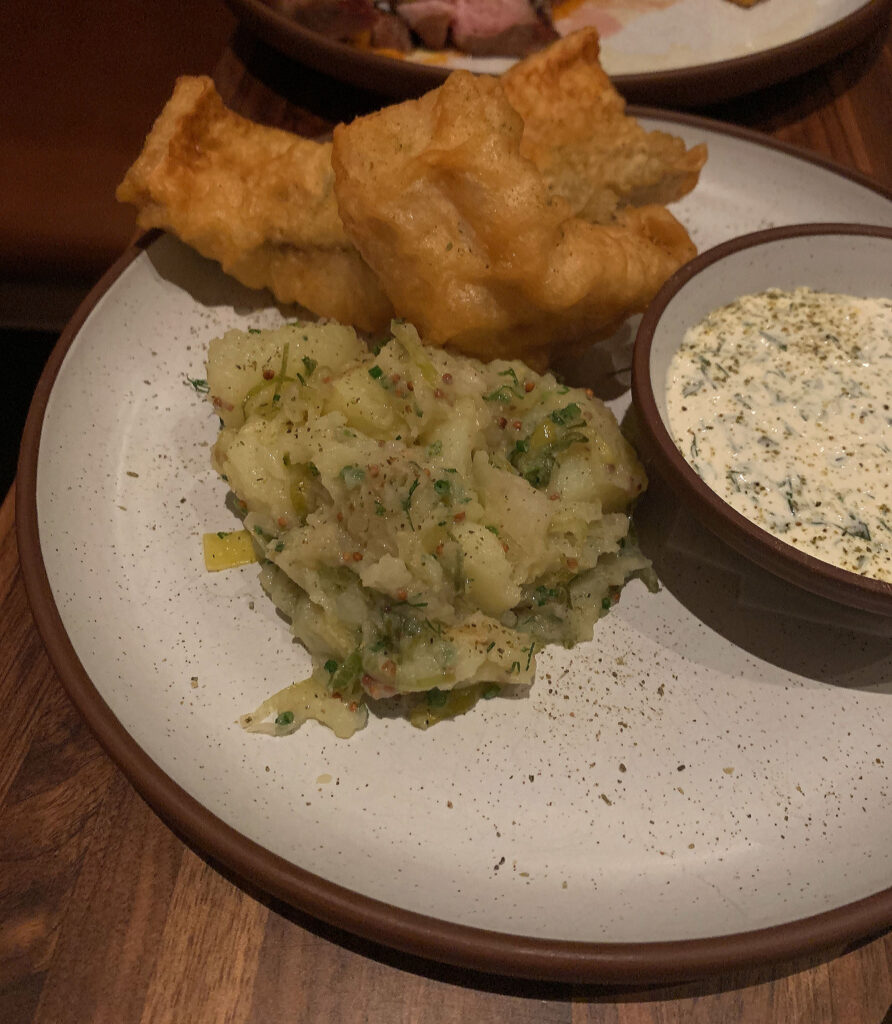
The “Fish Fry” ($19), described as something even a “red stater” or “bubba” would rave about, fares only a little bit better. The three pieces of fillet are not quite “mahogany-dark,” but they boast a crisp, airy shell. (For what it’s worth, an earlier version of the dish made with a crumb coating looks more appealing.) Taking a bite, the breading breaks apart cleanly but does not crunch or crackle all that impressively. Nonetheless, the flesh inside is moist and flaky.
The fish is served with an herby potato salad that, again, looked to be chunkier and more textural before but now is closer to a mash. An accompanying “tonnato sauce” really seems closer to a tartar sauce and lacks any perceivable flavor of tuna or anchovy. Given that this fried dish centers on a fairly bland protein, these sides are essential. However, both the potato salad and the sauce offer the same sour and dill notes. While certainly cleansing, neither element delivers the satisfying savory tones that the fish demands. This is another miss that, infuriatingly enough, looks like it used to be better executed.
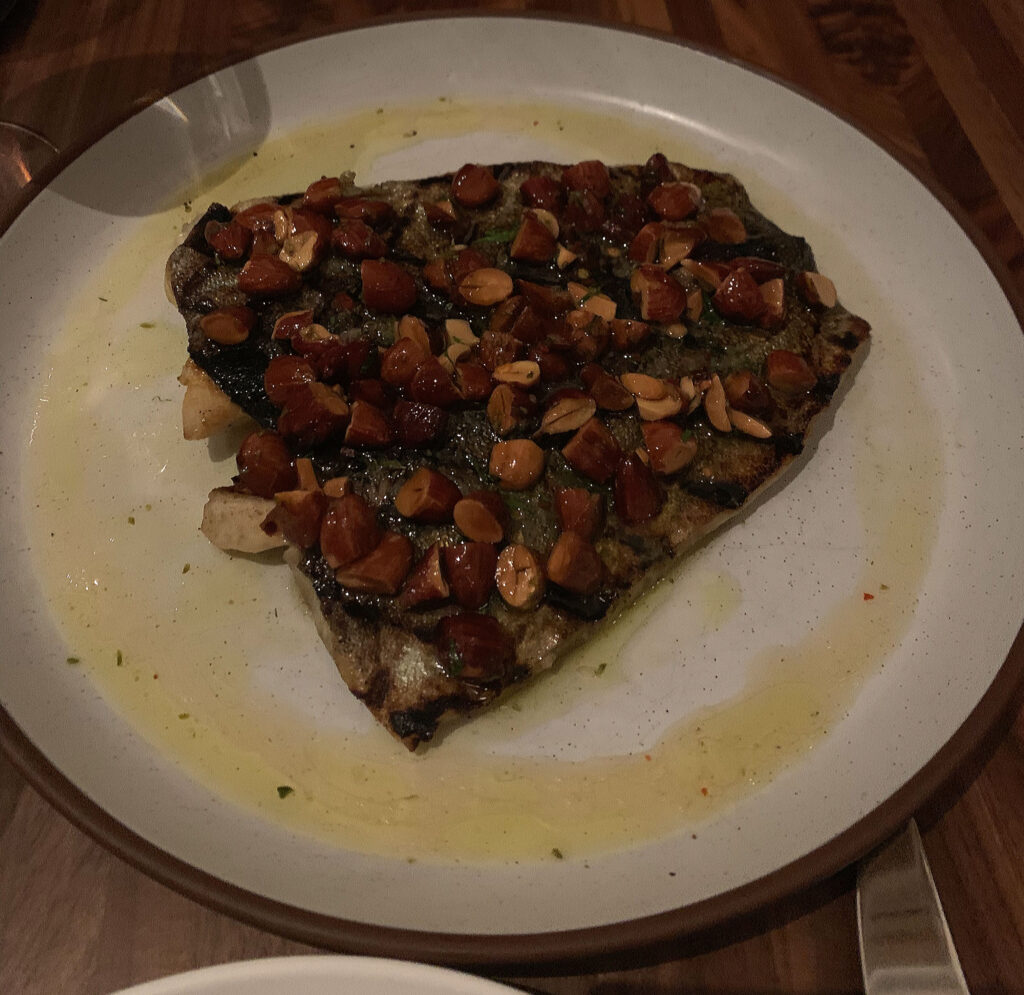
Yet another fish—the “Rainbow Trout” ($29)—offers a more premium seafood experience. It arrives at the table as a set of twin fillets with charred, crosshatched skin, a simple dressing of lemon and olive oil, and a so called “almond salmoriglio.” Though this refers to an herby, garlicky condiment from southern Italy, it here takes the form of many chunks of the titular nut being dispersed over the top of the fish.
On the palate, the trout is crisp on the outside then flaky and moist once you reach its interior. Its subtly nutty flavor is well matched by the almonds, but they are just a touch bitter and the size of the chunks a little too big and forceful in their crunch. Still, you like the dish’s flavor profile since it possesses some of the garlic and lemon you found missing from the “Salmon Collars.” Overall, the “Rainbow Trout” ranks as the third best of the “Proteins.”
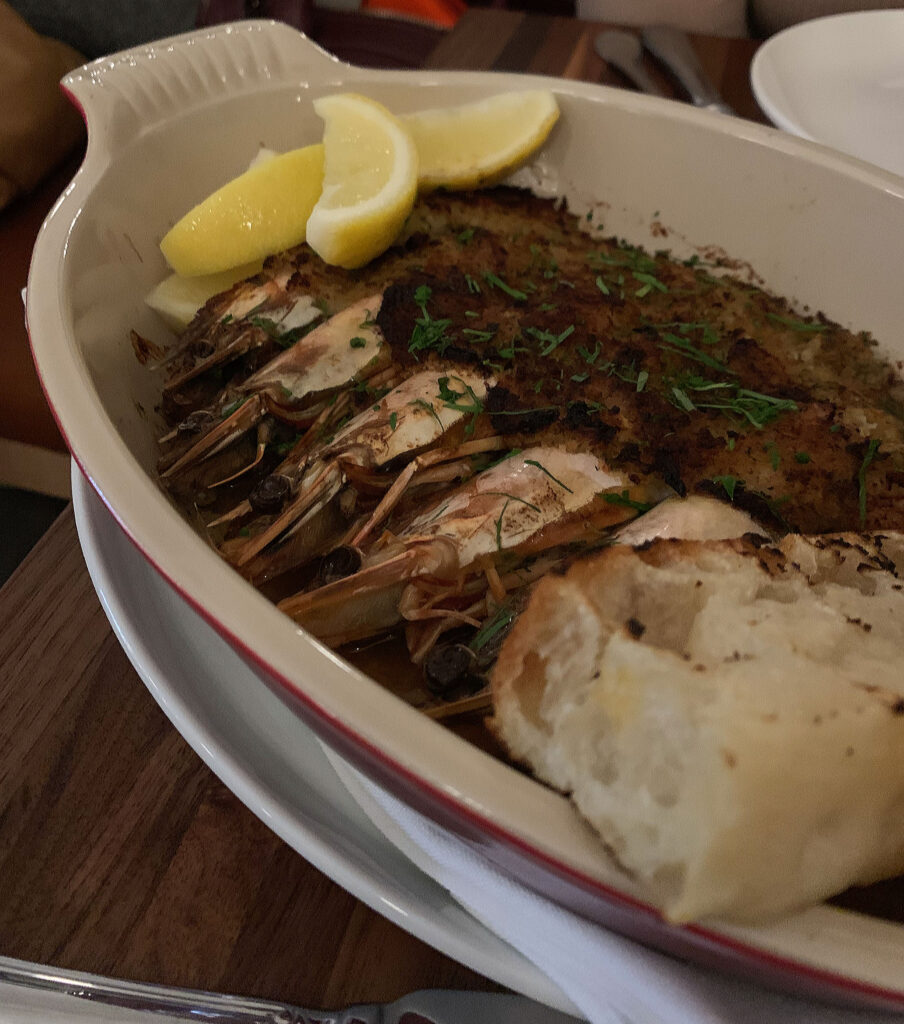
Next, in the “Prawns de Jonghe” ($52), you find both the menu’s most expensive item (save for those expired caviars) and a conscious ode to Chicago culinary history. Unfortunately, Frillman has concocted something that would surely set the De Jonghe brothers (Henri, Peter, and Charles) spinning in their graves.
$65 (when you factor in the 25%) gets you five prawns that arrive sitting pretty, with their heads on, in a cast-iron baking pan. The tails are dressed in garlic butter and coated in sherry-laced breadcrumbs while some wedges of lemon and a couple pieces of focaccia complete the presentation. Diving in, you slurp the juices from the prawn’s head and enjoy its rich, oceanic flavor. The meat from the tail is plump and tender enough and is helped along by the coating of garlic butter. However, the breadcrumbs are both soggy and flavorless. Yes, they’re supposed to be moistened, but the baking process has not—across two instances—rendered one single speck of them crisp. Thus, you are left eating expensive, buttery prawns coated in mush. Worse yet, on one occasion, the shellfish stunk of that “sulfurous note” the Tribune identified in the “Salmon Collars.” This represents a shameful butchering of a century-old recipe.
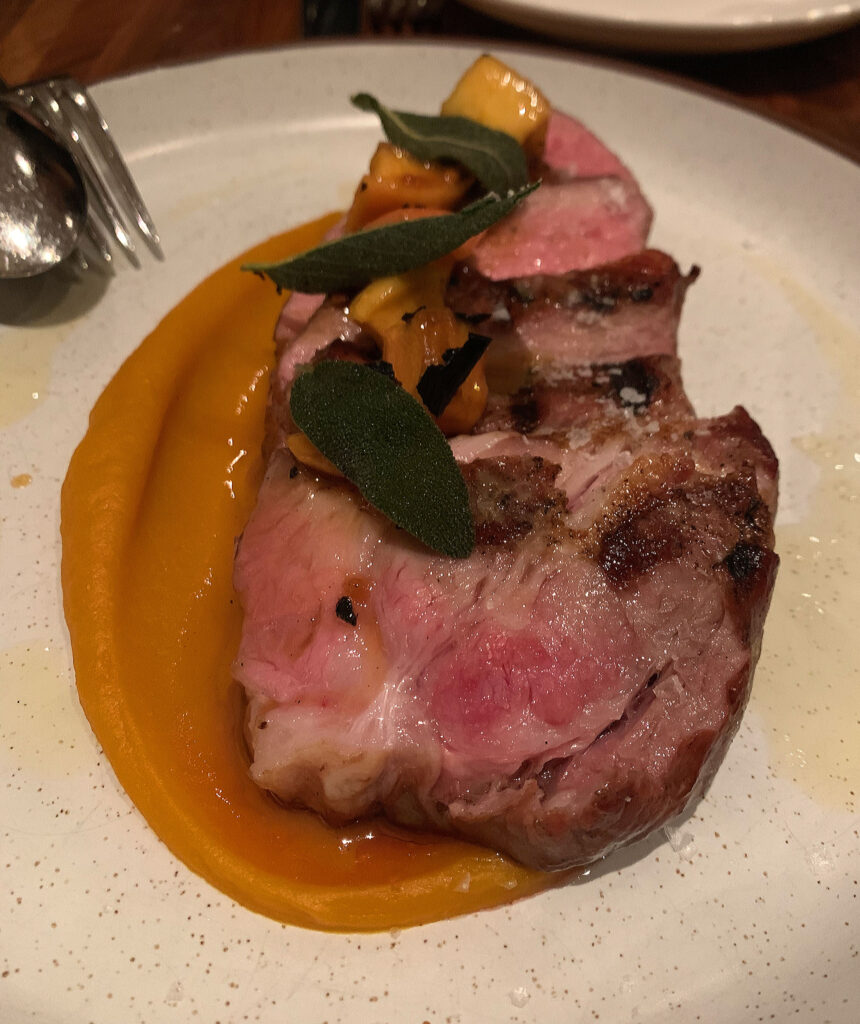
The real success of the “Proteins” section is undoubtedly the “Pork Collar.” The dish comprises five thick slices of the titular meat set atop a butternut squash purée then topped with a charred apple mostarda and some sage.
On the palate, the pork is tender and juicy with perfectly rendered pockets of fat. Its latent sweetness is accentuated by the smooth squash and sent into the stratosphere by the apple mostarda, which imbues the meat with a deep, apple pie-like flavor. Still, thanks to the sage and some flaky salt, this certainly remains a satisfying, savory dish. It makes many of Frillman’s other creations seem needlessly fussy and stands as one of only two items in this category you can possibly recommend.
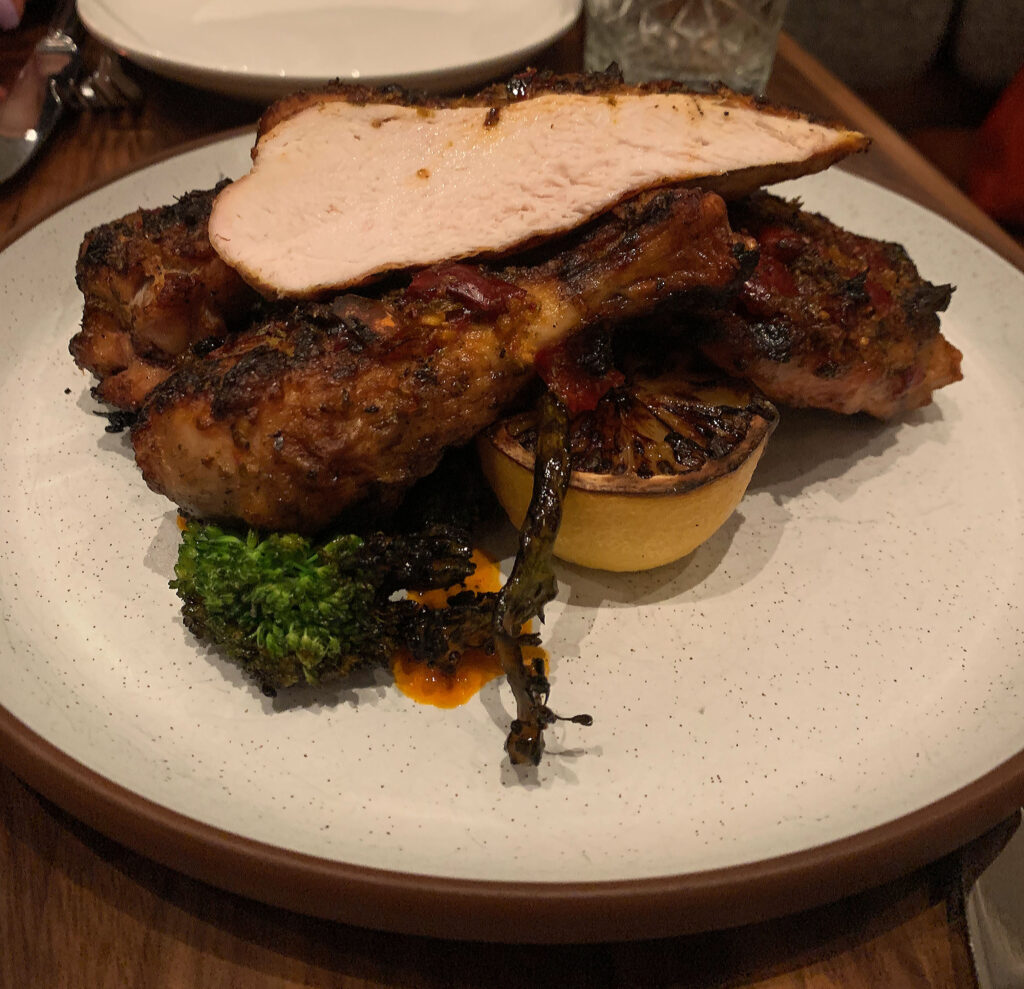
To that point, the “Grilled 1/2 Chicken” ($26) is also a modest success. Requiring, as the menu discloses, 60 minutes to prepare, the bird is cooked until crisp with herbs and small strips of onion embedded in the resulting crust. The chicken then arrives perched atop a charred lemon along with some stalks of broccolini that have been dressed with Calabrian chili oil.
With a squeeze of the lemon (and some wetnaps provided to clean up after), you dive in. The chicken’s crust is faintly crispy and marked by some mild bitter notes of char. Nonetheless, the interior of the meat—even when it comes to the breast—is beautifully juicy. The broccolini, meanwhile, offers a good contrasting crunch. And the overall mix of flavors—a little spicy, a little sour, a bit smoky, and supported by sweet, vegetal notes—is balanced and satisfying. You even get a bit of a “Chicken Vesuvio” character from the preparation, which is one of only nine savory dishes across the entire menu you would recommend.
Now, at last, you come to the “Desserts” and to Omilinsky’s kingdom. Though the pastry chef has won praise for the pastries she serves during the restaurant’s morning café service, you will focus solely on what is offered at dinner.
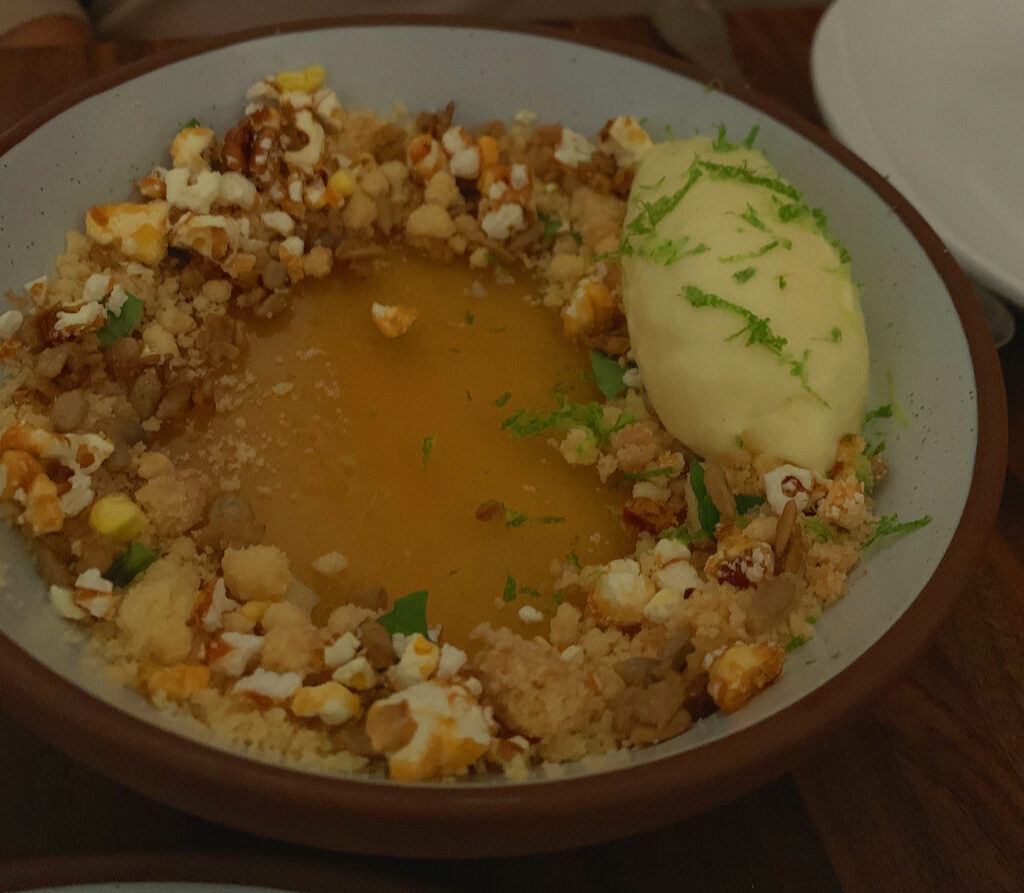
Of these, you sampled a “Panna Cotta” ($13) first. In this case, the “cooked cream” is flavored with sweet corn, capped with a maple gelée, and paired with a popcorn ice cream. It then comes topped with bits of popcorn, caramel corn, and candied sunflower seeds. On the palate, the panna cotta is a bit more gummy than it is creamy; however, the dessert does display a good depth of corn flavor that lasts through a moderate finish. While the combination of popcorn ice cream with actual popcorn is playful enough, the salty-sweet tones—plus nutty-sweet sunflower seeds, plus caramelly maple—almost feel overbearing. You would rather have the panna cotta show a greater concentration of corn than rely on so many other toppings to build a sense of decadence. In sum, this is an okay dish that ranks at the bottom of the desserts you have tried.
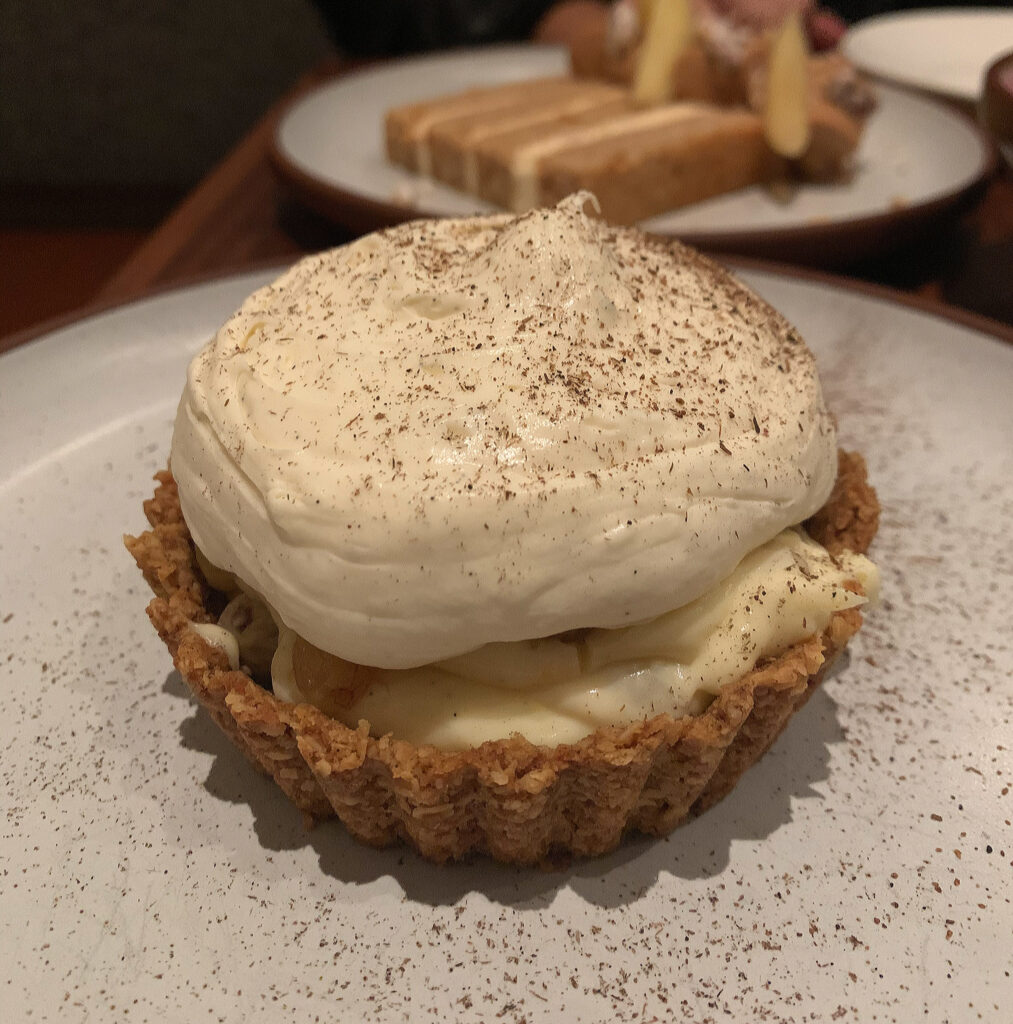
A “Sour Cream Pie” ($13), which came to replace the “Panna Cotta,” fared only slightly better. The dish comprises a cute, tartlet-like oatmeal cookie crust lined with sour cream filling, studded with whiskey raisins, and topped with a mascarpone cream dusted with burnt cinnamon. Using your spoon, you crack through the outer edge of the pie and retrieve a complete bite. On your palate, the crust crunches pleasingly and yields to the creamy layers of sour cream and mascarpone. They display a subtle tang and sweetness with a smoky, almost chocolatey note drawn from the burnt cinnamon. However, the texture of the whiskey raisins is a bit unpleasant. Overall, this is a decent, understated item that could become great with some more tweaking.
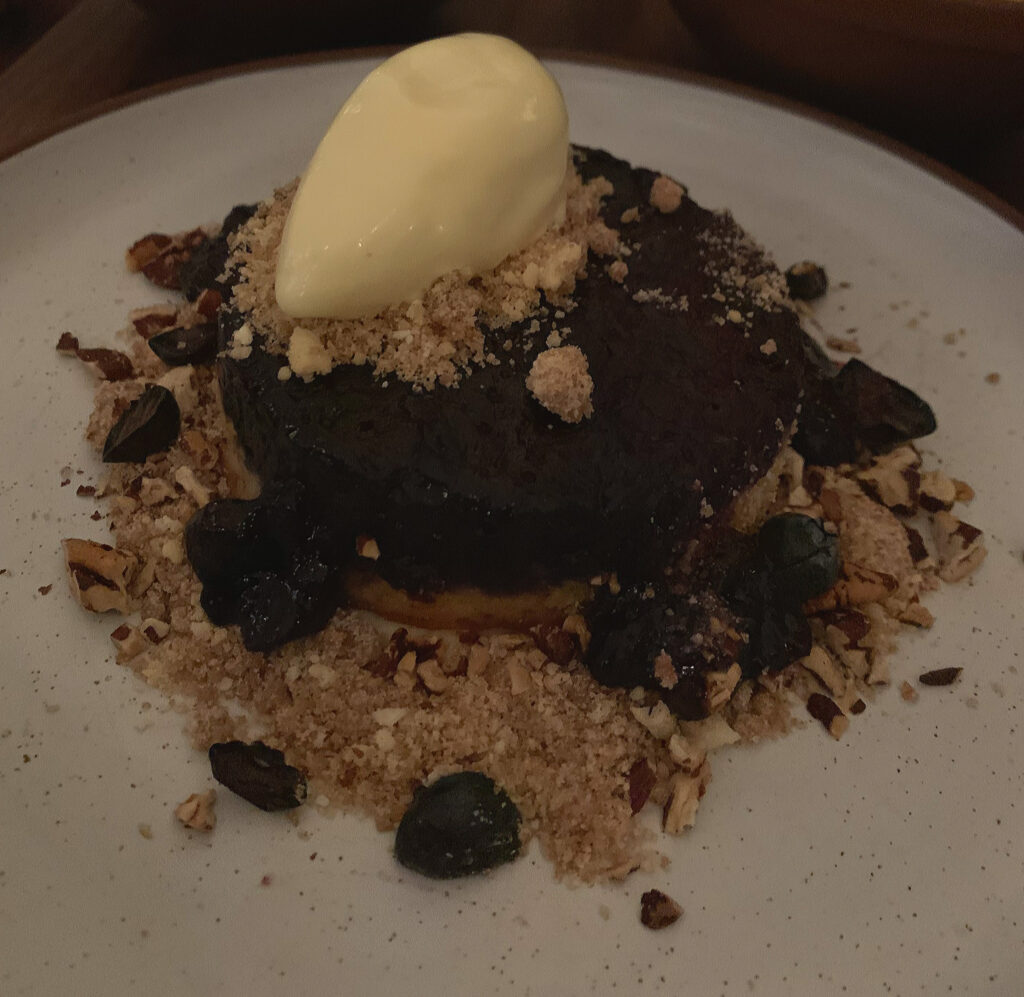
Next, you come to the “Blueberry Brown Sugar Cake” ($13), which you appreciate from the get-go for its more straightforward focus on fruit. The dessert comprises a circular segment of crumb capped with a layer of gelée made from the titular berries. It comes topped with a bay leaf ice cream while some pieces of pecan and a toasted milk crumb are strewn across the plate. Though the use of brown sugar does not make for a particularly fluffy texture, the cake melds well with the fine crunch of the nuts and sees itself moistened by the blueberries. This ensures that the fruit’s flavor takes center stage and, balanced by the rich notes of molasses and uplifting character of the bay leaf, still feels satisfying. This feels more cohesive that the two preceding dishes and, in fact, is rather nice.
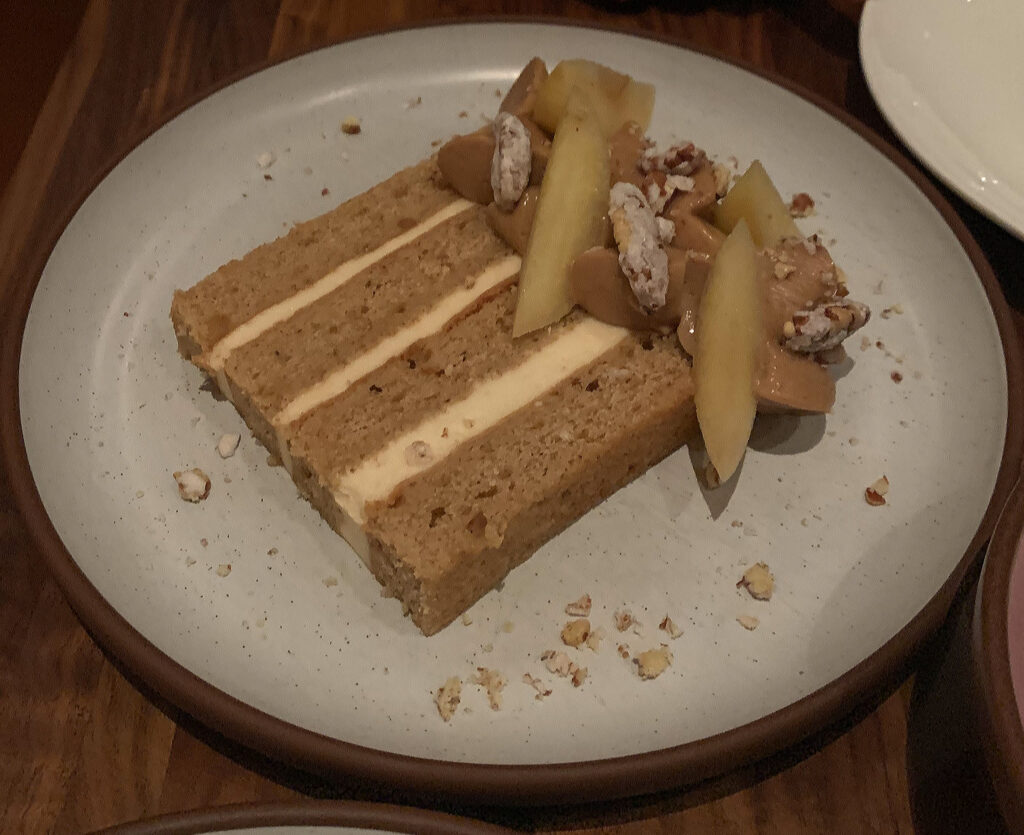
Even better is the “Apple Cider Donut Cake” ($13), which has served as a replacement for the blueberry-brown sugar combination. The dessert comprises a sizable slice of layer cake boasting three inner reservoirs of apple cider mousse. It is then topped with rum-poached apples and a pecan praline. Diving in, you appreciate the rich, moist texture of the cake’s crumb and its depth of apple flavor. There’s a tinge of spice to add some complexity, along with harmonizing nutty and vanilla/caramel notes from the pecan and rum respectively. Though deceptively simple, this dish strikes you with the fullness and length of its flavor. It represents a true ode to the fall season and one of Omilinsky’s best creations.
Equally as strong is the “Warm Graham Cracker Crostata” ($13), which comprises a beautifully puffed and crusty croissant-like shell dusted with powdered sugar, drizzled with espresso caramel, and topped with a white coffee ice cream. Using your spoon, the surface of the crostata is a joy to break apart. This allows the ice cream to melt into the treat’s warm center while the caramel is also distributed through the crumb. Upon reaching your palate, the resulting texture is crusty and fluffy and moistened with dairy. Meanwhile, each bite displays a flavor that is honeyed and nutty with a nice undercurrent of caramel mocha. You are not quite sure your mind goes to “graham cracker”—and you also might like a bit more ice cream—but this is brilliant. Well done!

Beyond the plated “Desserts,” the pastry chef also offers a selection of seven “Treats” (each priced at $4). These are the much-vaunted “Midwestern mignardises” referenced by the critics, and you sampled all of them. A soft, creamy “Strawberry Kołaczki” and a warm, delectably salty “Chocolate Chip Cookie” are the best of the bunch. The remainder—a “Chocolate Bread Pudding,” “Peanut Butter Crunch Bar,” “Oatmeal Cream Pie,” “Raspberry-Pretzel Pie,” and “Gooey Butter Cake”—are fairly average.
Certainly, you can appreciate the charm of getting to try so many smaller sweet bites covering a wide range of tastes. However, you think this format also devolves into a kind of “throwing everything at the wall and seeing what sticks.” Separated from the shock and awe that comes about from ordering several at once, most of these “Treats” would not be able to stand alone in the pastry case or as, say, an actual mignardise anchoring a tasting menu.
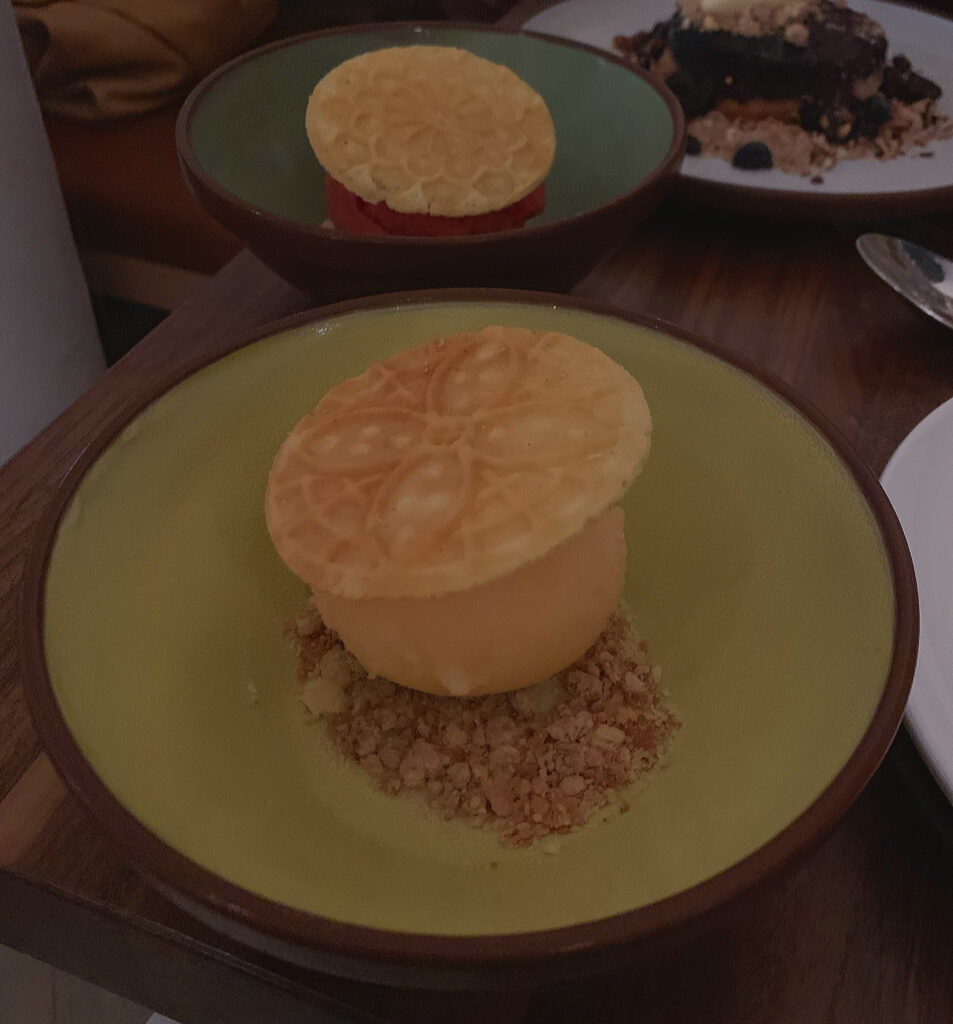
Though Daisies also offers a selection of “Gelatos & Sorbettos [sic]” ($5 each, three for $14)—and a couple flavors have been given to you as freebies—they have failed to make much of an impression. (The accompanying pizzelle, too, is nothing to write home about.)
With that, you reach the end of your meal, and, upon bringing your check, the server is extra careful to call the 25% service charge to your attention (also noted with a paper insert) and field any additional questions you might have. Really, when you compare it to the city’s other hottest properties (serving steak or set menus), Daisies has never given you sticker shock even when factoring in that extra premium. Save for the caviar supplement, the prawns, and a handful of wines that clock in over $100, there are not many items to blow a big sum on.
In that respect, the restaurant really does embody a “neighborhood place.” Daisies “2.0” serves so many functions—morning, noon, and night—you almost wish you lived within a few blocks of it. It might never be your absolute favorite, but it could be a valuable “third place.” However, scanning the packed dining room as you make your way toward the door, you wonder how many diners are from the immediate community and how many have traveled from further afield in search of “the best restaurant in Chicago.”
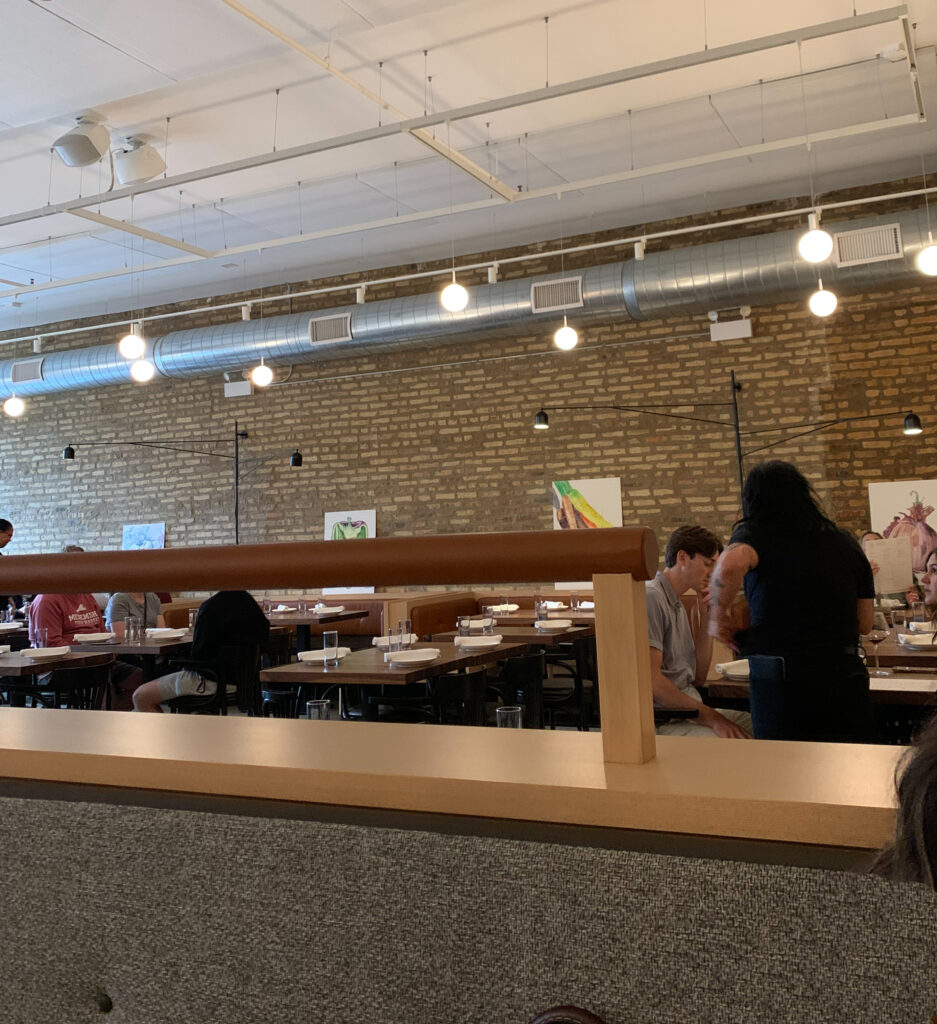
In Daisies “2.0,” you undoubtedly find a place with some virtues. The restaurant offers a sleek, expansive space to work and drink coffee in during the day. There are also expertly made pastries and unique sandwiches at the ready to fuel locals as they go about their quotidian duties. In the evening, chips and cheese curds and a dozen types of pasta wait ready to comfort you (along with a cocktail or glass of natural wine) after work. Frillman leavens these practical features with a unique concern for local farming, food waste, and labor practices. The result being: Daisies is an everyday place for conscientious consumption, a restaurant you can feel good about supporting time and time again.
This is the surface narrative proffered by Daisies, and its chef-proprietor has done an expert job couching it within a larger story of growth. The transition from “1.0” to “2.0” preserved certain valuable threads, like the vertical integration with Frillman Farms and that “if the Midwest was a region of Italy” ethos. However, it also further fleshed out the concept through Omilinsky’s partnership as pastry chef (an effective doubling of the kitchen’s creative firepower) and the infamous 25% service charge, which solidified the restaurant’s commitment to fair compensation. The menu, foundationally, would also be expanded (in line with the bigger space and a new kitchen) while the old location would transform into a “permanent market, café, and bar” (affirming Frillman’s commitment to the community).
With a new building, a more robust value proposition, and a few other consequential changes (when it comes talent as well as the stewardship thereof) to tout, Daisies “2.0” seemed destined to please critics who were already charmed by “1.0.” Everything, no doubt, was bigger and better. Old favorites mingled with new intrigues, and that 25% service charge would form the perfect hook: a controversial but altruistic practice set to capture headlines. In truth, it was set to tickle journalists who view themselves primarily as advocates for the reinvention of the industry rather than consumer interests. They, alongside Frillman, get to play the hero, leading the masses toward the realization of social change. They are no longer just that despicable specimen known as a “food writer,” but a self-satisfied activist gleefully collecting backslaps from fellow travelers in more fashionable, “cultured” cities.
In truth, you are not averse to the cause these people fight for. Those with soapboxes have a responsibility to fight for the voiceless. Yet, when a critic fails in their duty to consumers while simultaneously treating them as political pawns, they transform into a mere shill. You can speak of the baseline unprofessionalism of rating a restaurant on the basis of only one or two visits. You might mention the reviews that were rushed to print less than two months after Daisies “2.0” opened. You can cite tribalistic references to “red staters” or clumsy attempts to defuse criticism that the 25% service charge should be built into the menu pricing (because “that rarely, if ever, works”).
You have already noted that Daisies’s service, while warm and friendly (when the staff is not overwhelmed), is not superlative enough to justify what amounts to a 25% “tip” (however the sum is ultimately used). Judging by the experiences of your surrounding tables—and the barrage of freebies used as a panacea for poor performance—you do not think Frillman’s team would even earn a 20% gratuity from many parties.
The reality is that Daisies’s hospitality, for all the fuss, is decidedly average. The servers do not care or express themselves any more than is standard (save for gushing about Frillman Farms or defending the service charge itself). In fact, they fall victim to the same mistakes (the kind you might expect at a median establishment) as everyone else. The bussers hustle, but they, too, are far from perfect (and some proportion of them do not look like they want to be there). The managers and the chef-proprietor himself do a lot of running around—are unafraid to engage in menial tasks—but do not act as proper hosts.
Perhaps these failings cannot be blamed on the service charge experiment itself but, rather, have something to do with understaffing or a lack of training. Still, they puncture the rosy picture some critics have tried hard to paint. Seeing these journalists try to head off criticism of the 25% fee—when, on the ground, service barely rises above competent—is despicable. It amounts to consumers being told to sit there and suffer so the wannabee activist can feel they have made a difference.
All that being said, while the service charge formed an easy headline to run with, it is really not something you take issue with in isolation. Even the service, to be honest, is not so offensively bad that you could not stomach paying 25% if everything else hit the mark. The most damning case against Daisies, in truth, comes down to its food.
Of 36 dishes you sampled across four visits, you can only recommend 11 of them: the “Potted Carrots,” “Sweet Onions,” “Squash Salad,” “Porchetta di Testa,” “Tripe,” “Agnolotti,” “Gnocchi,” “Pork Collar,” “Grilled 1/2 Chicken,” “Apple Cider Donut Cake,” and “Warm Graham Cracker Crostata.” This means more than two-thirds of the restaurant’s menu is below par and more than 80% of its pastas—the undeniable focus of the concept—are not up to snuff.
You also must admit—if dishes like the “Radish” are any indication—Frillman Farms produce is not anything special. Brother Tim’s ingredients really only shine, as with “The Overpriced Tomato,” when loaded with bone marrow, salt, and vinegar. Perhaps there’s a good reason Balena stopped buying from Frillman Farms once Brother Joe left. And perhaps “supporting small farmers” is just a way of making vertical integration (to say nothing of nepotism) sound more tasteful.
Going back to pasta, you have to note how many of Frillman’s dishes feature noodles that stick together and that come coated in something closer to flavorless soup than a sauce. The drop-off in the quality of these dishes from your first to your second, third, and fourth visits was stark. Did something happen with staffing? Is the restaurant really just too busy for its own good? Frillman is certainly not slowing things down—and, from your observations, he’s not actually tasting his food before it goes out—so bad pasta seems to be the rule. (When it comes to that “if the Midwest was a region of Italy, what would the food look like?” question, you are unsure to whom the chef is being more insulting with his work.)
And, worst of all, how can you forget the seafood. It is easy to wave away the deceptive labelling of the beluga hybrid caviar as “Beluga,” for that is more or less a victimless crime. However, Daisies has clearly demonstrated a pattern of mismanaging its ingredients: mushy, 10-week-old caviar (served to you on two occasions), sandy mussels, and malodorous prawns.
It’s a shame, for the Tribune clearly noted a “sulfurous note” in the “Salmon Collars” but decided to explain it away rather than take Frillman to task. (No doubt, that would be a fly in the ointment when trying to champion the service charge.) If and when someone gets sick from Frillman’s food (anecdotally, you sat next to one local chef who reported feeling sick the next day), the publication and its “critic” will be as much to blame as the kitchen’s own poor hygiene.
Given, in terms of pacing, storage, and execution of the food, that the kitchen is to blame for so many of the concept’s problems, the 25% service charge now seems particularly egregious. As you said earlier, assessing this fee instead of baking it into the menu pricing (pricing, you should mention, that has continually gone up on many items throughout the year) shifts consumer expectations toward the front-of-house staff instead of the cooks. It provides Frillman with a competitive advantage when it comes to getting customers in the door but allows him to spin the premium they eventually pay as relating to the service rendered rather than the quality of the food. When it comes to some of the restaurant’s very worst items—the caviar supplement or the “Prawns de Jonghe”—adding 25% later on (on top of an already-high price) is an insult. It amounts to a foot-in-the-door technique used to move spoiled product.
In the final analysis, you are not punishing Daisies for being a critical darling so much as you are for believing in its own hype. Likewise, you do not believe Frillman is an irredeemably bad chef—just one who saw, in championing social change, a shortcut to success. Certainly, the media hacks played their part to perfection, and the restaurant, as a business, will succeed for the foreseeable future. Pasta, in an age where carbohydrates are increasingly viewed as a special treat, will always be predisposed to please. But, despite its fancy new setting and fashionable philosophy, Daisies—on any given night—puts out some horrendous food. For a 25% premium, Frillman serves dishes that not only disgust you but may very well make you sick. With the chef-proprietor high on his own farts, it is uncertain when or if the foundations of consistent, quality cooking and service will ever be established.
In the meantime, Daisies will reap the rewards of an influencer class that, trying one or two dishes at a time, gives a warped view of what’s going on. They can tell when a concept has been anointed and so desperately want just a bit of that fame reflected back onto them. After all, there is no reward for swimming against the current. How do you even begin to articulate some thoughtful criticism when posting a few pretty pictures—keeping the ruse going—yields greater personal gain?
Meanwhile, the unwashed masses—forever insecure in their taste—mimetically follow the newspapers, magazines, and follower counts to their doom. There are, to be clear, some dissenters. But most people are content to sit and eat their chips and cheese curds in a room they have been told is a national destination—to be seen doing so until the next venue for their vanity is announced by the powers that be.
The predetermination and utter fabrication of Daisies’s success feels like a pivotal moment in the fight for the soul of Chicago dining. In some sense, it is no surprise: as legacy media circles the drain and its critics can no longer afford to do their due diligence, they grasp onto the most digestible nuggets of a given restaurant’s identity and hyperbolize them. They put the careful determination of quality aside so that they can glorify themselves, along with their favored subjects, as harbingers of a better industry. Yet, doing so, they devalue the quiet pursuit of excellence that undergirds the craft of hospitality. They transform restaurants into yet another arena for the expression of self-promoting ideology rather than quiet, careful self-discovery. They privilege social engineering over the pursuit of truth, and there is nothing more despicable when it comes to matters of taste.
Daisies is not a good restaurant, nor is it a good business. It is a concept that has been diabolically conceived to tickle the sensibilities of a certain demographic of diners and to use those figures as a fulcrum for the deception of the wider public. You must admire the genius of this plan, and you can only feel dread now that it has so successfully come to fruition.
Will this be the blueprint for the future of the dining scene? Will eating as an expression of personal virtue overshadow eating as the appreciation craft? Surely, these two dimensions can coexist and even complement each other. Yet, here, the former obscures the latter and even goes so far as to debase it.
For, while Daisies has a few redeeming qualities, it comes up despicably short in those most essential categories. Frillman, for all his good intentions, has built one of those few establishments you actually revile due to the shared delusion it perpetuates.
Well, it is now time to wake up and reject those restaurants that make their name in the press rather than at the table and behind the stove. Chicago, at this inflection point, cannot afford to perpetuate such a cynical representation of Midwestern cuisine. Doing so would surrender the definition of its terroir to those who understand and respect it least. It would herald in the kind of hyperreality—the triumph of symbol over substance—that has come to define other major metropolises, and it would negate what makes this city most unique.
